


Entering Teotihuacan, a mysterious and massive ancient city that predates the Toltecs, the Maya and the Aztecs in Central Mexico, the Avenue of the Dead stretches out far across the valley. Following the Avenue leads you on a long, rocky journey to the Pyramid of the Moon, hazy off in the distance.
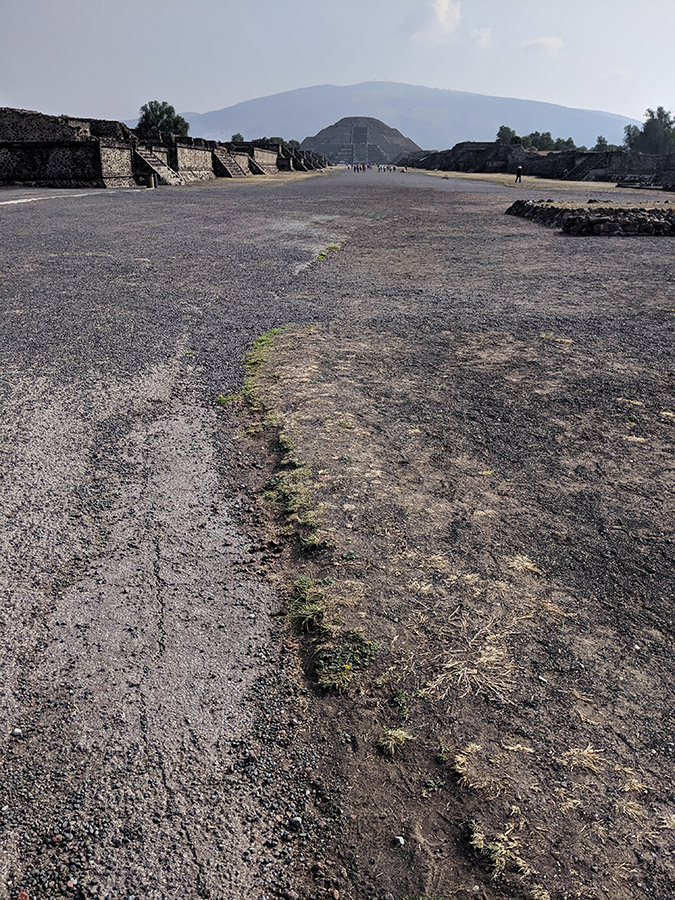
Part of the magic of Teotihuacan is that no one is sure who build it. A long-forgotten people? Aliens? Bob Vila? The later Mesoamerican cultures who lived here all believed it had been left behind by the gods.
I had arrived in the morning right as the gates opened, so the site was not yet thronged with tourists, and the vendors hadn’t even finished spreading their bullshit out on blankets. Not yet warmed up, they only half-heartedly hassled me as I walked by. Gracias, no. Gracias, no. By the end of the day I would wish I had this printed on a tee-shirt, to save my voice. By the end of the trip I wanted a shirt that said I AM HERE TO BUY NOTHING AND NEITHER AM I IN NEED OF A TAXI BLESS YOU in several languages.
The sound of a flute echoed through the empty courtyard eerily as the morning light filtered through the clouds. Nice, Mexico.
I was making a bee-line for the site’s main attraction, the Pyramid of the Sun. I wanted to climb the pyramid and have a few moments alone at the top to meditate before the rest of the tourists started parachuting in, pouring out of Higgins boats on the beachhead and clawing up through the soil like the living dead. I was paying for this privilege in pain, having rushed straight from work to the airport on Friday night, onto a plane that arrived in Mexico City at 1am, taxied to my spartan hostel for a quick nap and then onto the 6am bus rambling north out of the city.
The Pyramid of the Sun is one of those strange objects that just doesn’t look as impressive in photos as it does in real life, no matter how close or far away you are, or what angle you take your photo from. It’s very nearly the size of the Great Pyramid in Egypt, and breathtaking to stand in front of. The closest I came to capturing this was a selfie I took later in the day, when the tourists were carpeting the pyramid like hair plugs.
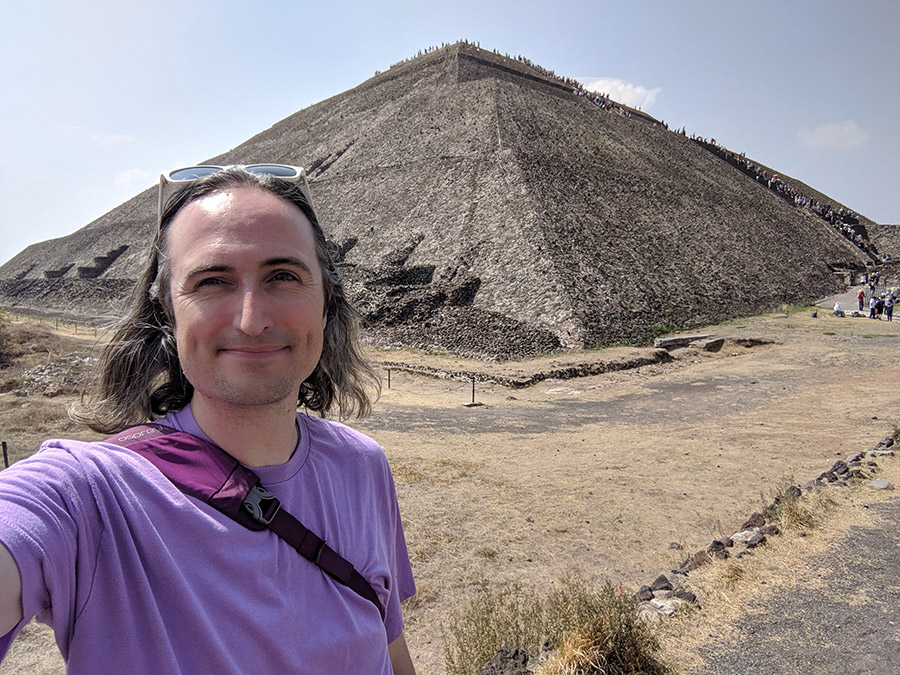
A few people had beat me there, as they weren’t riding a bus that dropped them off at the absolute opposite end of the massive complex. Everyone wheezed as we climbed the pyramid’s innumerable steps at the poorly-named “Valley of Mexico”’s 7,200 foot elevation.
“Man, this is killer! Good thing we didn’t try this the first day we got here, I needed a few days to acclimate to the altitude!” some fuzzy, blurry guy exclaimed loudly, not realizing I had been at altitude for a grand total of six hours and he was well within my barf radius.
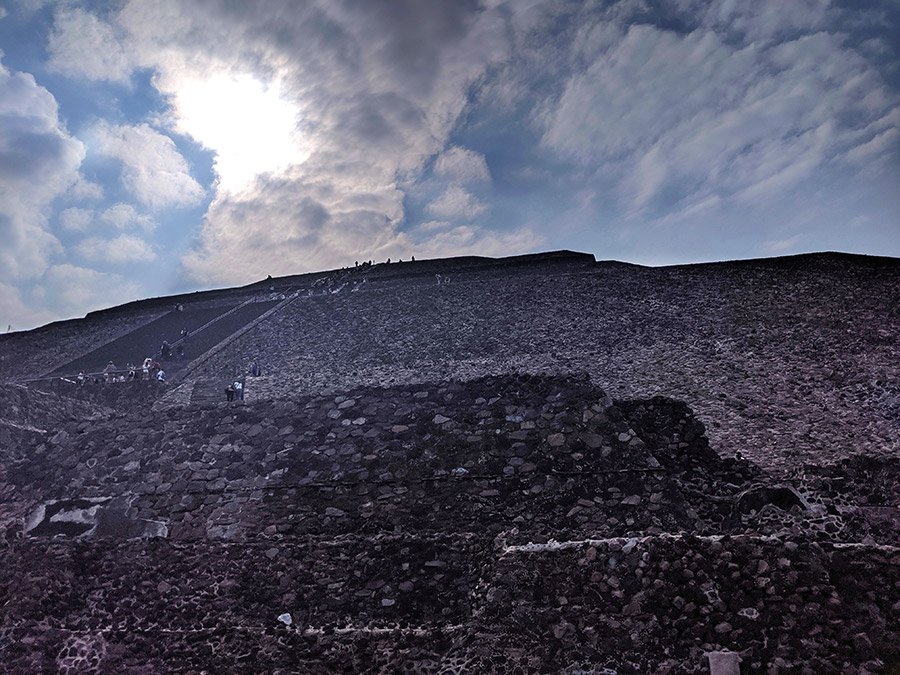
The crowd thinned out the higher we climbed, as people fell out to reconsider their life choices and drool on their shoes.
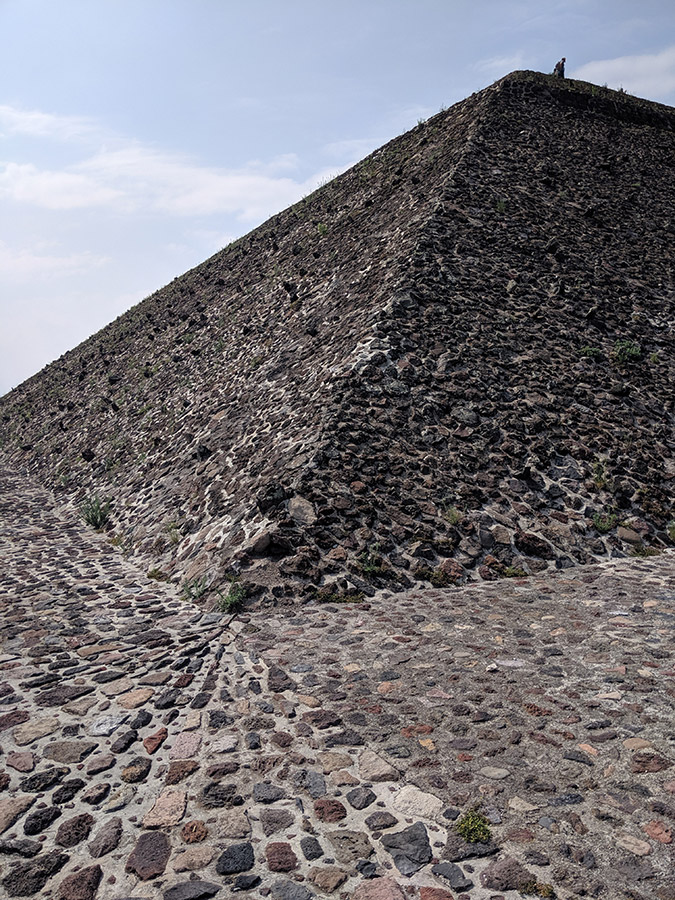
Up top, I didn’t exactly have the pinnacle to myself, but it was solitary enough for me to get a decent little meditation in. I looked out across the long, flat valley. Hmm, I guess this is my year of pyramids. I’d always been curious about these structures in Central America. Who actually built them? Is there any connection to the pyramids in Egypt? Do they have an energetic purpose or are they just ceremonial structures? I closed my eyes.
I projected my consciousness down into the pyramid below me and could feel various different chambers and passageways within it. Though I had no outer concept or confirmation at the time, I would later learn that there are in fact tunnels and chambers within and beneath the pyramid, closed to the public, which are thought to be either tombs or sacred ceremonial sites. Opening my awareness as much as I could in the thin morning air, I tuned out the mundane conversations beginning to spring up around me and tried to tune in to just the pyramid itself. I felt an energy swirling down below me, but it was very faint.
Is it me? Am I too tired or distracted? Has whatever energy that was here been dissipated by millions of tourists stomping around up here over the decades?
Or was the vibration here just never particularly high in the first place?
If you explore the idea that certain ancient societies were assisted by extra-terrestrials, the signs in Egypt seem to indicate that they were getting assistance from some highly-evolved benevolent races. But the more Mesoamerican sites I visit, the signs here seem to line up with them being visited by the assholes of the universe. Which to me would fit with the reptilian themes in their artwork and the persistent appearance of ritual human sacrifice all throughout their histories.
There seems to have been an energetic component to these sacrifices that may have been like a kind of food for these malevolent beings. Images of nightmarish figures appear in Mesoamerican artwork, which archeologists explain away as mythical monsters or fanciful gods of the underworld.
I spent several minutes trying to feel deeper into the pyramid. There was still that light energy, but nothing particularly Earth-shaking. Hmmm, okay. Time-travel note to my younger self: Maybe visit the Great Pyramid in Egypt last, it might be a little tough for any of the others to compete.
When I opened my eyes, the top of the pyramid was packed with jamokes. Well, that didn’t take long! I climbed down to the next level and took a moment to enjoy the presence of a dog that apparently lives on the Pyramid of the Sun.
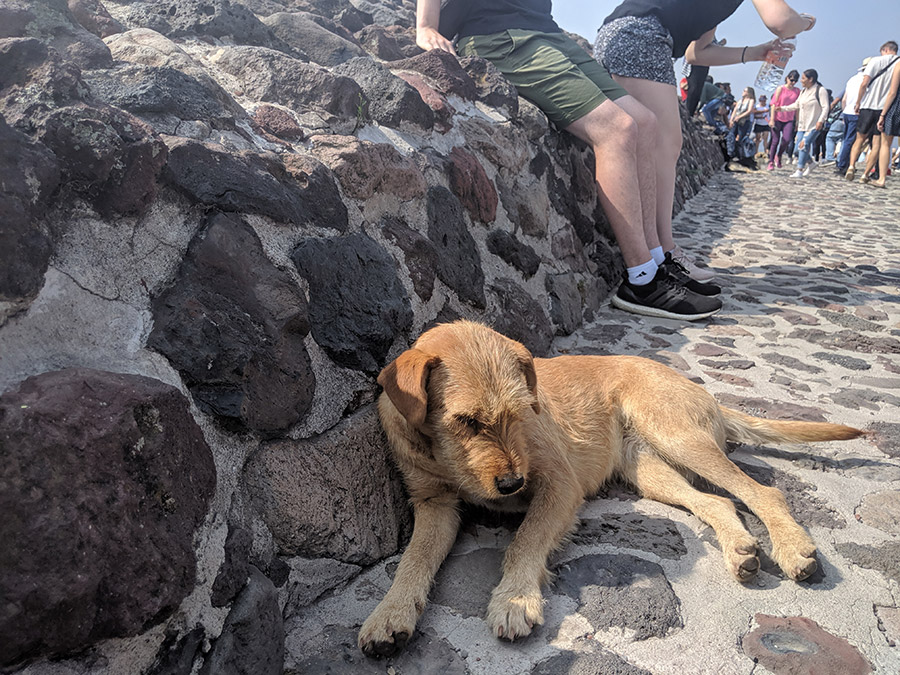
I decided to walk the radius of the pyramid and was thrilled to find that no one else had this same idea. I had the far side all to myself. I sat down and took in the landscape spreading out vastly before me, the trees and hills reminding me of my Southern California hometown (plus some pyramids). I loved that some small plants had found a way to grow out of the pyramid itself.
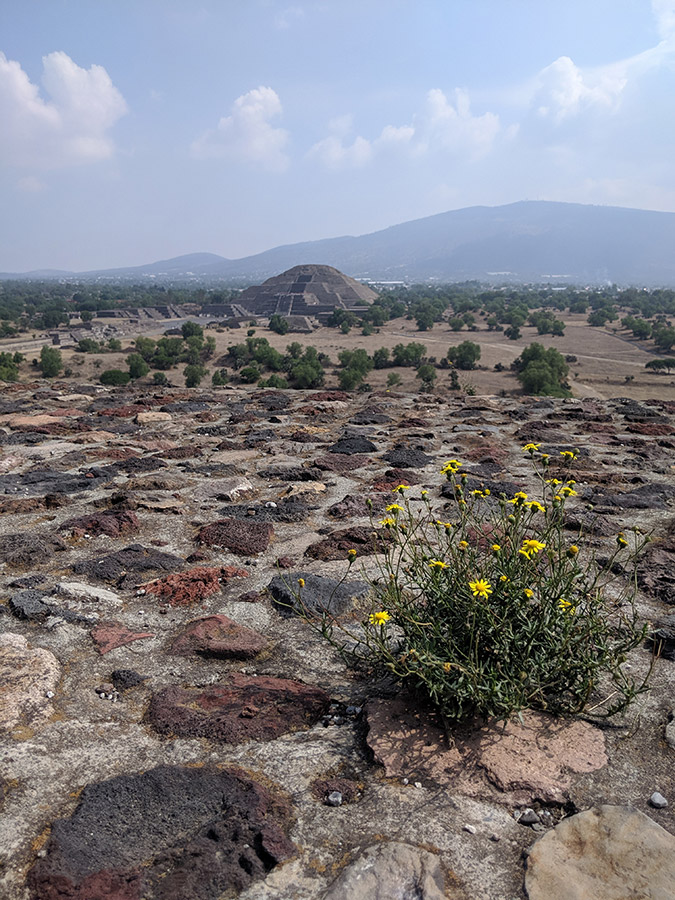
I slowed down my expectations and just enjoyed being in this moment, the sun shining across the silent expanse, feeling like a kid on a lazy summer vacation afternoon. I sat for a long while, soaking up the solitude and the view. Thoroughly soaked, I made my way to the site’s Beta attraction, the Pyramid of the Moon.
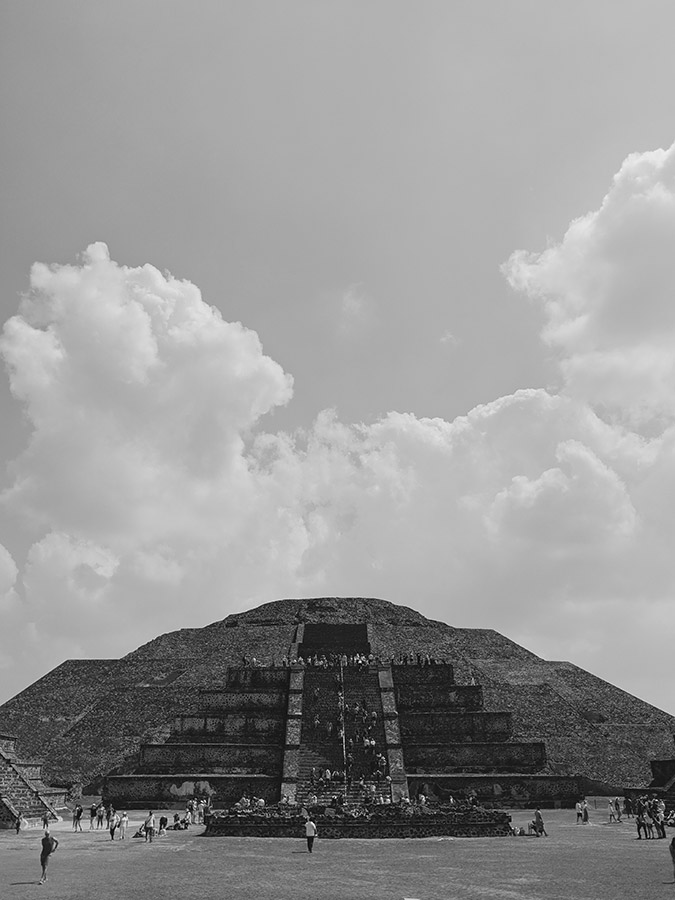
This smaller pyramid at the end of the avenue was blocked off so that you couldn’t climb to the very top. It’s still fun to climb the perilously steep stairs and stand on the main platform, looking at the ceramic gutters the designers had built to funnel water down the pyramid and the gigantic ants that are developing a highway up your leg.
After rolling down the pyramid steps like a broken Slinky, you can explore the Palace of Quetzalpapalotl, which is one of those names that makes you wish your parents had been more creative. The highlight here is the central courtyard with its amazingly well-preserved ornamental pillars.

It would be surprisingly easy to boner your entire visit to Teotihuacan by completely missing the museum hidden behind the Pyramid of the Sun, in which case you’d never see these cool dudes.
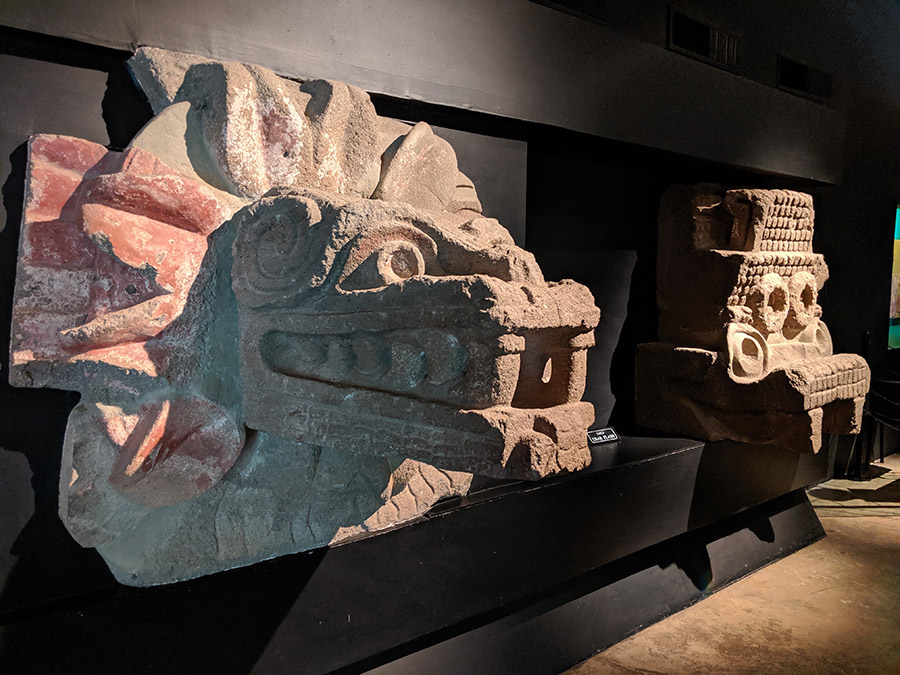
And you’d also entirely miss your chance to eavesdrop on a Teotihuacan slumber party. Spoiler alert: They’re talking about boys!
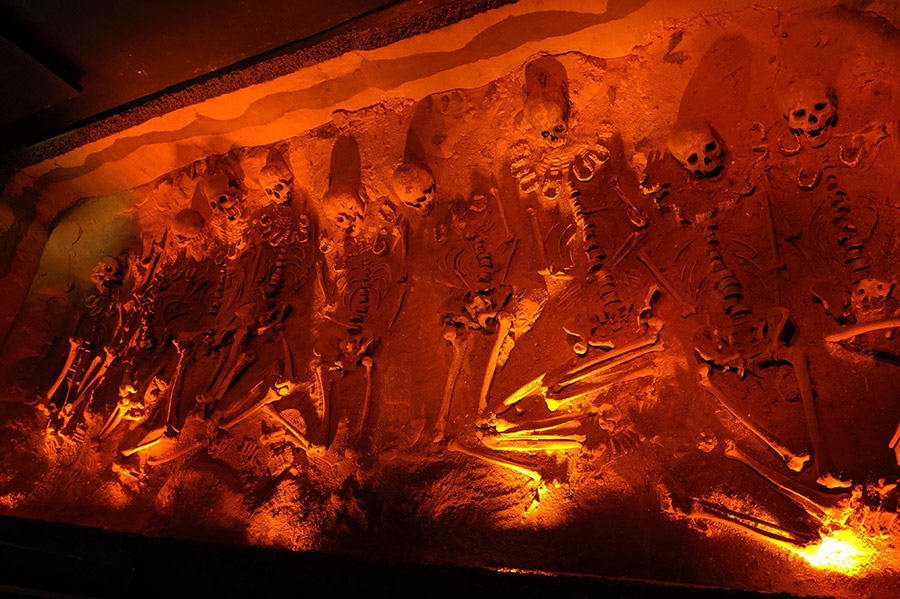
Wandering out of the museum, you take in the copious desert landscape deserted there for your enjoyment.

Back near the entrance to the city, which you’d have visited first if you weren’t powerwalking straight to the Pyramid of the Sun like your grandma on crack, there is the Temple of the Feathered Serpent, Quetzalcoatl.
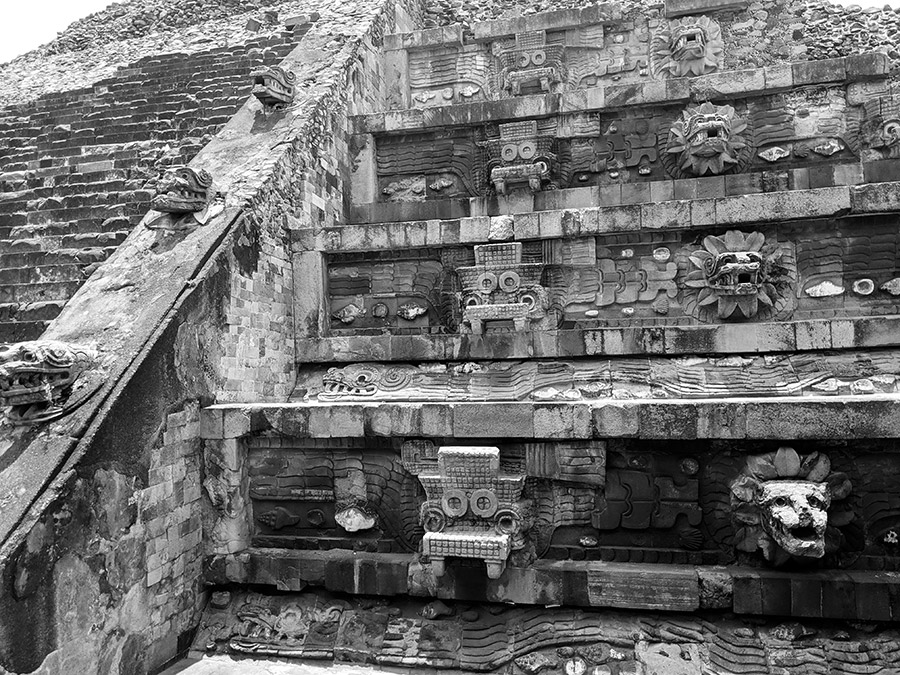
Quetzalcoatl apparently preferred to be honored with a shit ton of giant puma snakes and mustachioed 1980s robots, which sounds like it would have made his birthday parties a blast.
Mexico City has a Chinatown. I mean, not that it shouldn’t, it’s a big city. But I have to admit that this is something that had never once in my life crossed my mind as possibly existing. All they’re missing are Asian people to populate it with. But you know, you can’t have everything.

I love that the street-crossing guy in Mexico is like “Ugh, not this shit again.”
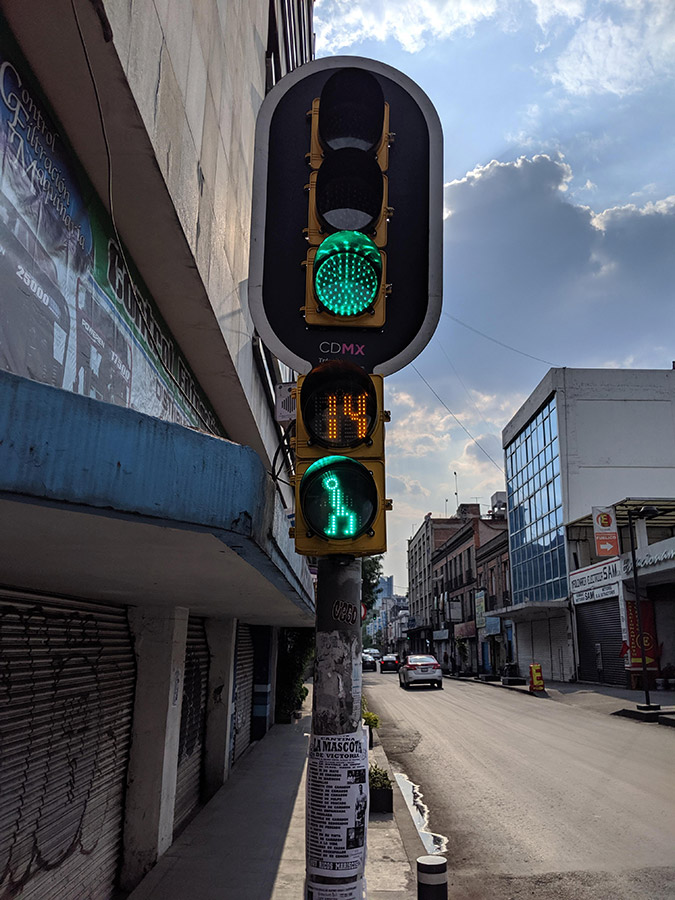
After wandering through Mexico City’s main park and watching the charming Sunday-afternoon scene of families enjoying the weather and kids going absolutely apeshit in the fountains, I began to become concerned.
Clowns. Mexico City has a disturbingly high tolerance for clowns. There are clowns all over this goddamned place.
I was trying to figure out how to say Juggalo in Spanish when I blundered into a full-blown clown encounter.
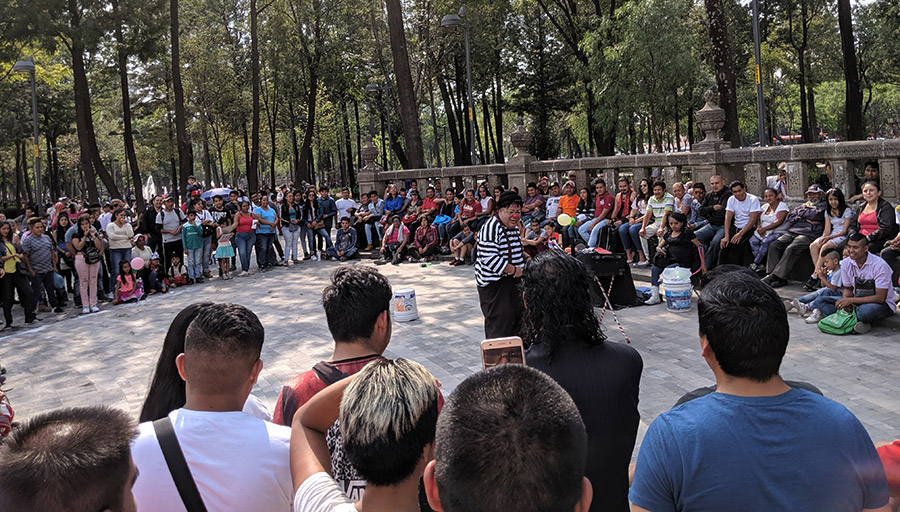
Oh thank God. I mean, this is disturbing and everything but I was starting to think there were just free-range clowns everywhere, with no purpose but to just be. At least they’re being contained by some kind of performance.
Part of the problem, I think, is that it’s still 1994 in Mexico City. There is goth and flannel everywhere and a large number of people look like they just stepped out of a “Head Like a Hole”-era Nine Inch Nails video. 1994 was back when we still thought clowns were fun. Those were more innocent times.
In stark contrast to the clowned-up park sits the beautiful Palacio de Bellas Artes.
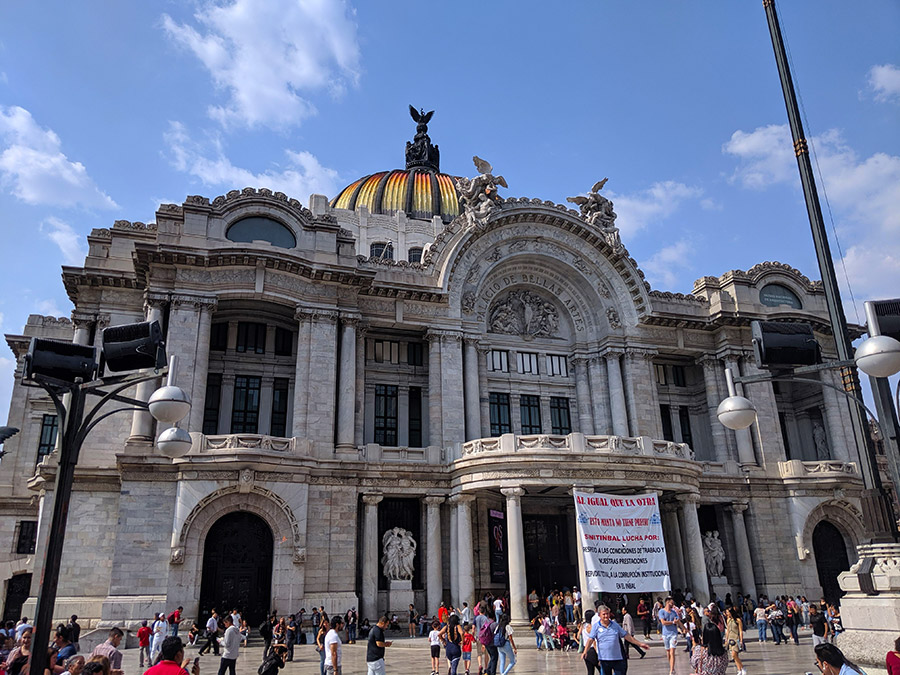
Inside, the building is even more striking in its Art Deco splendor.
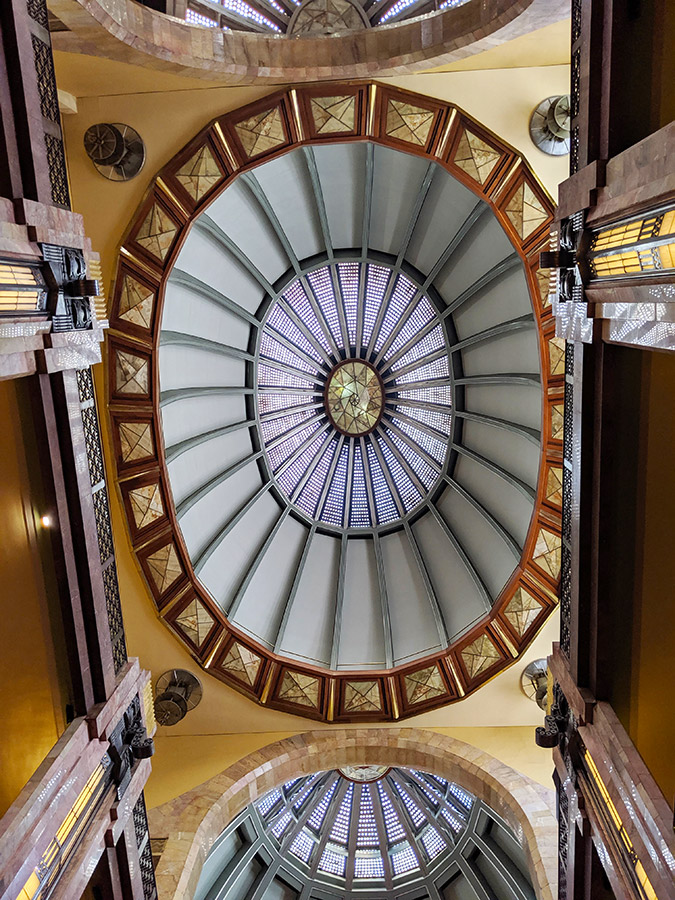
And because you’re not in Mexico if you’re not trying to forget a disturbing Diego Rivera mural, there are several.
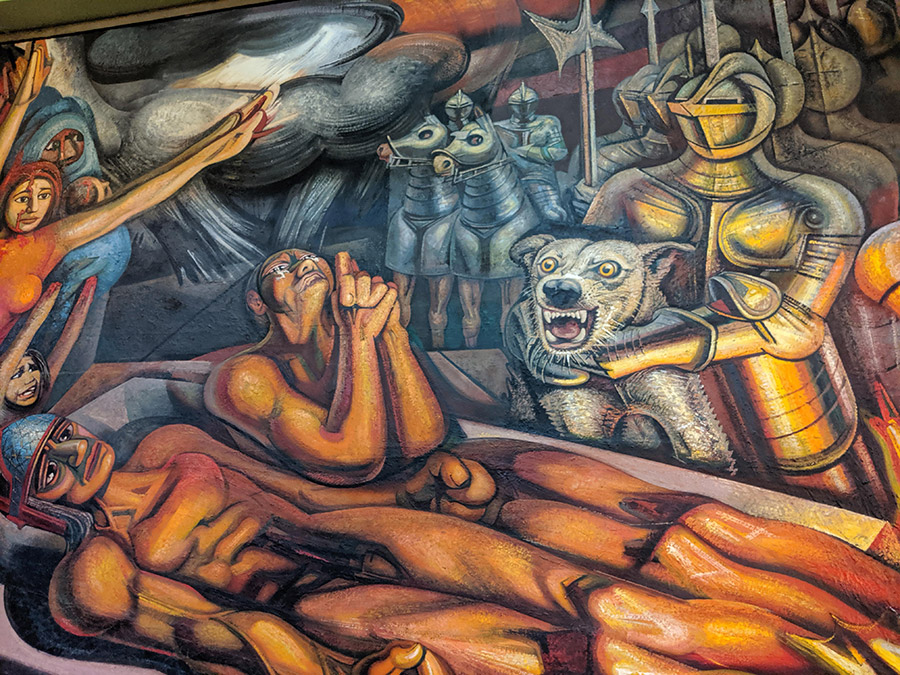
CDMX is one of the rare cities I’ve visited where I never got a handle on the public transportation scene at all. This was because Uber is cheap as hell in Mexico. I Ubered the shit out of Mexico City. An hour-long ride all the way across the city for $3? You have found my weak spot, Mexico. Take me to your spinach waffle soy bacon sandwiches.

Wandering between vegan restaurants in the center of Mexico City, I followed the sound of drums echoing off the tall buildings and stumbled across a huge native dance circle.
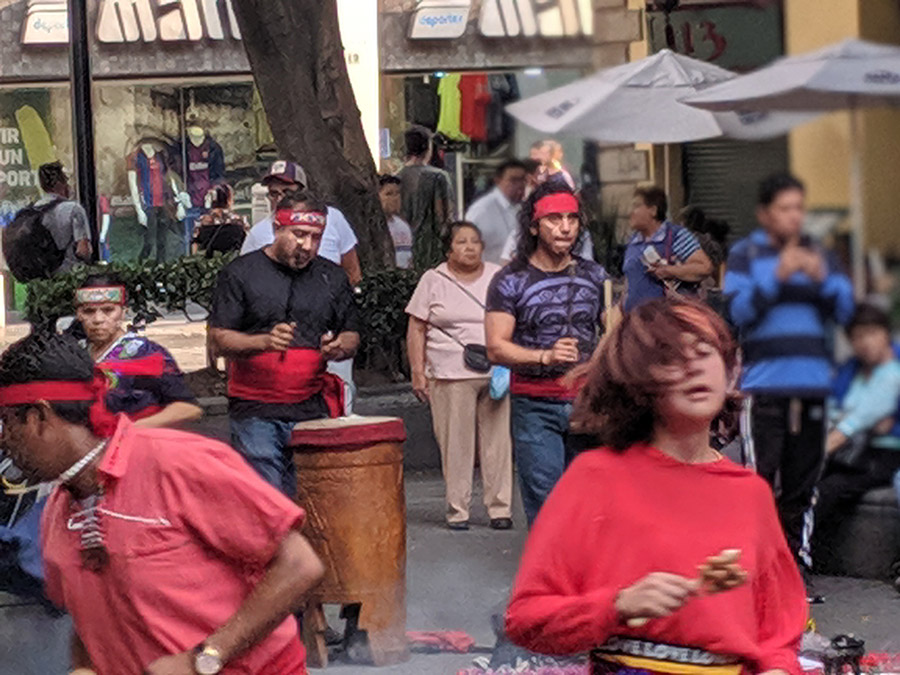
This was just an impromptu thing that was happening. So cool! People were keeping their Mayan/Aztec/Toltec heritage alive, loudly. The traditionally-dressed dancers twirled in a circle that reversed directions like a snake changing its mind as the drummers drove the beat.

The more time I spent in the city, the more I realized and was impressed by what a big deal native culture and rights are here. I wandered into Zócalo, Mexico City’s main square, which had been the city’s ceremonial center during the Aztec era. Some kind of massive concert was taking place. The concert had attracted a large number of protestors there to draw attention to the plight of the native tribes in the region, many of whom were dressing the part and not half-assing this in the least.
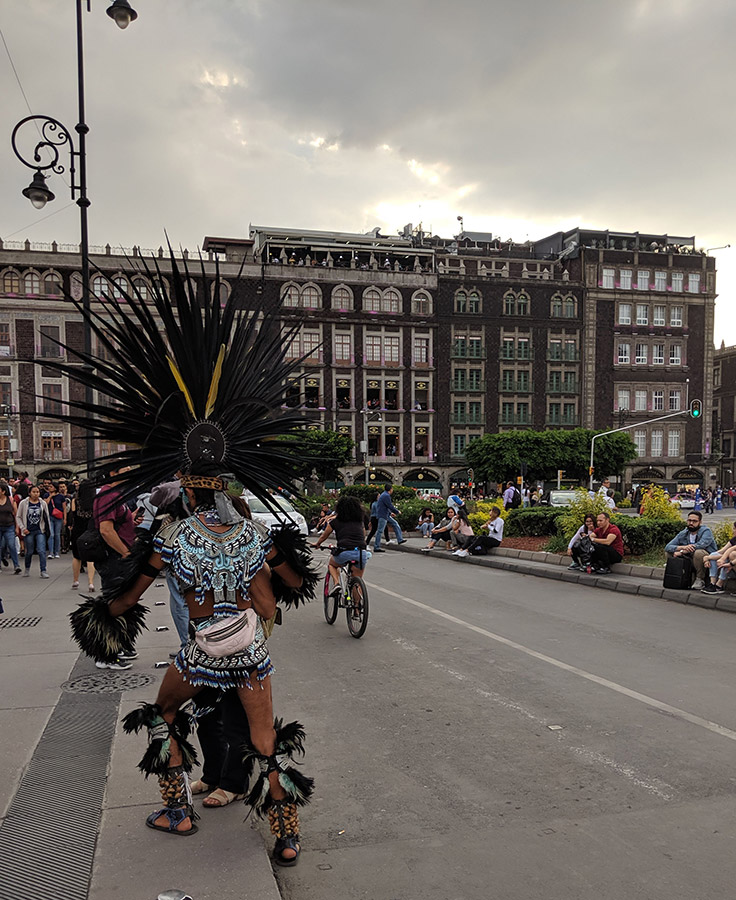
I laughed out loud as a girl walked by me wearing a shirt that said JUST DO IT LATER and I crossed the street, drifting past street-corner tribal fire ceremonies...
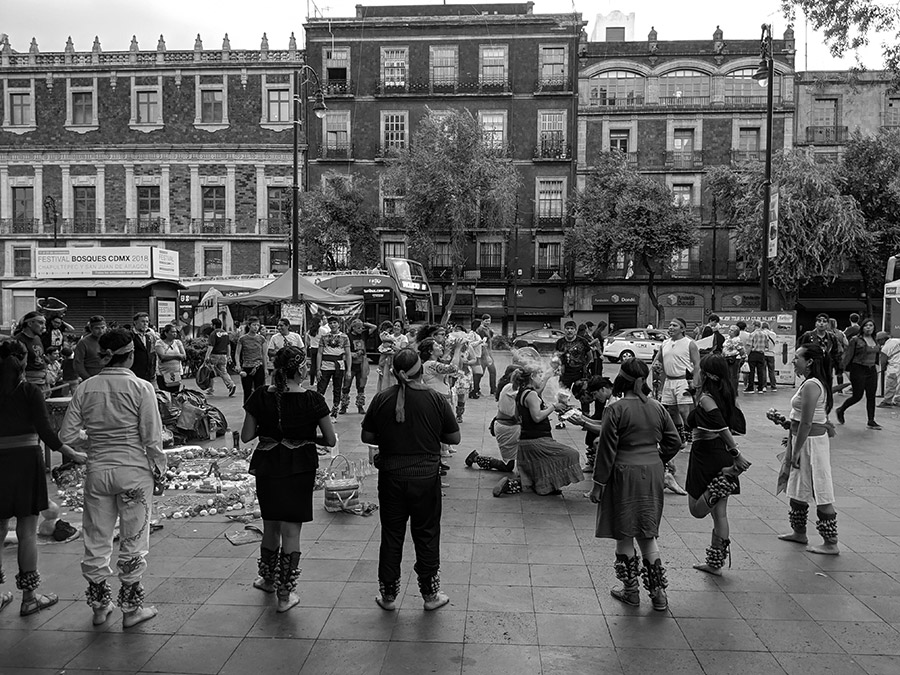
...and vendors selling skulls on blankets draped across the sidewalk, on into the Mexico City Metropolitan Cathedral of the Assumption of the Most Blessed Virgin Mary into Heavens, or as it’s known casually, MCMCAMBVMH.

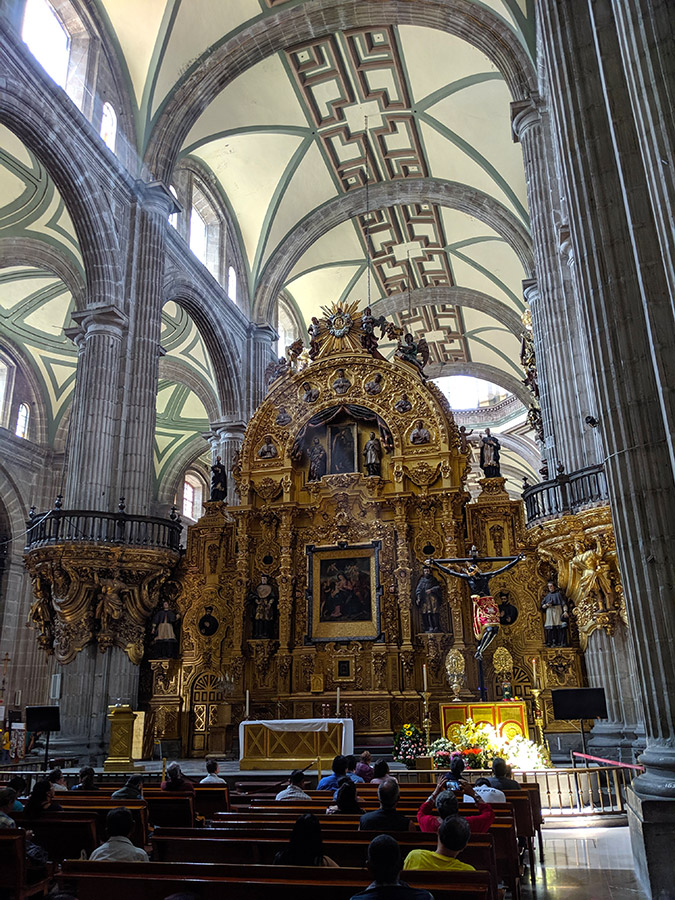
At the opposite end of the square/mosh pit of tourist confusion, sits Templo Mayor, the ruins of the main temple of Tenochtitlan. Tenochtitlan (I really want to add a “d” at the end, Tenochtitland!) was Mesoamerica’s largest city, which gradually over time morphed into the Mexico City of today. Templo Mayor is a surprisingly large archeological site smack in the center of a major city, one second you’re dodging hobo barf and the next you’re below street level, wandering through ancient ruins.
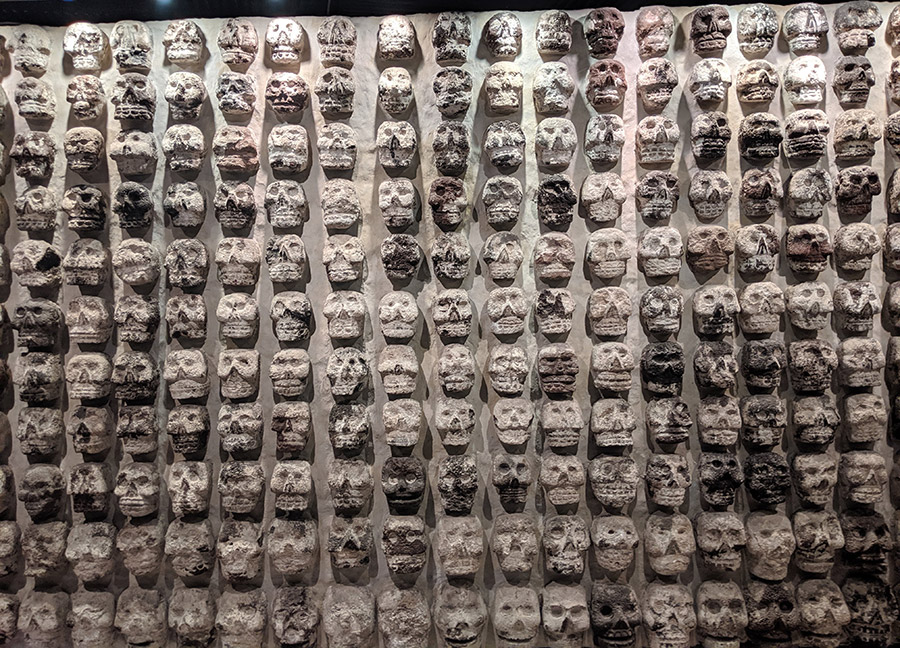
I know how you feel, I can never decide which skull to hang on my wall.

Mexico City Disneyland? Hard pass.
Mexican Charlie Brown?
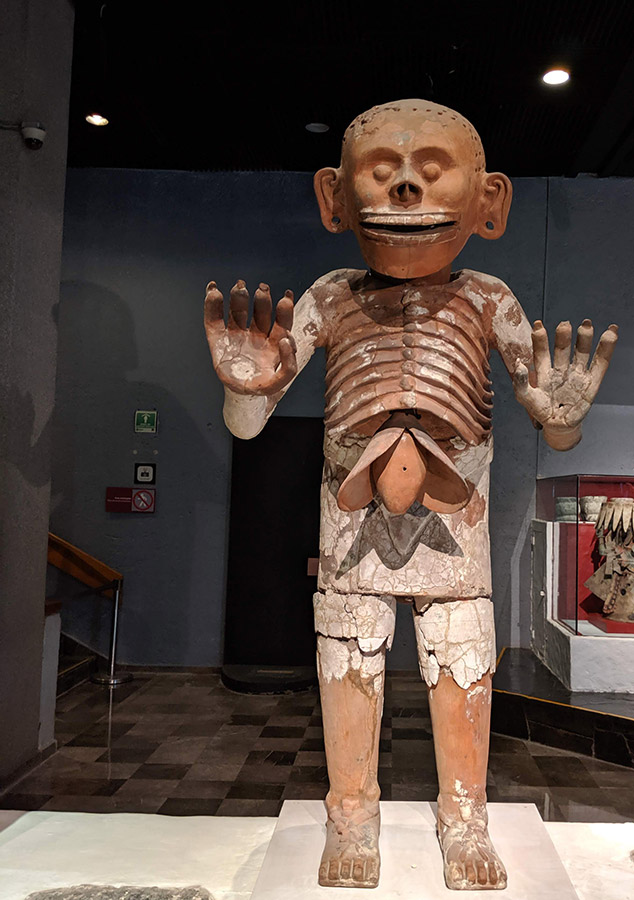
Hard pass.
The Axolotl is two things. It is a highly-endangered salamander native to Mexico and it is awesome.
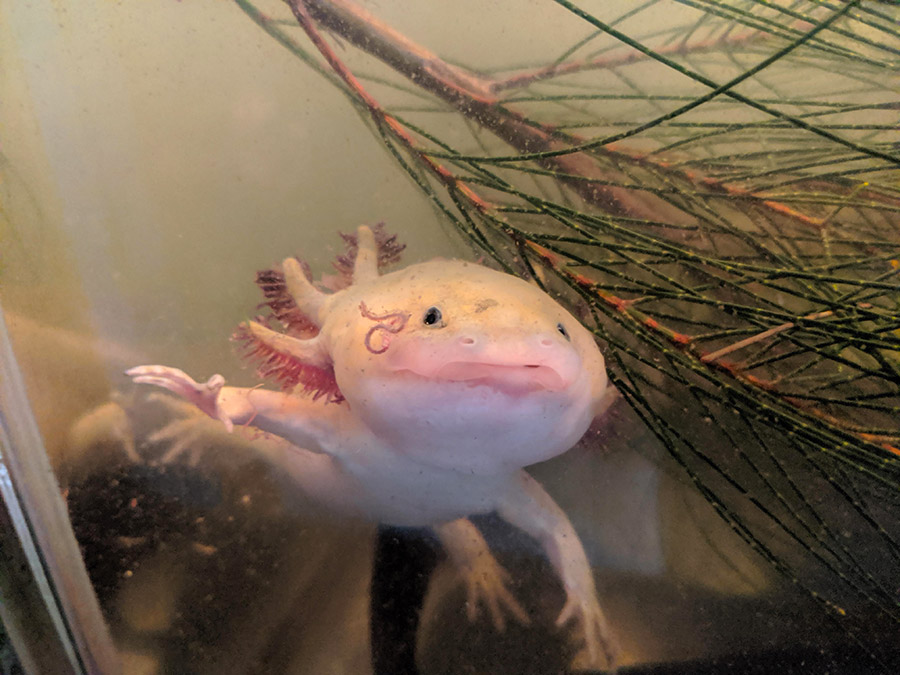
These otherworldly little guys are endlessly fascinating. Their external gills make them look like some kind of alien king. Their name is Aztec for “Water Monster.” They can regenerate entire lost limbs, organs and even their brain, heart or spine. No other vertebrate can do anything remotely like this. Axolotls remain in their larval state for their entire lives, though if one is accidentally exposed to iodine, it will transform into a completely different, land-based creature. So they’re basically magic gremlins.
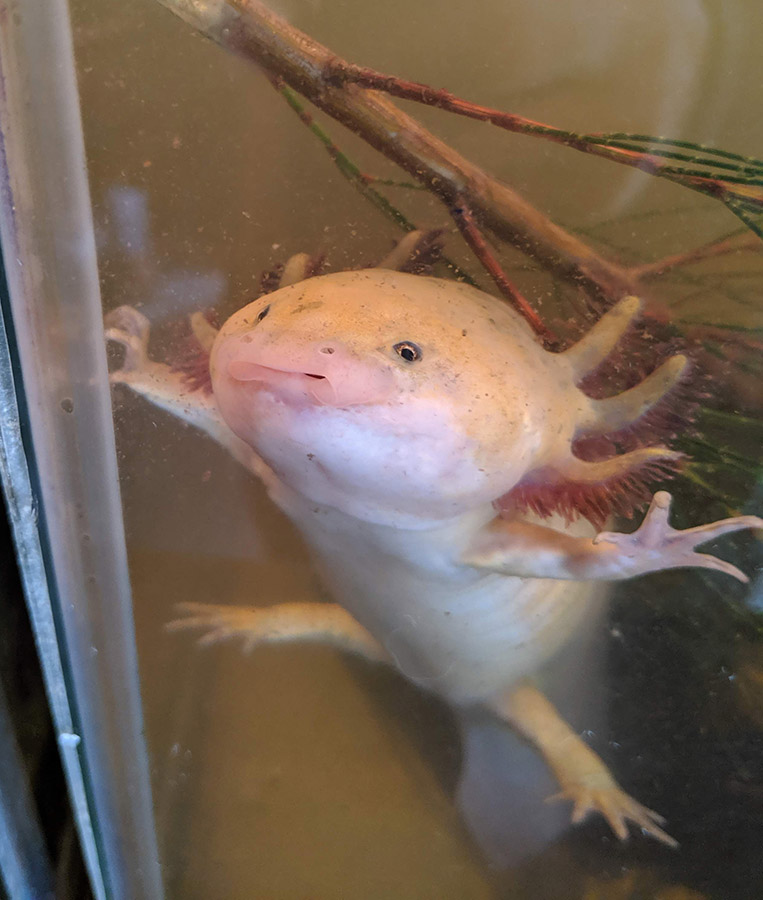
As a kid I was always fascinated by the animals that seem to come to us from another dimension. The mesmerizing, pulsating colors and eerie intelligence of the cuttlefish. The Slow Loris, which seems to exist on an entirely different time scale from the rest of us. And the axolotl, which just winked in from another reality with the Yep Yep Yep aliens from Sesame Street and Eugene the Jeep.
Most people have mental lists of places they’d like to visit one day. Me, I want to go everywhere. Instead, my mind carries a list of the animals I want to see in the wild. The axolotl is one of these that I didn’t expect to ever actually see in nature. They’re nearly extinct, and they live burrowing in the mud beneath the murky waters of a single canal in Mexico City. Yeah. Good luck with that.
And yet, I dreamed of it. A couple of years back I even wrote a song about my dream of visiting these guys one day.
As this trip approached, it began to weigh on me that I was going to axolotl central and yet I wasn’t going to see an axolotl. That’s bullshit. There has to be some way to fix this.
There’s Mexico City’s Acuario Inbursa aquarium, of course. But that’s barely a notch above seeing one in an aquarium in the U.S., or just in some dude’s house. The bizarre irony of the axolotl is that they’re simultaneously an increasingly popular aquarium pet all over the world, and yet down to their last few hundred representatives in the wild.
There’s got to be some kind of Mexico City Axolotl tour! Nope, there is not.
Mexico City is built on top of what used to be Lake Texcoco. The original city of Tenochtitlan began on an island in the lake and as the city expanded, the land was expanded and filled in further and further over time until what little water was left became known as Lake Xochimilco, south of the city. Then Xochimilco was drained and filled in with chinampas, artificial peninsulas built up from the lakebed for farming, which carved what was left of Xochimilco into the maze of canals that exists today.
Understandably, this caused the axolotls to look around and say “What the fuck??” in their adorable salamander language, their massive lake habitat having shrank to the size of a walk-in closet.
Visiting Xochimilco today is no problem, as it’s quite easy to hire a trajinera, a brightly-colored flat-bottomed gondola raft, which people use to drift around and get hammered on during the weekends. Fear not, anything worth celebrating in Mexico can be celebrated by blasting loud music from a trajinera: weddings, birthdays, DUIs, you name it.
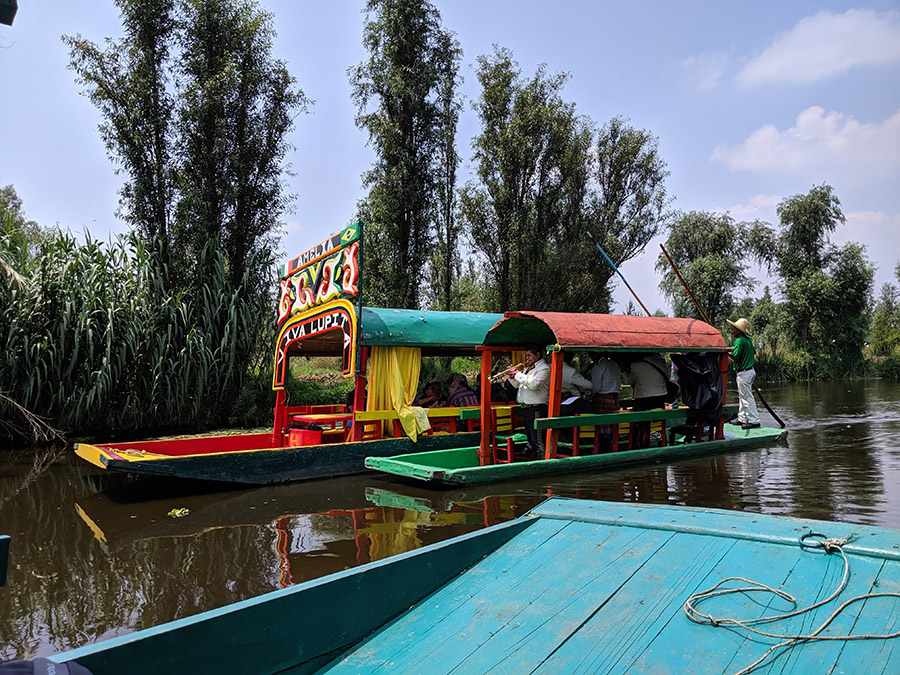
This, sadly, was not the vibe I was going for at all and seemed very unlikely to net me any face to face time with a wild axolotl. I dug into the possibility of hiring a trajinera owner to take me out searching for axolotls early in the morning before the partying began, but soon realized this would make finding a needle in a haystack seem easy.
I had almost given up when I stumbled across an article from a Mexican newspaper about conservationists taking the writer out into the canals of Xochimilco to learn about axolotls, which ended in her actually getting to hold one. That’s more like it!
I kept digging until I found a Mexican luxury tour company that specialized in organizing any kind of trip you can dream up, and before long I had made a very sizable donation to axolotl conservation and was connected with a professor of ecology from the University of Mexico, who was going to take me out into the canals before dawn to see some axolotls first-hand.
It was the single-most expensive activity I’ve ever booked in all my travels, but I was so overjoyed and excited that I cried when I booked it. How could I not take this opportunity? It was like I was seeing life open up in a brand new way, with the realization that I can dream up something crazy and improbable and beautiful like this and then actually make it happen. Manifestation on a whole new level.
I laughed out loud at the thought that the company doing the organizing was likely used to picking people up at the Ritz-Carlton, rather than my gritty downtown hostel. But everyone seemed to take this in stride.
“I thought you’d be older!” Professor Martin greeted me.
“So did I!” I replied.
We were fast friends, understandably, as the only person likely to be able to relate to my choice to fly all the way to Mexico and pay this kind of money to see a salamander was someone who had dedicated his life to saving these very animals from extinction. We slipped through Mexico City in the dark pre-dawn hours and before I knew it, I was on a trajinera, drifting through the Xochimilco canals as the prelude to sunrise began to lighten the horizon.
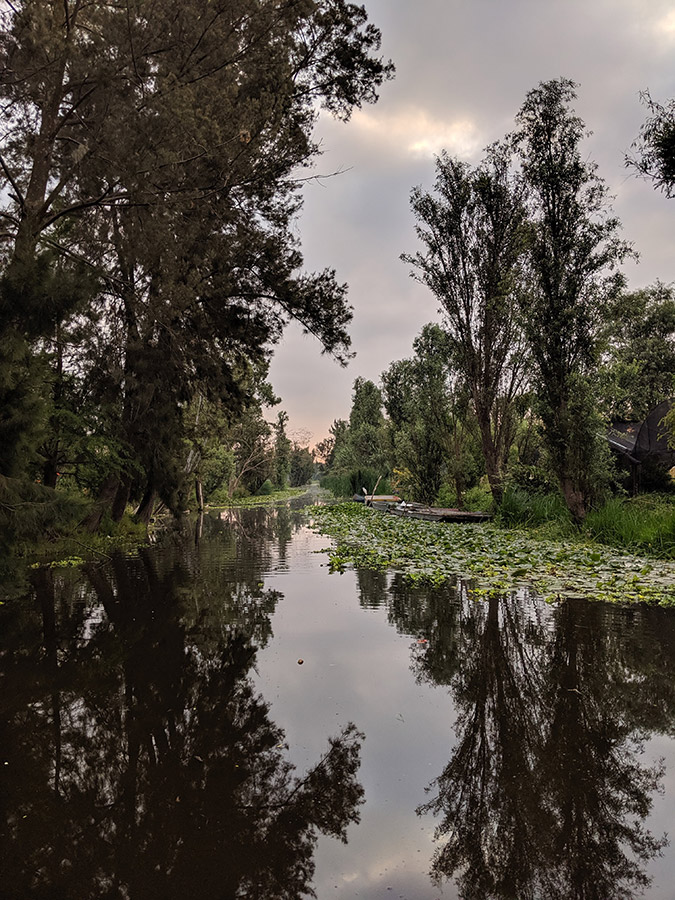
Occasionally we’d drift past a fisherman in the early morning twilight, exchanging strangely intimate hellos as we were alone together in this strange, silent, misty world. Mexico City itself was only a stone’s-throw away, but it might as well have been on the other side of the Earth, so complete was this perfect, isolated preserve.
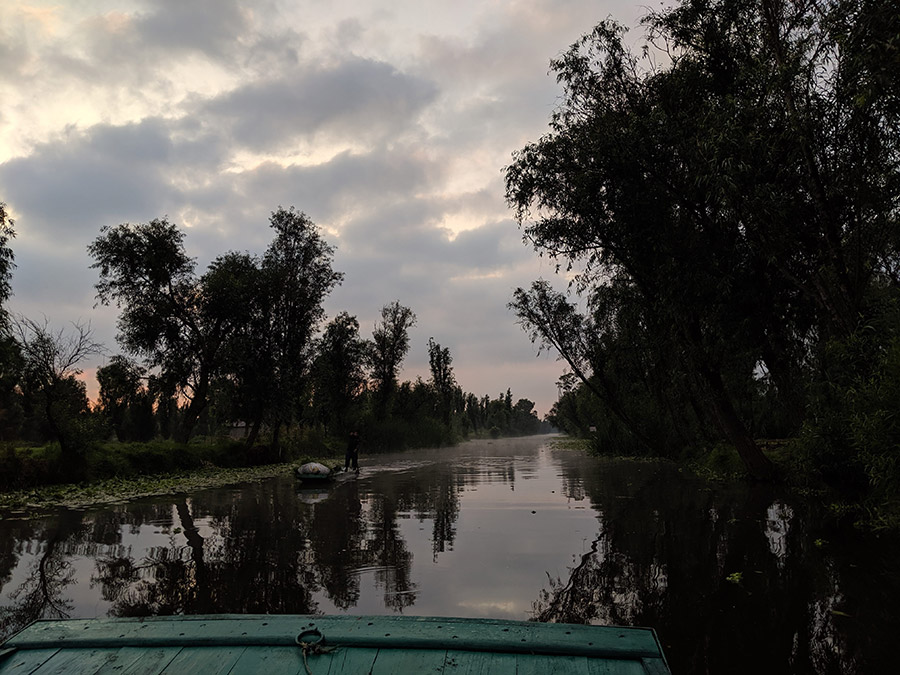
Gradually, the sunrise began to melt the horizon into a beautiful orange hue. This is amazing. It boggled my mind to imagine some alternate-universe version of me who was asleep in bed in Minneapolis at this moment.
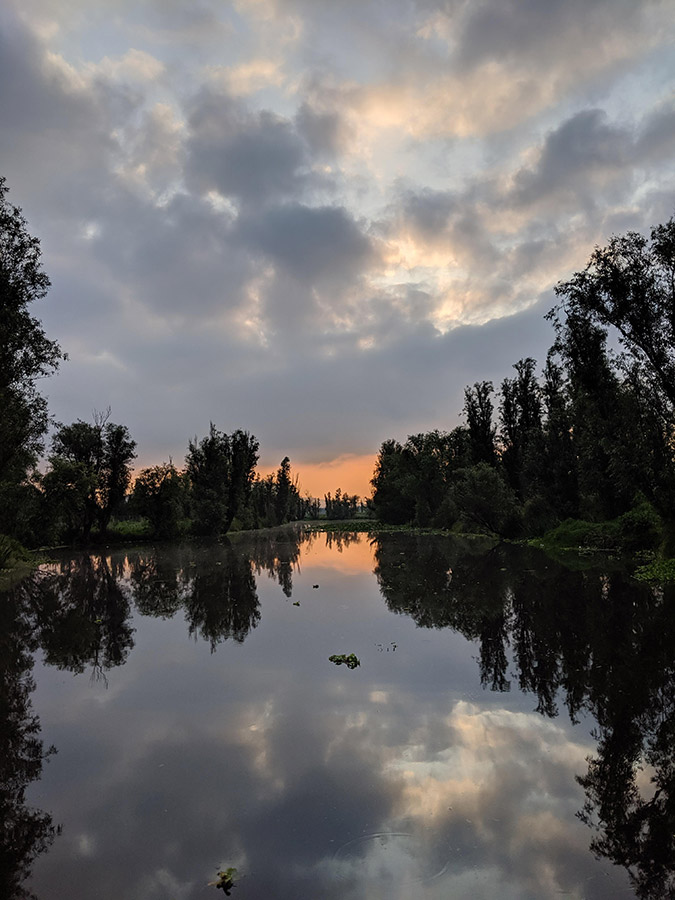
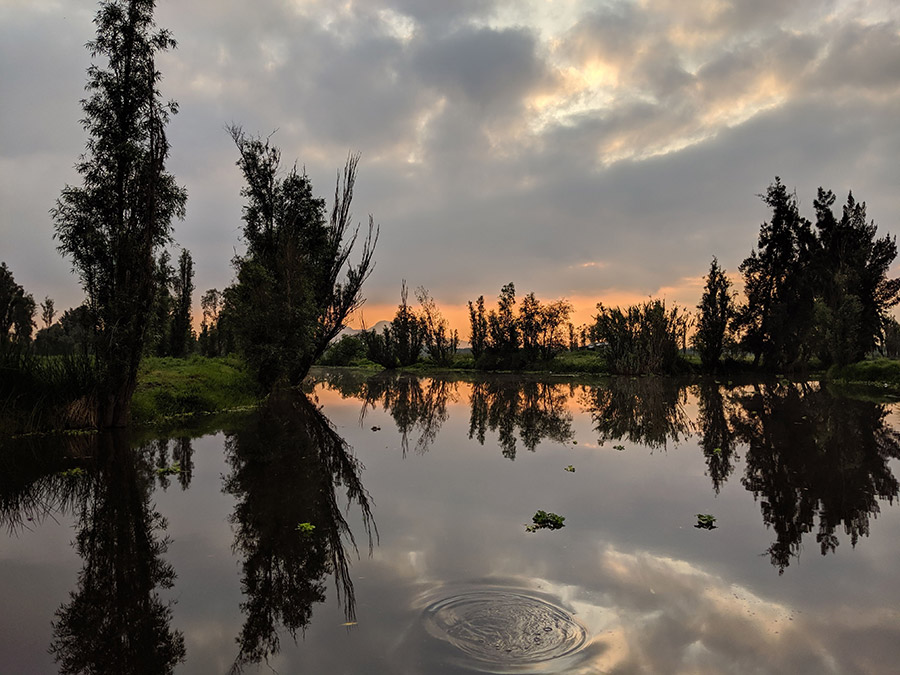
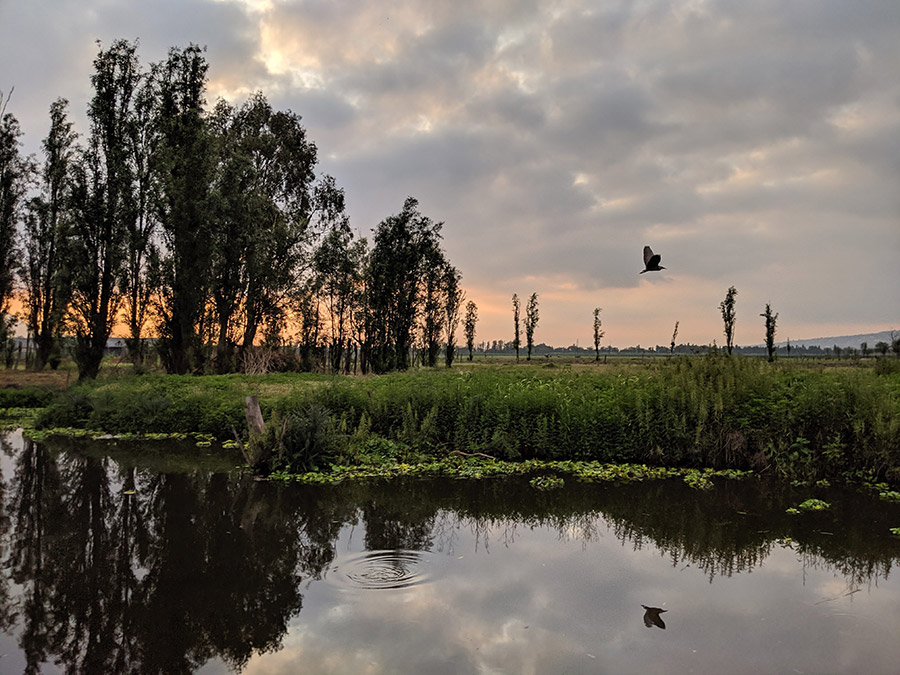
As I was watching a night heron perched in stillness on the water’s edge, I turned to look at the opposite shore and- holy shit, a cow!
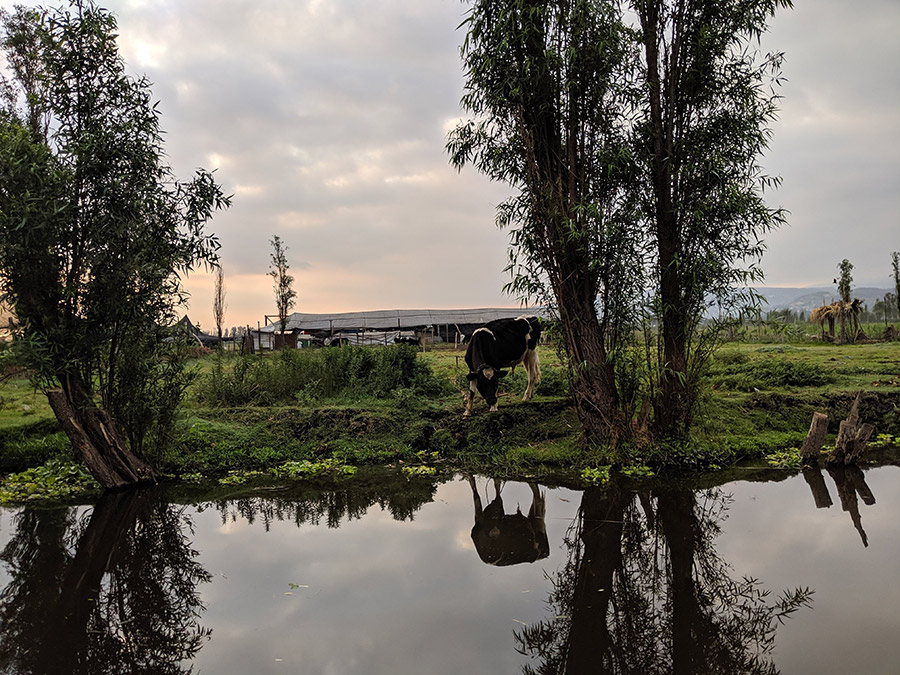
I’m certain the cow was thinking something similar, once she was done contemplating her reflection and how weird it is to be a cow.
Martin was an expert on birds, and as we coasted through the silent morning he pointed out the dozens of species coming to life all around us. Majestic white egrets arced over the canal waters. Others stood so still in the shallows as our boat drifted closely by that I was certain one of them was some kind of plastic lawn ornament until it looked me in the eye.
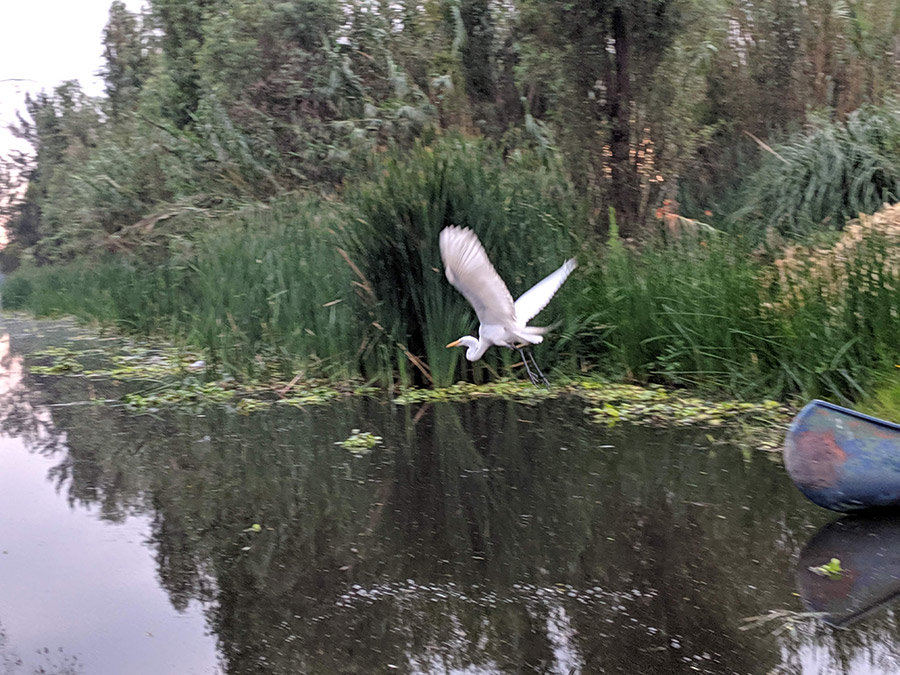
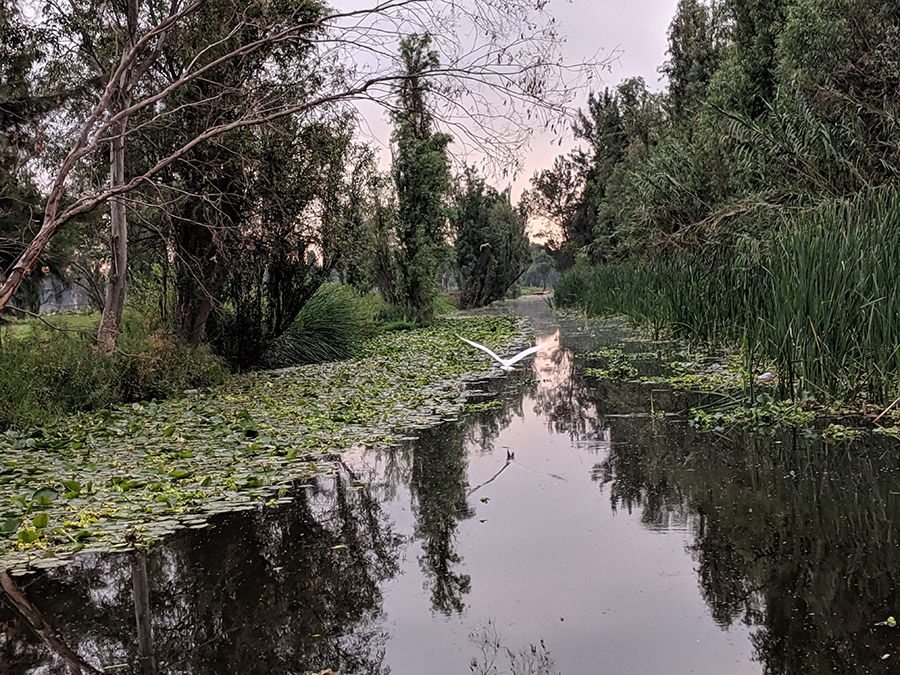
We stopped and climbed out onto one large chinampa, spotted with cows and small ponds, and hiked across the grass to a small hill as twin avocets looped over our heads, calling out a squeaking warning to all assembled that intruders had arrived. Through huge field glasses we took in the assorted Mexican ducks, night herons, egrets, ibises, grackles, and my favorite of all, a sandpiper with her two babies, which she unceremoniously sat on whenever an unfamiliar sound raised her guard.
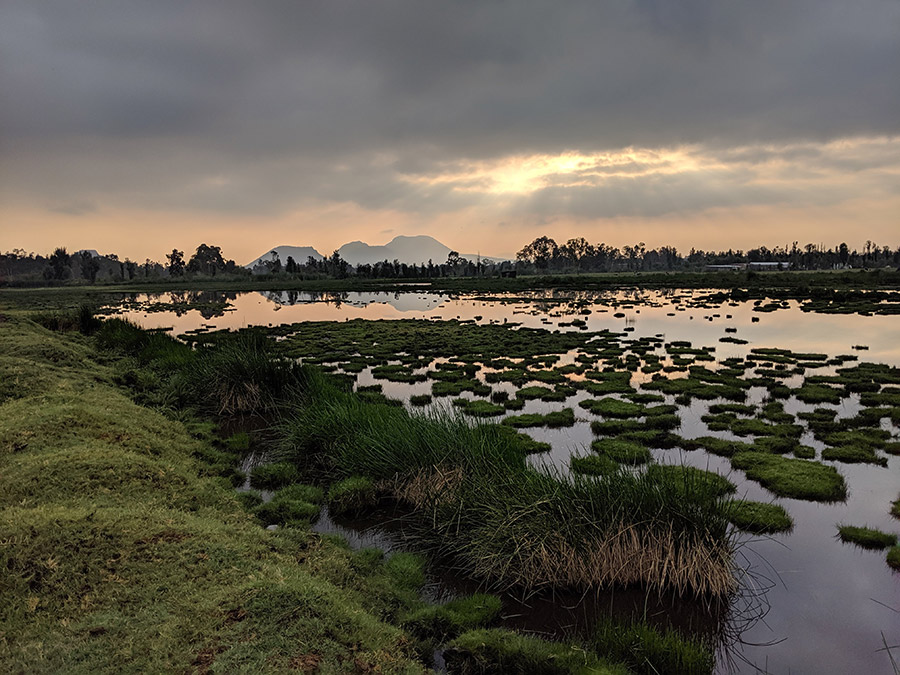
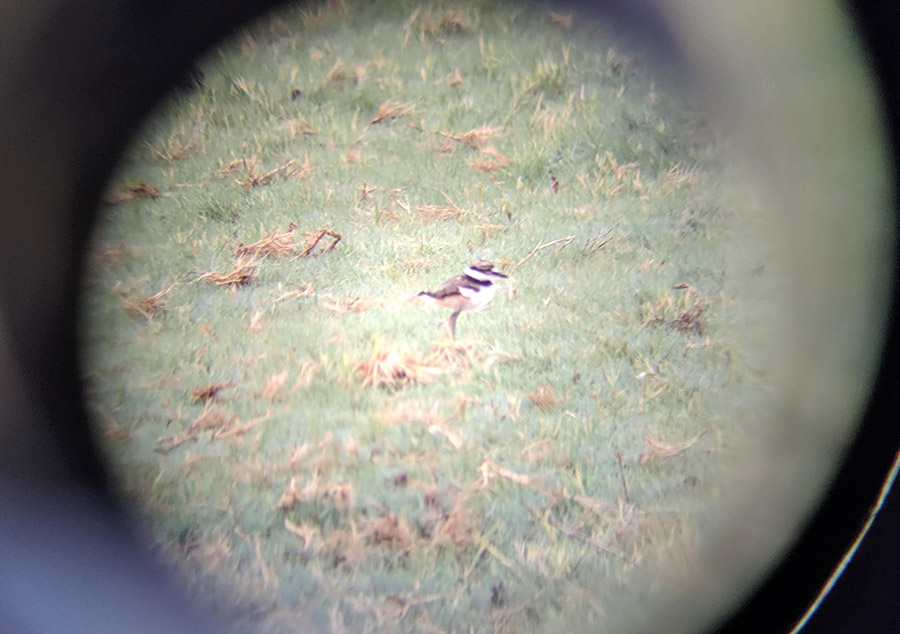
Before the day was over we’d see 24 different varieties of birds, the majority of which I was about 80% sure weren’t plastic lawn ornaments.
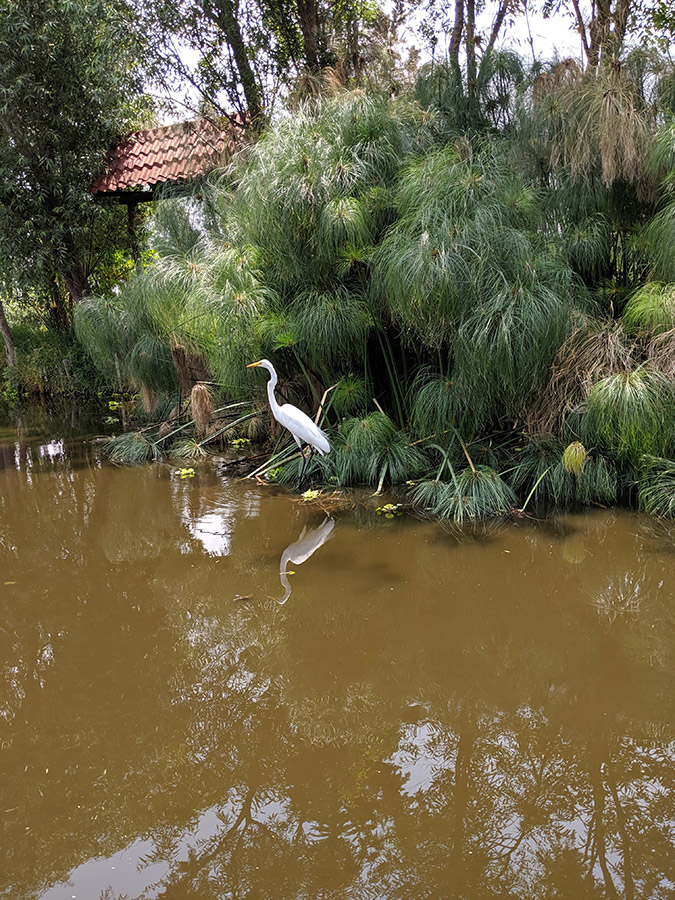
I was enjoying myself so much I’d almost forgotten that this was all just a prelude to the main event. Our gondolier angled the boat down a narrow canal and we got off onto a large chinampa in a hidden away, distant corner of the canal system.
Down a long pathway, suddenly we were in the midst of a farm. Huh. The farmer led me around and between his rough English and my rough Spanish we worked out a basic understanding of what all the crops were. At the canal’s edge, he showed me how they dredged up nutrient rich-soil from the bottom of the canal, dried it and used it to start the seeds for their crops. He tried to get all his seeds from co-ops and other farmers, to avoid any involvement with Monsanto and the other agricultural giants. He showed me the huge sealed barrels where he created his own organic fertilizers from compost and yeasts.
All this, when he wasn’t working with an environmental NGO in an attempt to bring axolotls back from the brink of extinction. One of the canals bordering the chinampa had been closed off with a fine wire mesh, allowing water and insects through, but not the human-introduced carp and tilapia that were out-performing the axolotls for food and driving them to the brink. Near the canal, a series of potted plants connected by hoses were filtering out the pollutants and agricultural fertilizers that were upsetting the water temperature and visibility conditions the axolotls need to find food and survive.
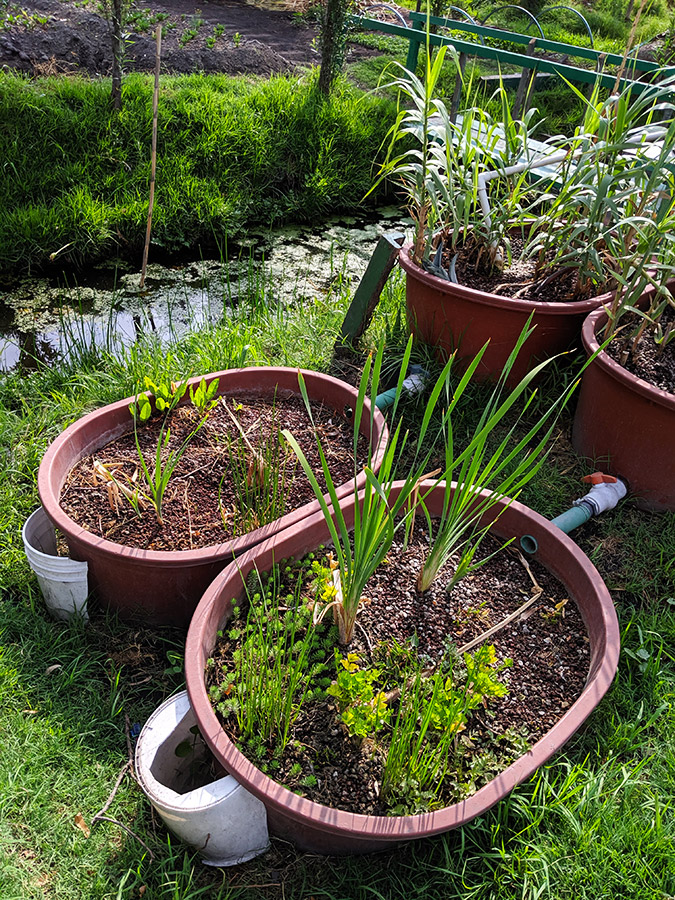
Out of a protective enclosure built to keep out axolotl-eating egrets and other predators, the farmer scooped out two black axolotls. All axolotls in the wild are black, the pink and other colored varieties you see in aquariums are all mutants bred to be attractive for the pet trade. Axolotls survive by hiding down in the mud like tiny ninjas and being hard for predator birds to see. Those pink guys wouldn’t last five minutes in the wild.
And now here I was. Axolotl in a bowl!
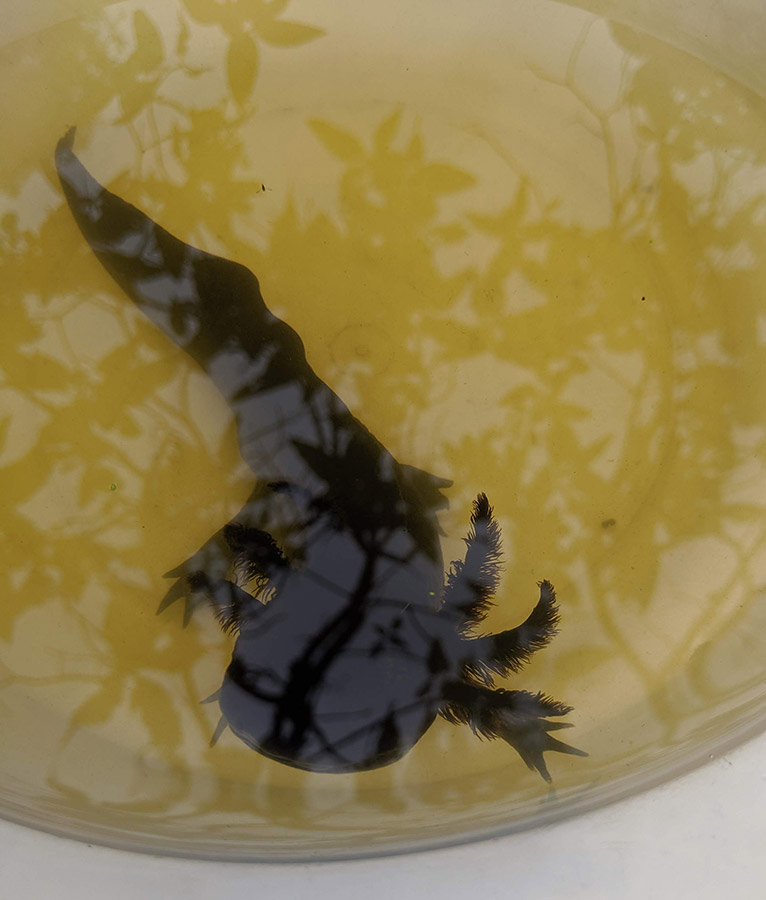
Wild axolotls look surprisingly like little dragons. Toothless from the How to Train Your Dragon movies is pretty much an exact copy. They are truly mesmerizing. They breathe through their ostentatious gills, through their skin, and also by suddenly snapping their heads out of the water for a split-second, gulping the air down like it was a water bug.
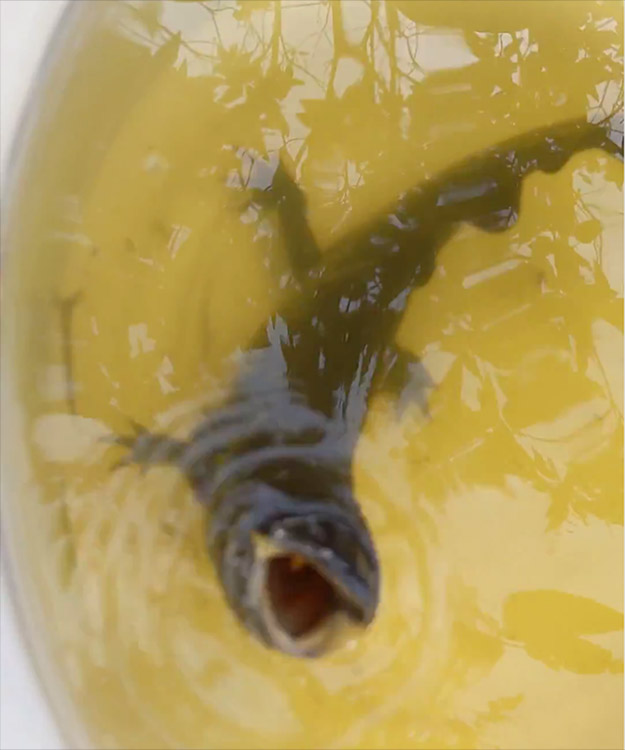
I watched the two axolotls wander around in their bowls and laughed out loud as they peered at me through the water’s surface and the sides of the bowls.
“Be careful when you hold them,” the farmer suggested.
Wait, what? I get to hold them? Holy shit!
I put on a glove and began to navigate the complicated business of picking up a very wet and very wriggly axolotl. This is basically like picking up a wet bar of soap with your hands covered in liquid mercury, and also the bar of soap is alive and doesn’t really want to be picked up.
But eventually I moved slowly enough, and the axolotl became convinced enough that I wasn’t going to try to eat him like a burrito, that I managed to pick him up. Oh my god, this is so cool!
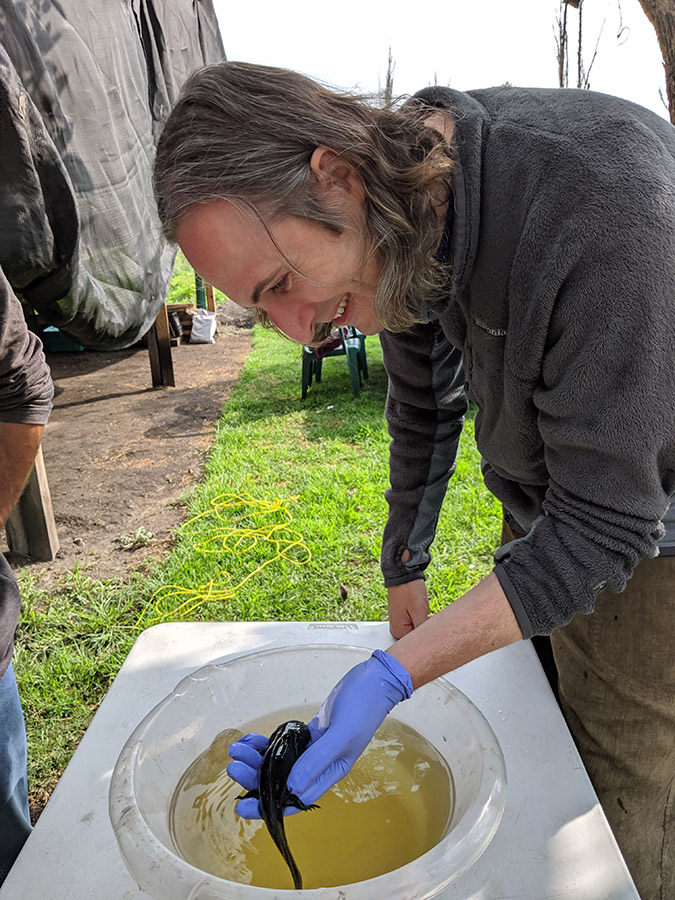
And then in that moment, the axolotl spasmed violently and squirted straight out of my hand. Shit! SHIT!
The axolotl popped a few inches into the air, then back into my hand. Whew! That was clo- Then he immediately wriggled hard again and squirted right through my fingers like that proverbial bar of soap, this time shooting several feet straight up in the air, over my head. AAAAAAAAAHHH!!
OH MY GOD I FINALLY GOT MY MAGICAL MOMENT AND I USED IT TO KILL AN AXOLOTL!!
If you’ve ever had to list any weird talents you have for a get-to-know-you icebreaker, my weird talent is that I’m good at not dropping things. I always seem to catch falling objects even if I can't see them, or at the very worst, improbably unharmed on the first bounce. I once caught a tiny millimeter-long screw that fell out of the sunglasses I was wearing, before it hit the ground. Chalk it up to dumb luck or some kind of innate spatial awareness that doesn't bother to manifest in any more-useful ways. Maybe it was all preparing me for this moment, who knows?
I only had a glove on one hand, and I wasn’t sure if they’d given me the glove because human skin oils kill axolotls on contact or what, but I didn’t want to take that chance. So now I needed to catch a skydiving axolotl with one hand.
And I did, somehow. A black blur streaked by my face and -SPLURK- I looked down and the axolotl was back in my hand again. How in the hell- Look I’m not gonna look a gift catch in the mouth, thank God I didn’t kill a highly endangered animal that I love-
The axolotl was much less impressed by this miracle than I was, and immediately thrashed again, squirting out of my hand sideways, skipping off the top of a nearby picnic table, and splatting onto the grass. OH FU-
I sprinted over and scooped him up. Oh thank god again, I think he’s fine-
“I think that’s probably enough axolotl handling-” the farmer suggested.
You think? Back in the bowl. The axolotl looked up at me from inside the bowl and blew me some bubbles.
Martin was equally enamored with the axolotls, though he managed to express this without throwing one across the island.
“No matter how often I see these guys, it’s always magical.”
Eventually the axolotls had to go back in the canal and we said our goodbyes, returning to the canal ourselves.
On the way back to the mainland, Marin told me about a guy he knew who was single-handledly trying to save the axolotls, in spite of not having any funding or official affiliation of any kind. Slight warning: He’s a little crazy. Did I want to meet him?
Hells yeah!
Michael, the axolotl guy, was working out of a tiny shed at the water’s edge. I knew I was in for something special when I approached and found a huge metal homemade axolotl-head on the lawn.
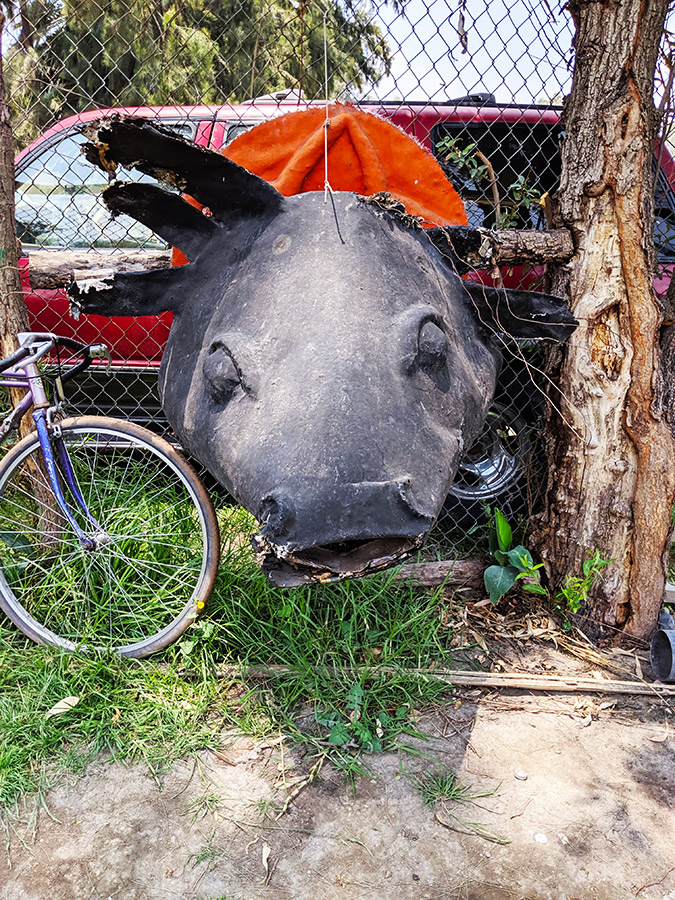
Across the lawn there was this huge axolotl display.
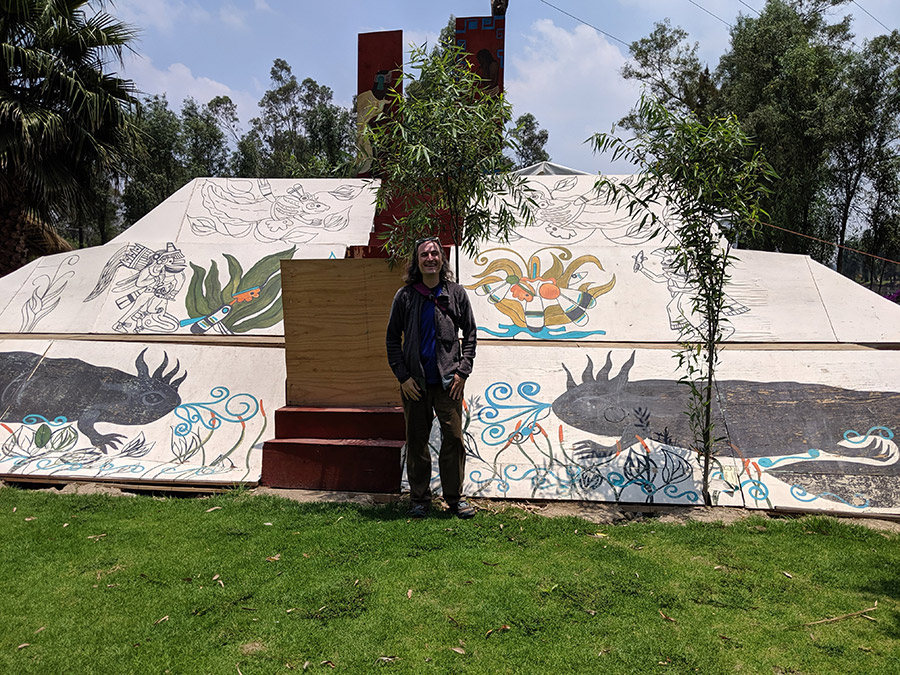
The inside of the shed was jam packed with aquariums full of axolotls, and copious handmade axolotl paraphernalia. Sitting on a shelf on the far wall was another axolotl head:
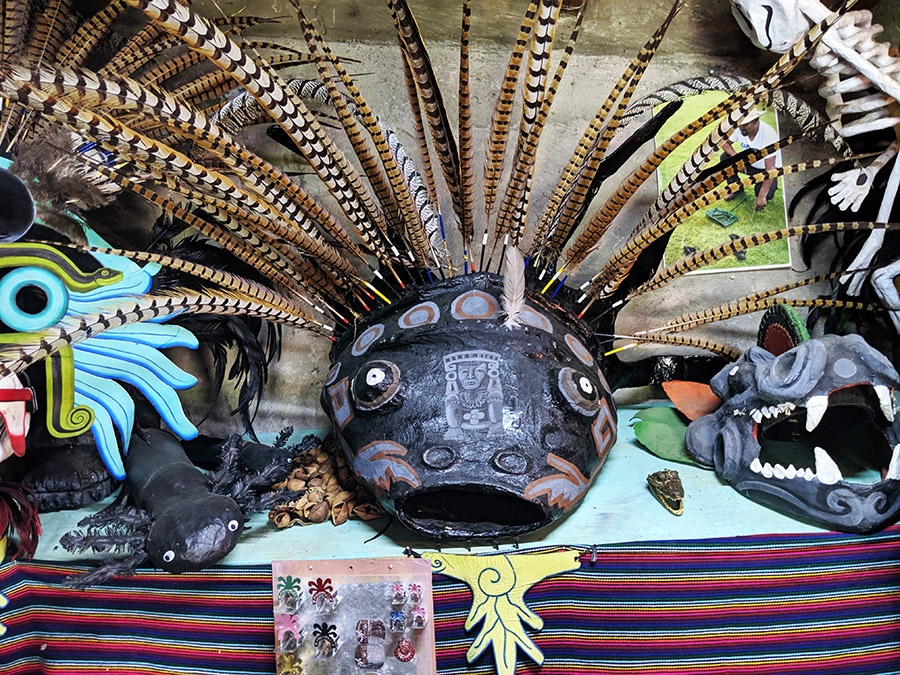
And next to it this incredibly elaborate mask, detailing the axolotl’s role as god of the underworld.
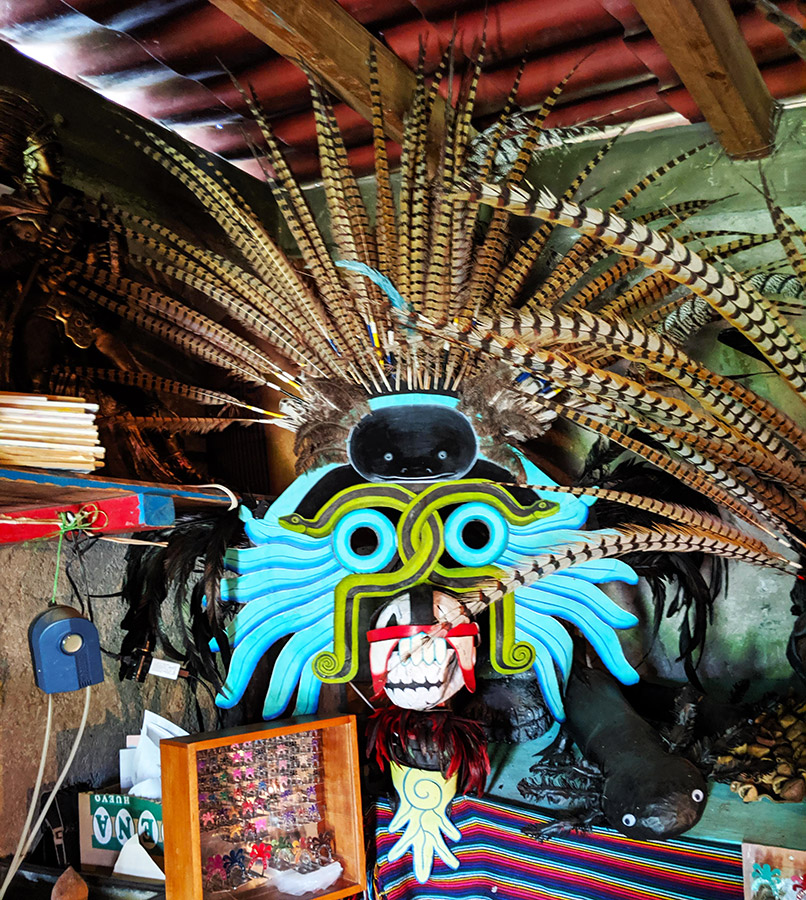
Michael was breeding as many axolotls as he could, and every spring he would put on this mask and in an ornate ceremony, release thousands of axolotls into the canals.
He introduced me to his favorite axolotls and told stories about how he had spent so much time communing with the creatures that he could now regenerate his own limbs at will. Okay.
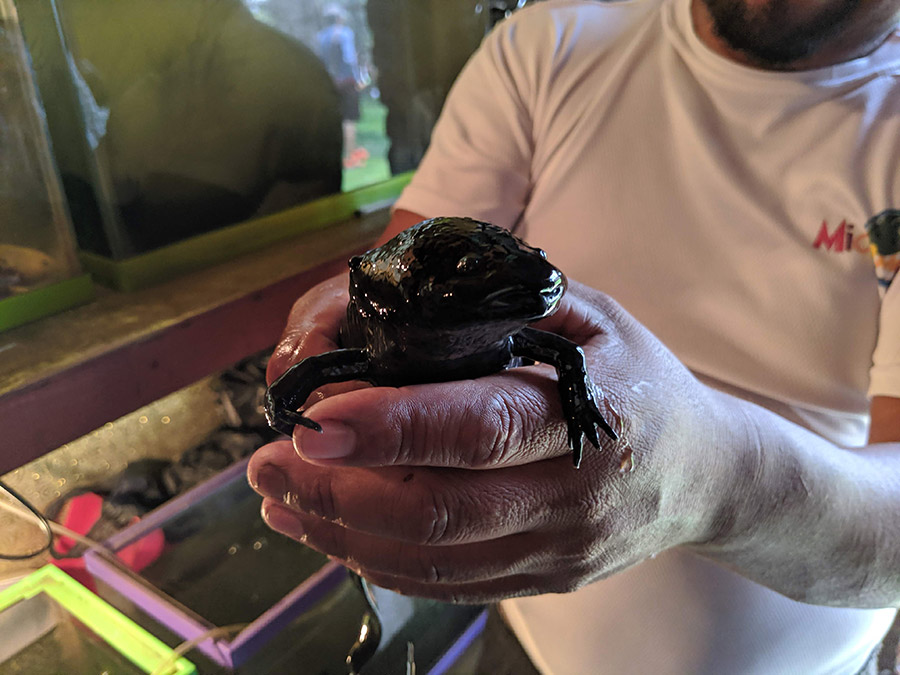
He was much, much better at holding them than I am.
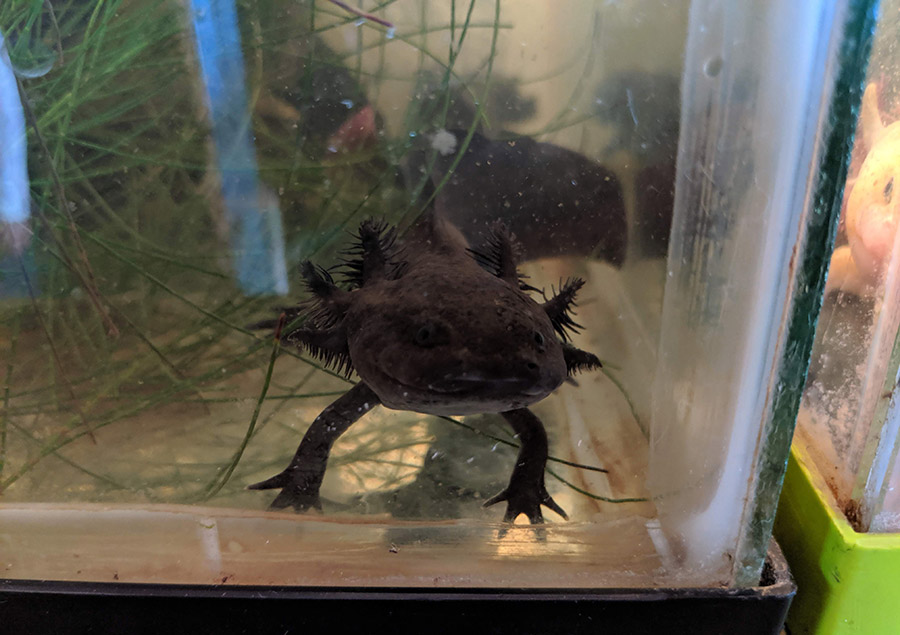
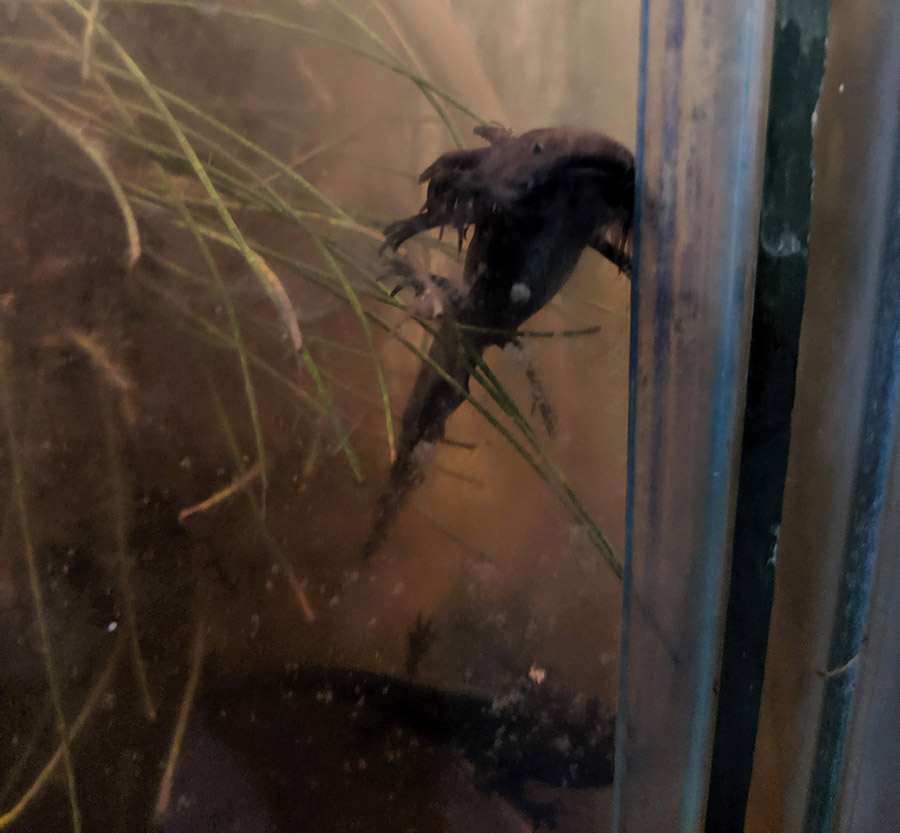
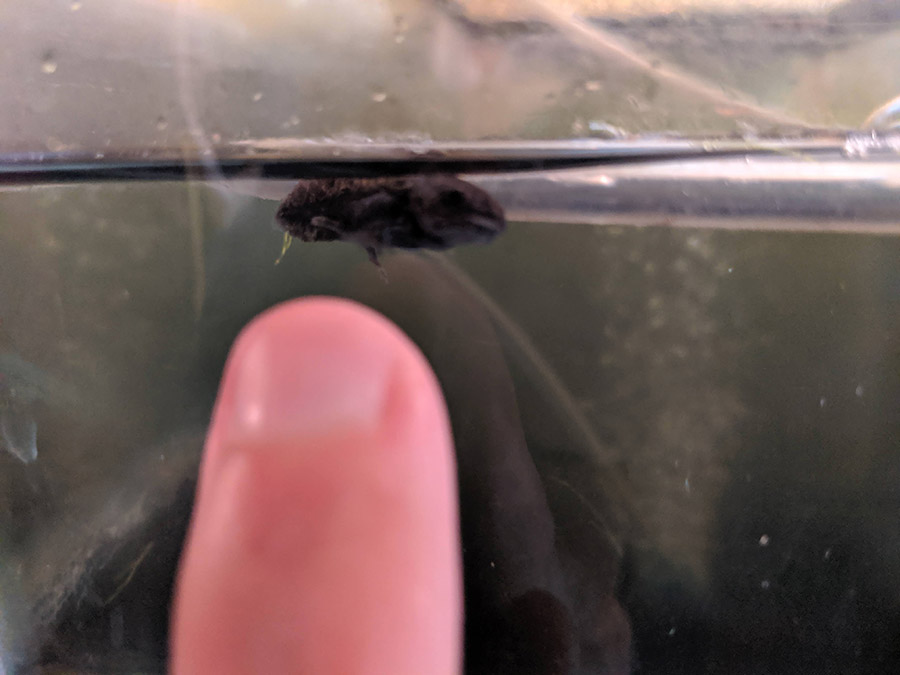
Wow. Talk about fulfilling my childhood dream. I’d somehow found Axolotl Disneyland! Thanks Martin. I made a large donation to Michael’s breeding efforts and walked away completely satisfied. Among the roster of ambitious trips I have planned for this year, it was hard for a brief jaunt through Central America to not seem like an also-ran compared to Egypt, Tibet, Antarctica and Chernobyl. But then this magic alchemy happened and I’d just had one of the best days of my life. On day two of the trip, no less.
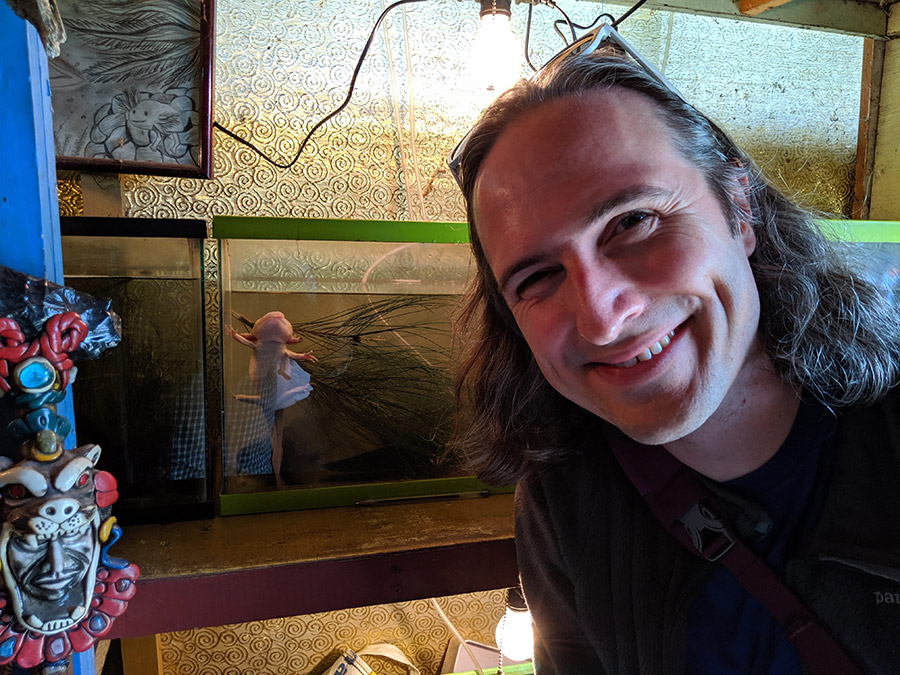
The canals of Xochimilco have one more attraction on offer, if axolotls and drunk boating aren’t your cup of té. It’s Isla de las Muñecas, the Island of Dolls.
It is not for the faint of heart.
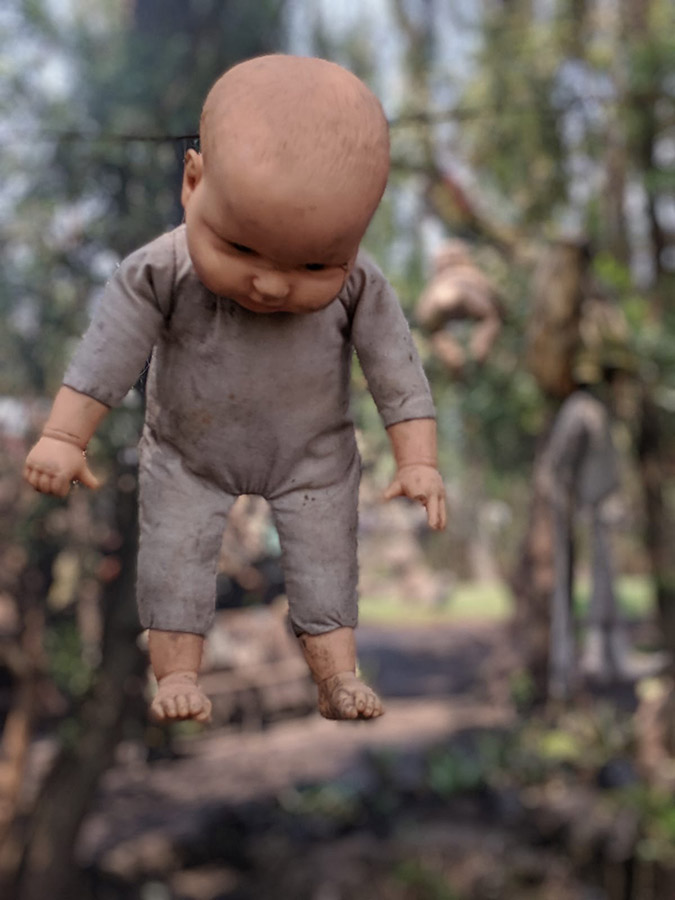
The legend of this chinampa is that a girl became entangled in the water lilies and drowned here while visiting the island in the 1950s. The owner of the land, Don Julián Santana, began to be tormented by what he believed was the girl’s ghost. He found the girl’s doll floating in the canal, which he put on display in hopes of appeasing her spirit.
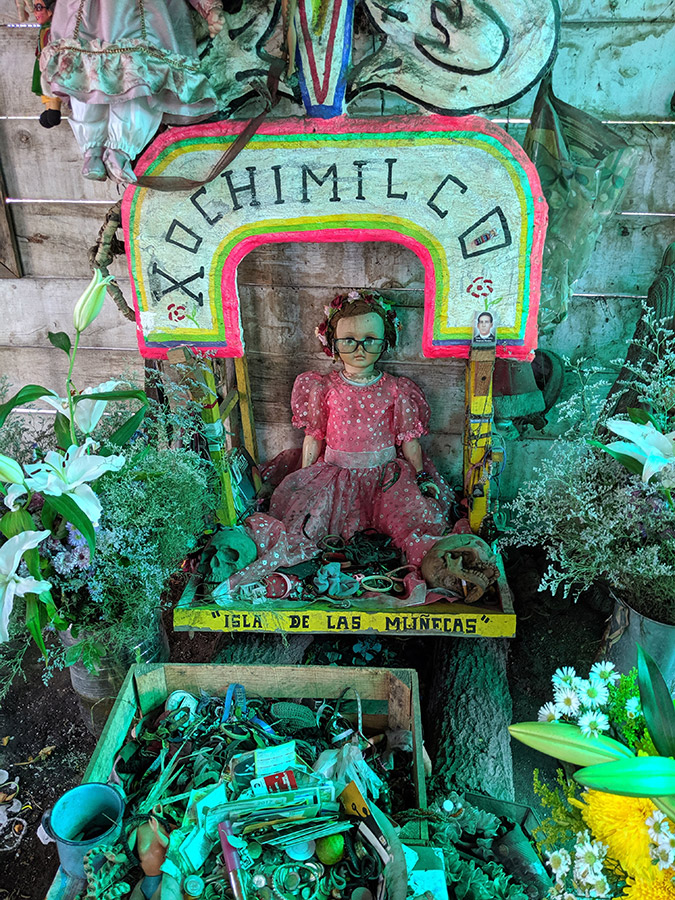
When this didn’t work and the ghost continued to haunt him, he started collecting the creepiest dolls he could fish out of the canal or the trash and began hanging them from trees in an attempt to scare the girl away.
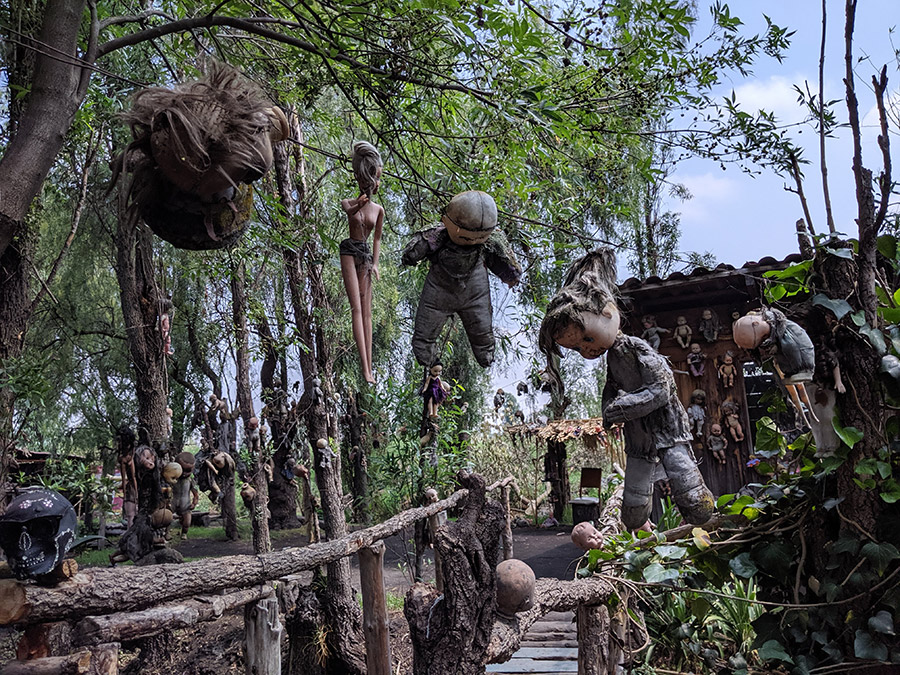
Eventually this kind of got out of hand... if hanging up the first doll to bargain with a child ghost wasn’t out of hand from the beginning. Now, hundreds of dirty, cobwebbed dolls carpet every available surface on the island.
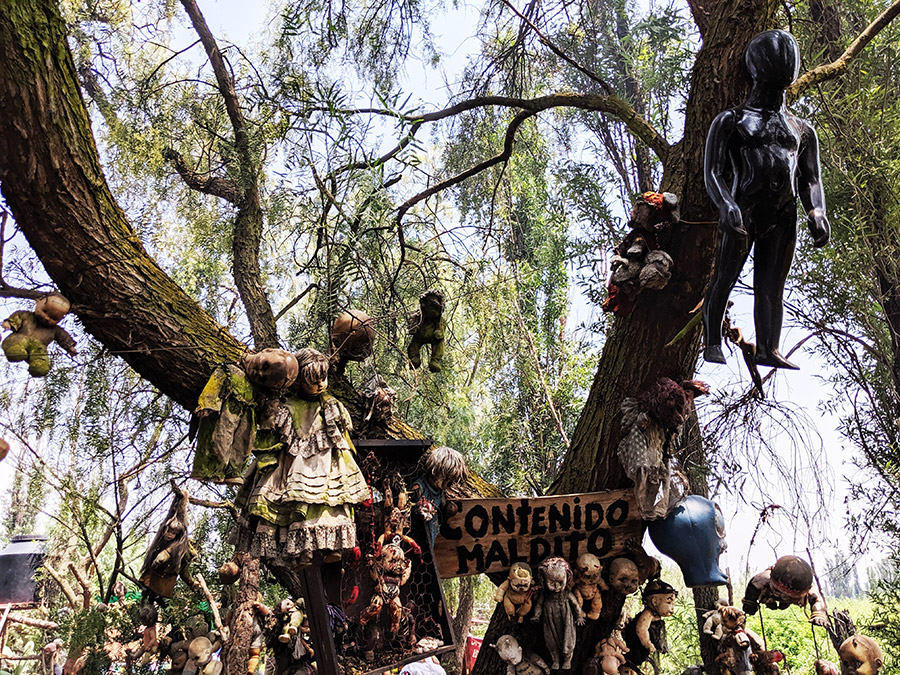
I think everyone has something they’re irrationally afraid of. Clowns, small harmless spiders, Mexican people. For me it’s always been dolls. I think this probably started when I was a kid, seeing the movie Poltergeist at far too young of an age, especially the scene where the little boy is strangled under his bed by his clown doll. It’s reasonable to ask why this fear transferred to dolls and not clowns, but I don’t have an answer to this.
It may be that the phobia is genetic, as my sister shares the same fear, and she wasn’t born yet when Poltergeist came out. I still laugh when I remember talking her into visiting the haunted house at Universal Studios with me, and she agreed on the sole condition that there wouldn’t be any scary dolls inside. Sure. I mean, what are the chances of that? Of course, moments later we walked into a dark room that, once the lights flickered on, turned to to be covered wall to wall in hundreds of Chucky dolls. She will probably forgive me one day when we’re old.
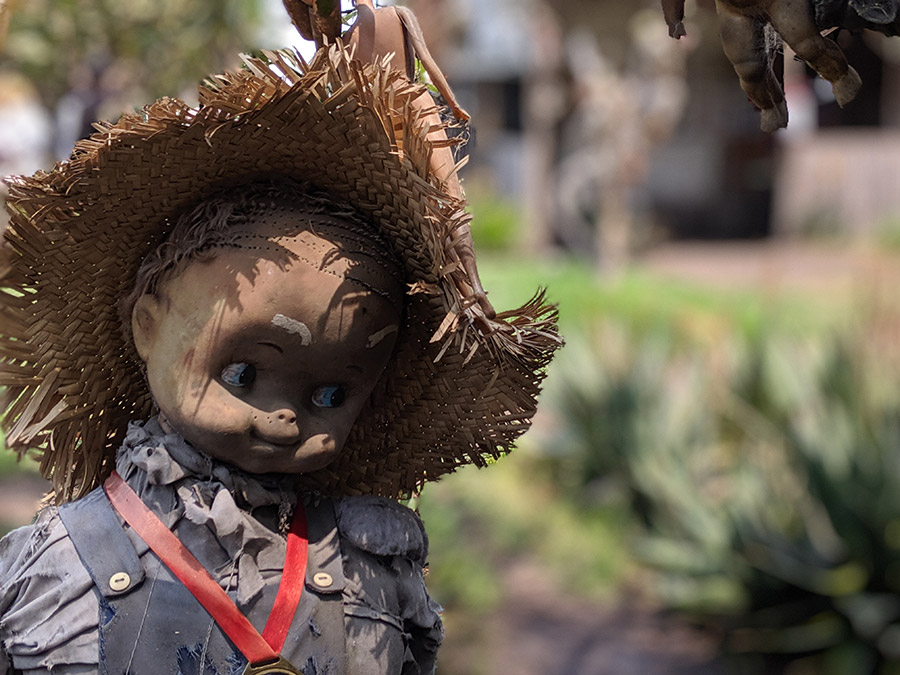
The quickest way to freak me out as a kid was to introduce a ventriloquist’s dummy into any situation, as these are obviously the scariest of all dolls. My deep love of televised Twilight Zone marathons during my childhood was always a roulette-wheel proposition, weighing the joy against the likelihood that the cursed ventriloquist dummy episodes The Dummy or Caesar and Me would come up randomly during the marathon and ruin my month.
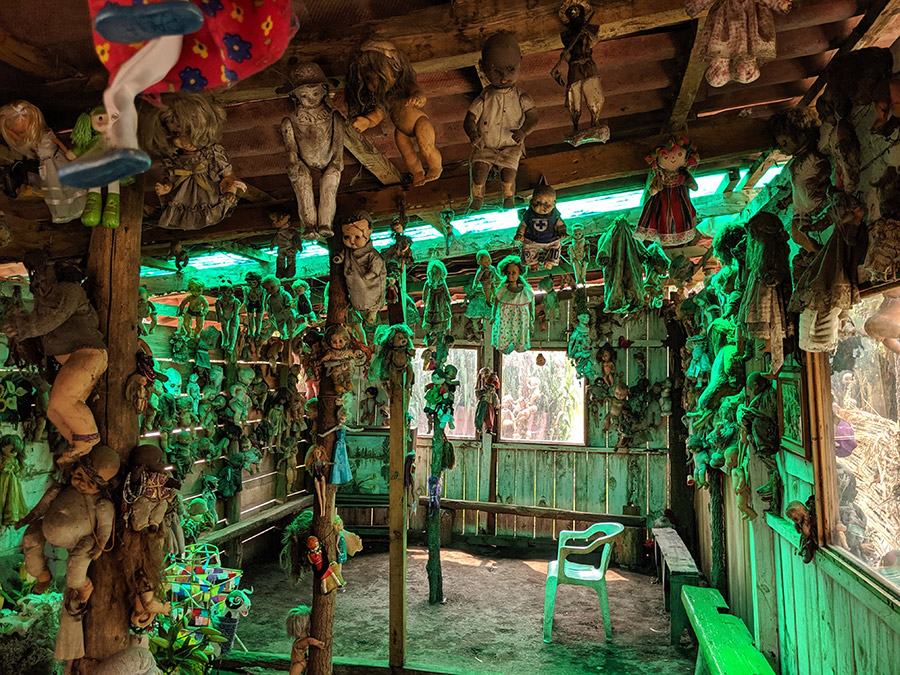
This issue is well-known enough in my family that when we were watching The Conjuring, everyone laughed out loud during the scene when the Anabelle doll suddenly disappears from a display case in the background, all knowing that this was going to fuck my shit up.
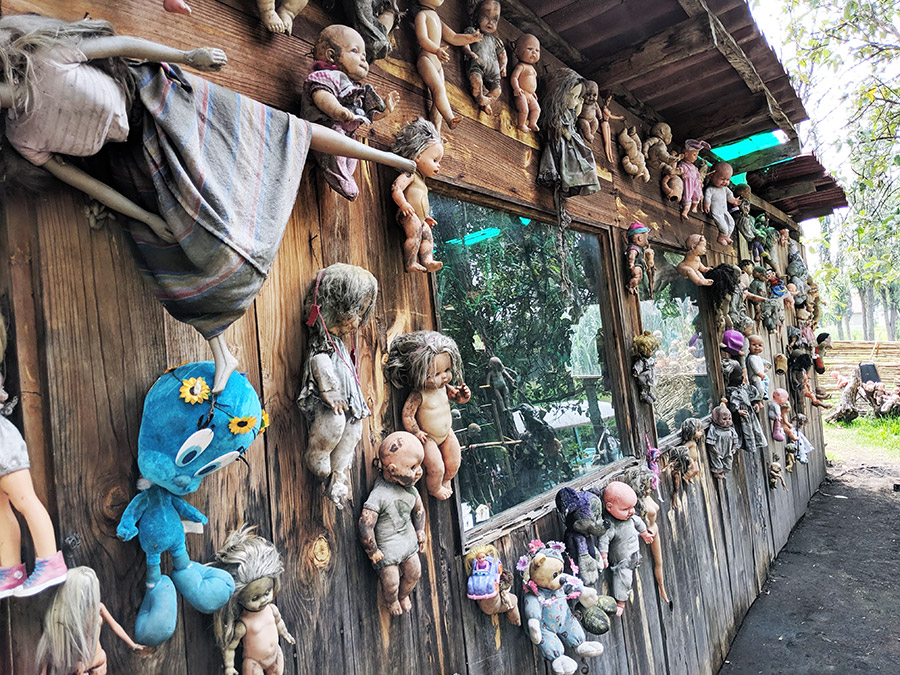
Standing on the Isla de las Muñecas, I chuckled to myself. Travel for me is largely about confronting your fears and growing into a new person. I just never expected this particular fear to come up.
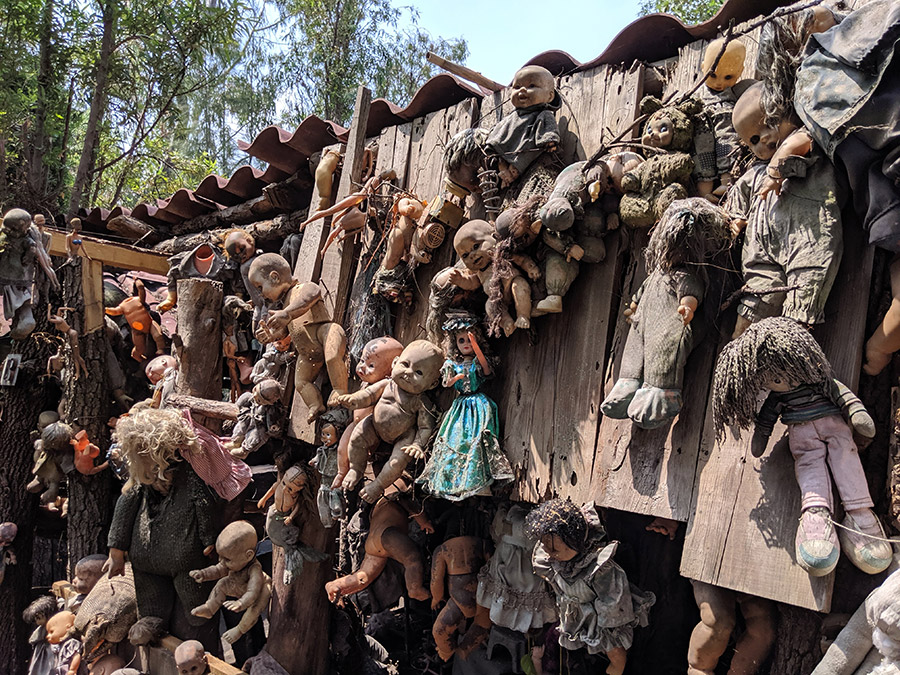
Thankfully, and semi-anticlimactically, in the end it was fine. It probably helped that I didn’t see any ghosts while I was there, and it was the middle of the day. I think Martin was more freaked out by the dolls than I was. I mean, if I open my closet to find that one of them followed me home I’m totally going to shit my pants, but barring that I’m fine.
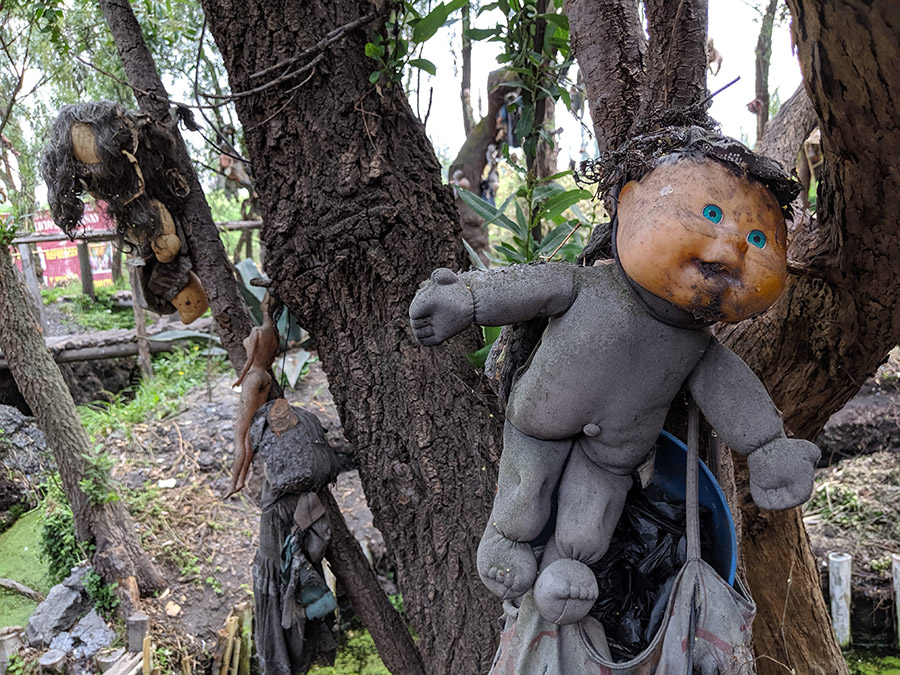
At least one of the dolls failed completely in its mission to be terrifying.
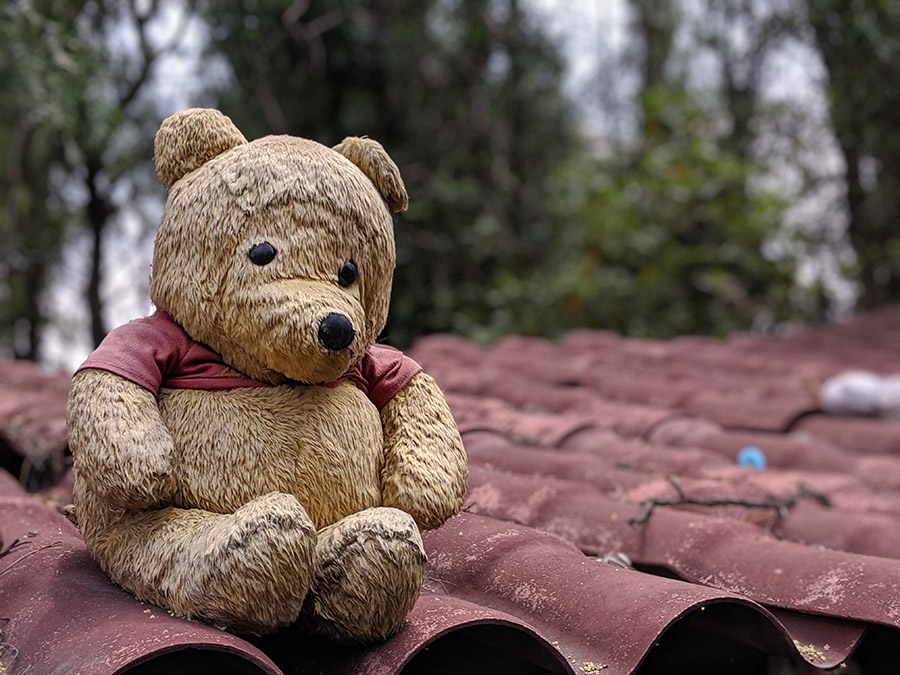
Nice try, Pooh.
As we were leaving, a dog that seemed to somehow be living on the Isla de las Muñecas tried very hard to get into our boat and leave with us. Can you blame him?
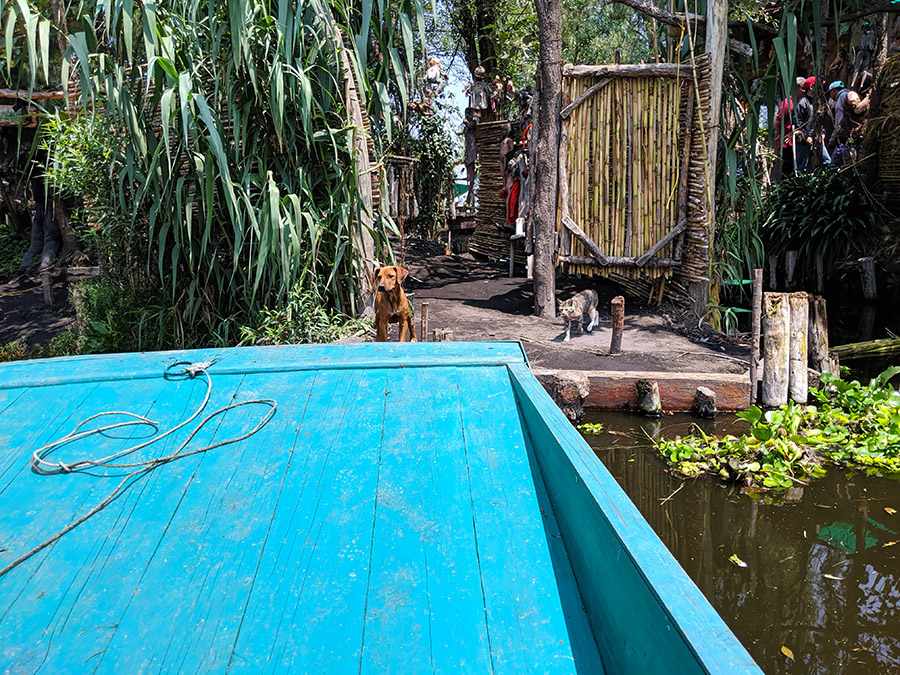
“Where did you go? Chicken Pizza?“
Yes, the highest ceremonial center of the ancient Mayan people was named Chicken Pizza.
No, it's Chichen Itza, silly. That's Mayan for a flat pastry covered in bird meat- no I'm kidding again. It means the mouth of the well of the wizard's water. So yes, I visited Wizard Toilet, Mexico.
The highlight of Wizard Toilet is El Castillo (“the castle”) a huge and beautifully preserved pyramid that’s 98 feet high and 100% likely to be the stepped pyramid you’ve seen if you’ve seen a picture of a stepped pyramid.
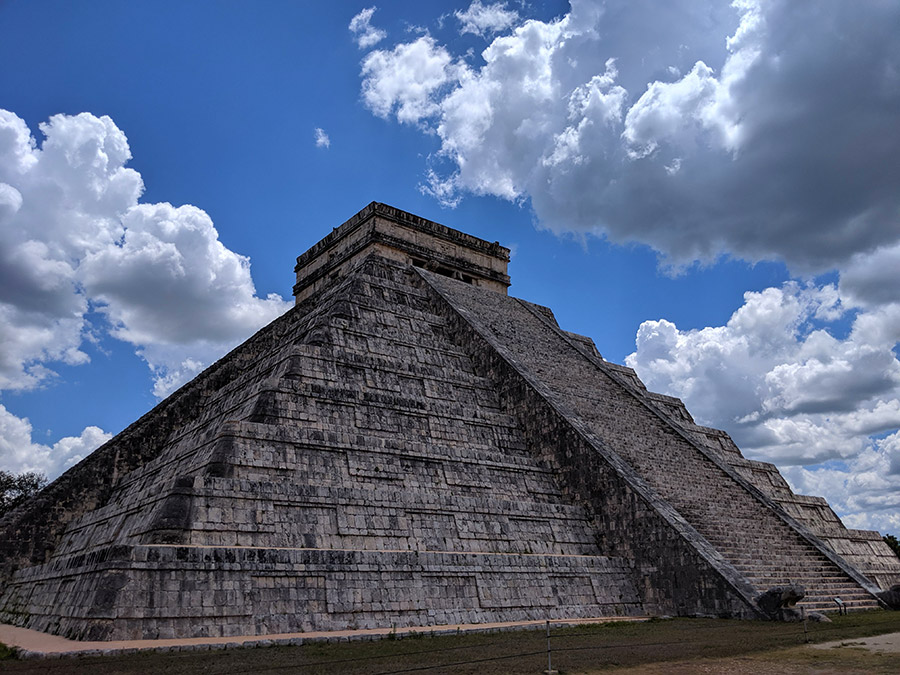
No, you can’t climb up there. You used to be able to but then somebody fell down the stairs and died just to ruin it for everybody.
El Castillo has a few tricks up its sleeve. One, is that at the equinox, the setting sun shining on the steps of the pyramid casts the shadow of the feathered serpent Kukulkan descending from the temple up top. You just kind of have to imagine this if you’re not there on the equinox.
The other trick can be experienced at any time, and is impossible to avoid because everyone is busy experiencing it. If you stand in front of the main staircase going up to the top of the pyramid and clap your hands, a bizarre echo barks back at you, reportedly sounding like the call of the Quetzal bird.
The best thing about this trick is that you have to be standing in front of the staircase to hear the echo, so the whole rest of the day you’re just watching a bunch of idiots clapping at nothing for no reason because you can’t hear the echo they’re responding to. I gradually figured out why they were clapping, but still thought it was made-up tour guide bullshit until I walked over to the stairs myself out of boredom, and clapped.
Chirp! Chirp! Chirp! I’ll be damned! It does sound like a bird. Coincidence, or were the Mayans really, really into finding offbeat ways to replicate bird sounds?
Two things were not evident about Chichen Itza from advance planning, one good and one bad. The negative side is that this place is bonkers touristy, and you have to walk a gauntlet of tchotchke vendors to get anywhere, all day long. But on the positive side, there are iguanas. Lots and lots of awesome iguanas.
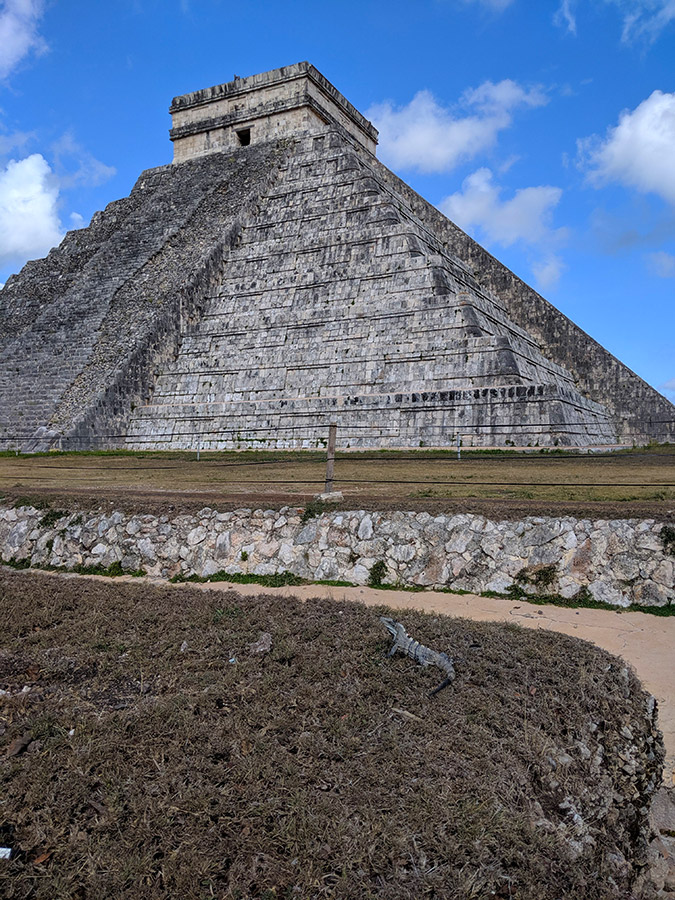
Although not an advertised feature of the site, I quickly fell in love with the iguanas. On a walk through the woods I spotted one resting near the base of a tree. I had found the rare spot in Chichen Itza not thronged with people, and I stood as still as I could, tuning into the iguana and sending feelings of love and appreciation his way. Slowly, ever so slowly, he transitioned from eyeballing me with suspicion to walking over and sitting at my feet. We stayed there for a long while, him looking up at me and me sending my appreciation down at him, until a French family tromped through the path and scared him away.
At the other end of the site, I stumbled across this huge, magnificent iguana.
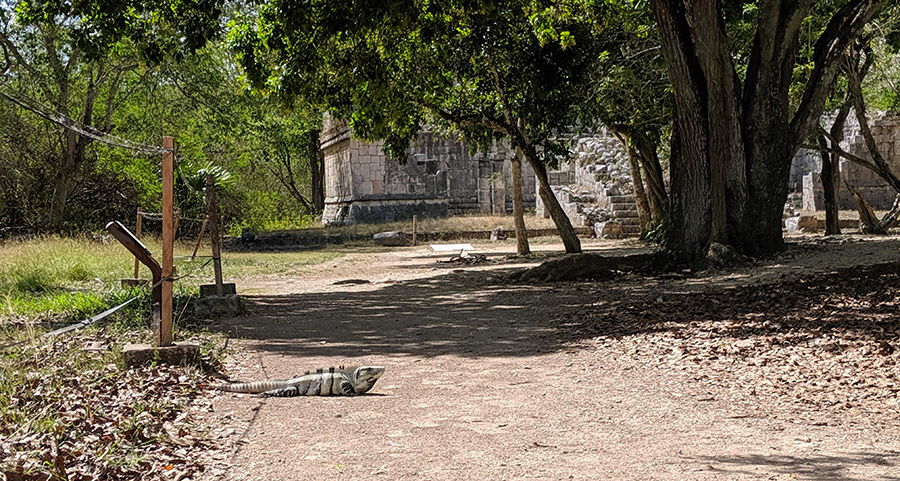
I immediately sat down on the trail so as not to scare him away. He greeted me with a series of push-ups and head nods, which can either be a territorial display or just a way for iguanas to say hello. He eventually settled down and we sat together for a long while.
“You’ve got some karma with that iguana!” a tourist called out as he walked by, either tuning in to the connection forming or just letting me know I was weird for sitting with an iguana.
Continuing the theme of my favorite things being the things that are totally incidental to the intended attractions, the clouds at a Chichen Itza that day were absolutely breathtaking.
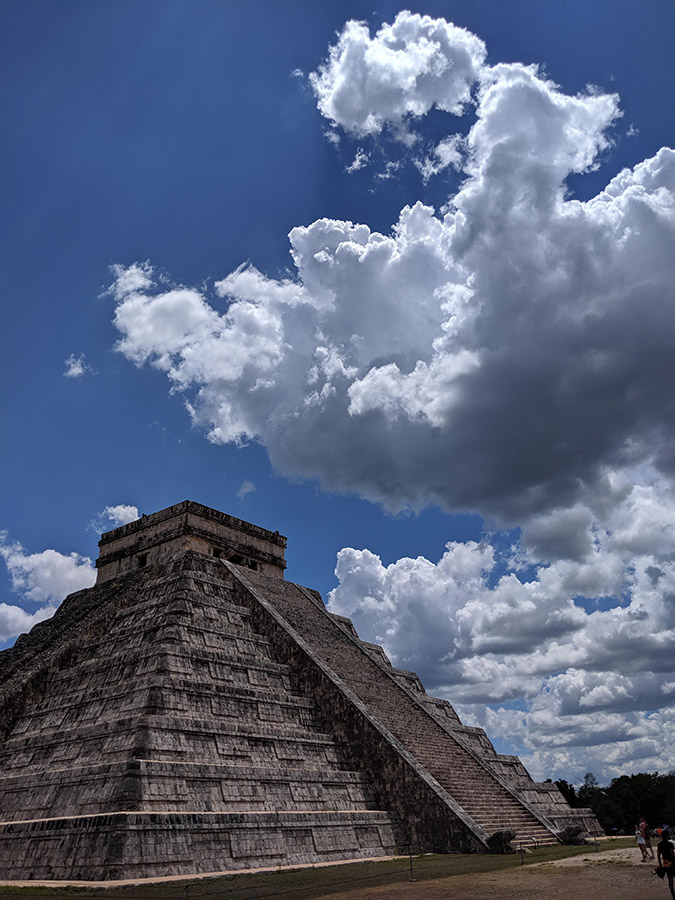
No less impressive was the guy practicing Capoeira (Brazilian breakdance fighting) in front of El Castillo. 99.99% of the people who come to Chichen Itza show up, take a selfie in front of El Castillo, then spend a half hour hectoring strangers to help them make 100 failed attempts at getting an awesome photo of them jumping awkwardly one inch off the ground in front of El Castillo, and then they go home. This guy was at least doing some crazy shit and filming it all by himself.
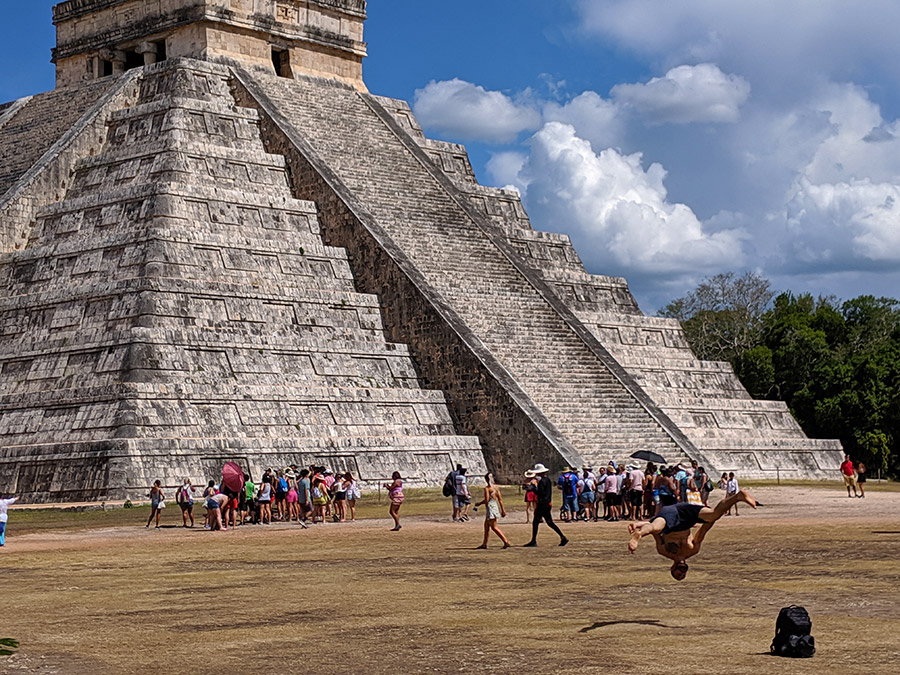
Chichen Itza is a strange site in that it reminds me a little of the Eiffel Tower in Paris. The Eiffel Tower is a bit of a one-trick pony and isn’t really that fun to visit, but you can’t really go to Paris and not see the Eiffel Tower, can you? Chichen Itza is kind of a big touristy mess but it has El Castillo, which is pretty much the single most magnificent thing from the ancient Mesoamerican world that you’re going to see. So you kind of have to see it, don’t you?
Not that there’s nothing else to see at the site. Near El Castillo you have the ballcourt.
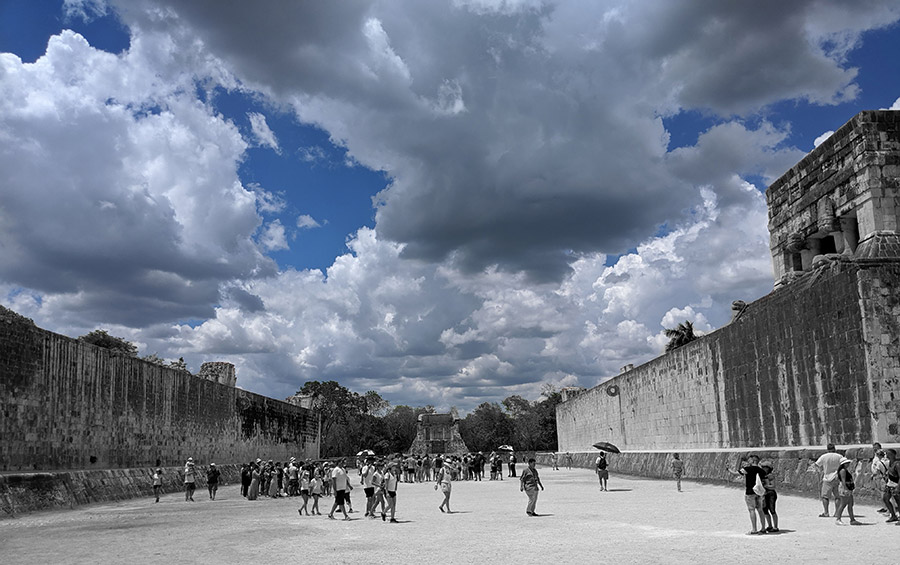
Every big Mayan site has a ballcourt, none of which honestly look like very much but are interesting when you understand the symbolic importance of this game in Mayan life. I had visited several of these and talked to a lot of people before I learned that in the game, the rubber ball (which may or may not have had a human skull at its center) represents the sun, and the stone rings it is thrown through in the game represent the sun moving through the underworld each night, giving the game a ritual spiritual significance that connected to the harvest and the very survival of the people.
What catches most people’s eye is that the game ended in a human sacrifice. What no one can seem to agree upon is whether it was the captain of the losing team, or of the winning team, who was decapitated. Some believe it was considered a great honor and the teams were competing to be the one selected for such a holy purpose.
Of course, that perspective might have depended on how religious you were. If the winner is the one who dies, I could imagine some players kind of dragging their feet and playing poorly because they’re not ready to be honored like that yet. And some of the Mayan art depicting human sacrifice shows the honorees with their hands bound, seeming to indicate they weren’t too excited to be involved.
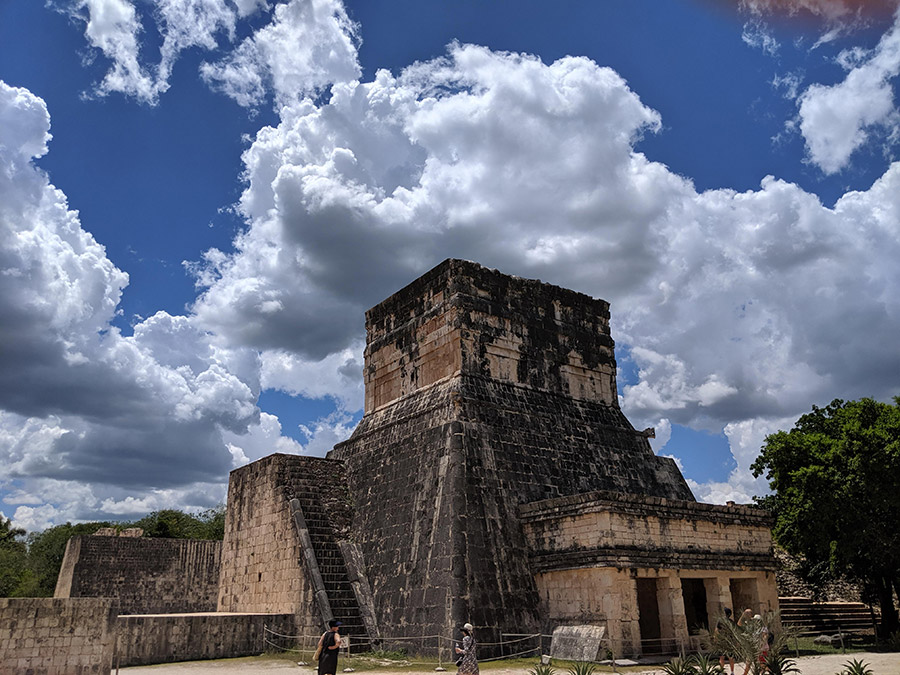
But if the captain of the losing team was the one who lost his head, it’s no longer an honor, so is this a game you’d even be volunteering to play in? Those are some awfully high stakes. So the debate continues.
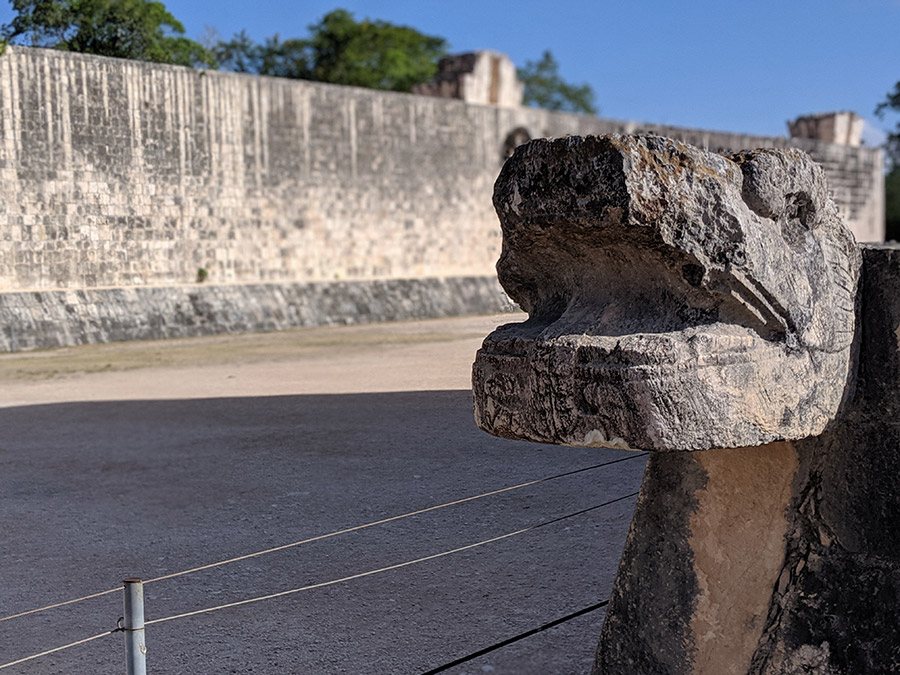
One of the odd features of the ball court is that if you stand in the center, between the stone hoops, you can clap and hear the sound echo back seven times. Much like the Quetzal echo, you wonder if this was intended as a reflection of the seven spiritual realms or just a acoustical coincidence of how the ball court was built?
On the other side of the huge courtyard you have the Plaza of a Thousand Columns, which is pretty much exactly what it sounds like.

From there you can wander on various paths through the jungle, passing various temples and the iguanas sunning themselves luxuriously on the steps of the Tomb of the High Priest.
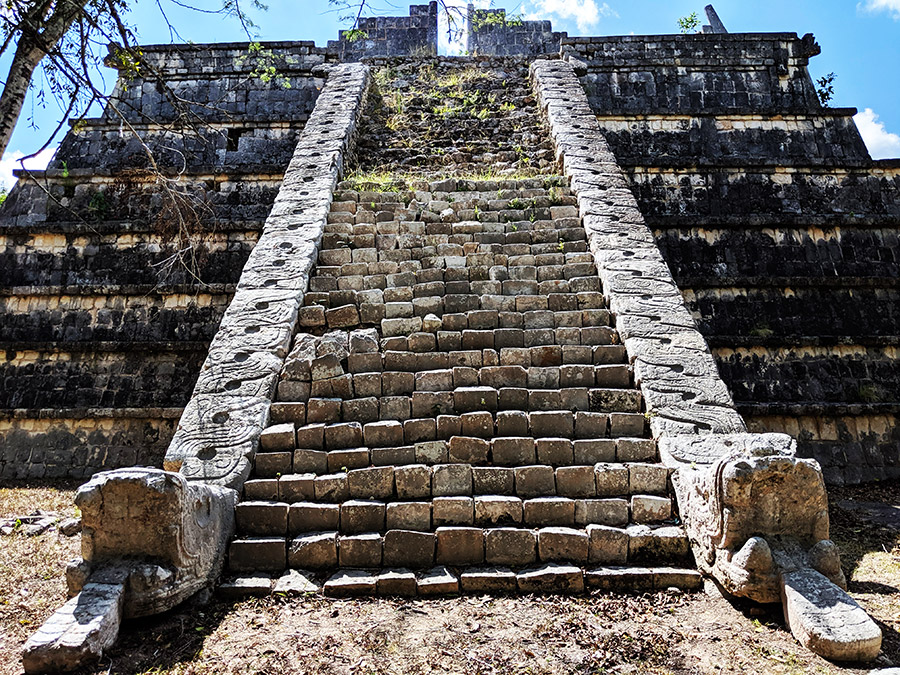
At one far end of the complex you have the Observatory, El Caracol. The domed structure is aligned with the motion of Venus, which was considered by the Maya to be the God of War. The planet’s position was used to plan dates for battles. You’d think this would make sneak attacks difficult since Venus is famous for not being able to keep her mouth shut.
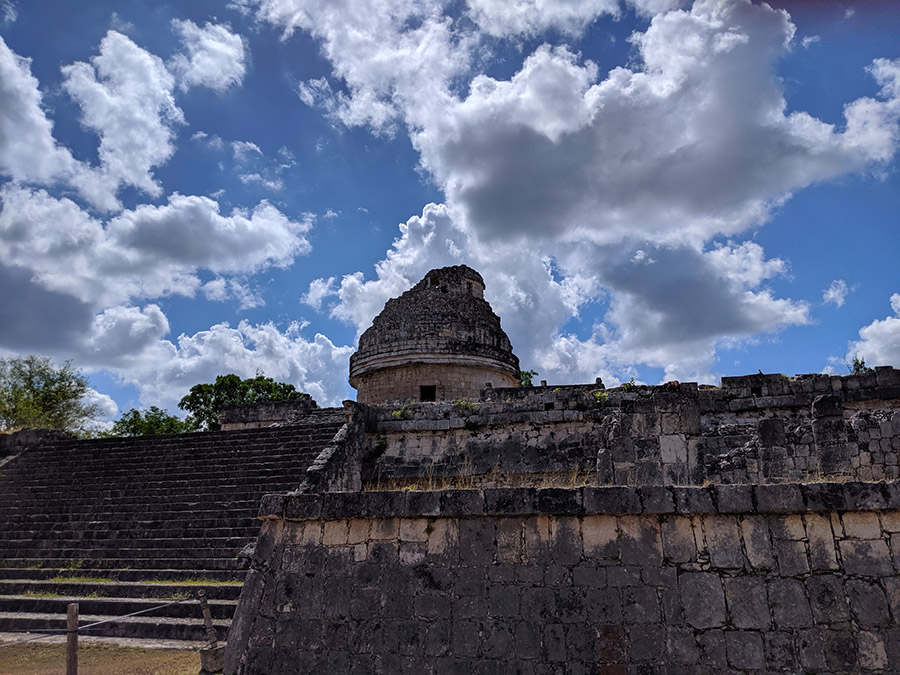
Nearby are the ruins of the Nunnery, which I mostly found interesting for the huge vultures swirling above it.
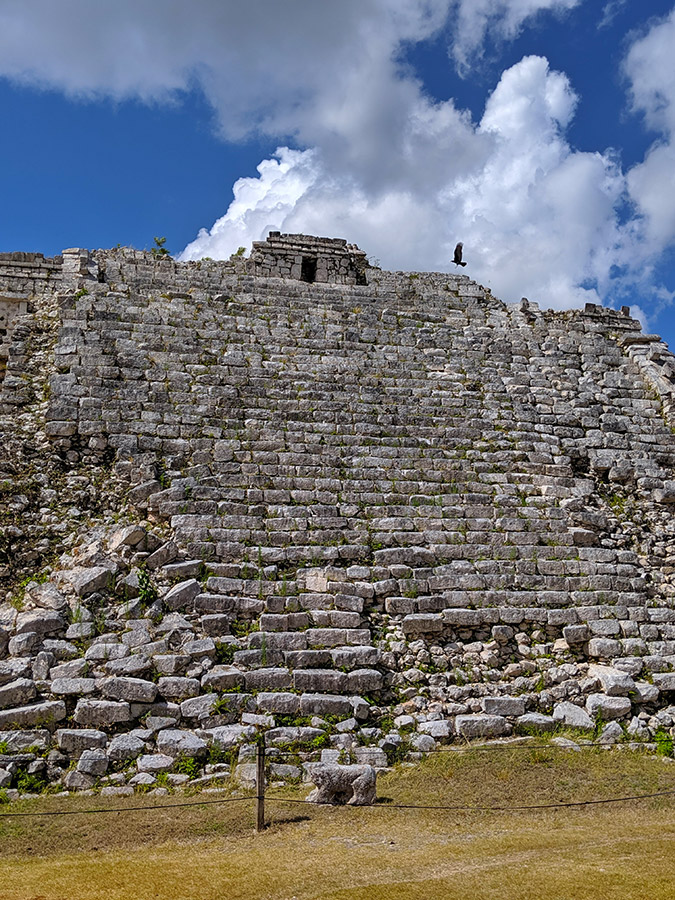
At the far opposite end of the complex is Cenote Sagrado, a sacred pool formed in the collapsed bedrock of limestone north of the complex. Ceremonies were done on the edges of the cenote, where during times of drought, animal and human sacrifices were cast down into the waters in honor of the rain god Chaac. Modern excavations have dredged up the remains of hundreds of people from the waters. Only certain cenotes were used for this purpose, possibly because only some of these pools were thought to lead to the underworld.
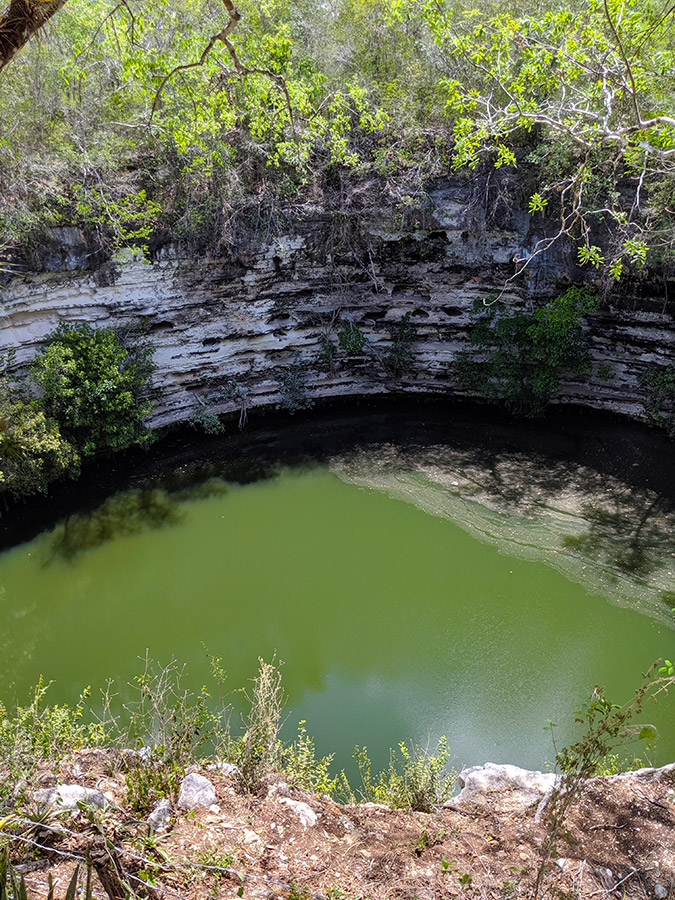
Strangely, scans have found that a cenote like this exists directly underneath the El Castillo pyramid, something researchers think the Mayans did on purpose. Tapping into the spiritual qualities of water, perhaps?
Every third tchotchke dealer at every tourist site in Mexico is selling a Jaguar whistle, a clay device that when blown into, loudly makes the sound of a jaguar screaming. When played right, they do sound an awful lot like the real thing, so these are extremely popular among eight-year-old boys. This is a bit unnerving when walking through the jungle in a strange country, as you’ll be walking along and JESUS FUCK A JAGUAR- wait no just another idiot with a souvenir whistle. Eventually you become conditioned to ignore this otherwise-alarming sound. I remain convinced that this life will end for me one day when I blow off the sound of an actual jaguar to my doom, having become overly conditioned to the mating call of the Central American tourist.
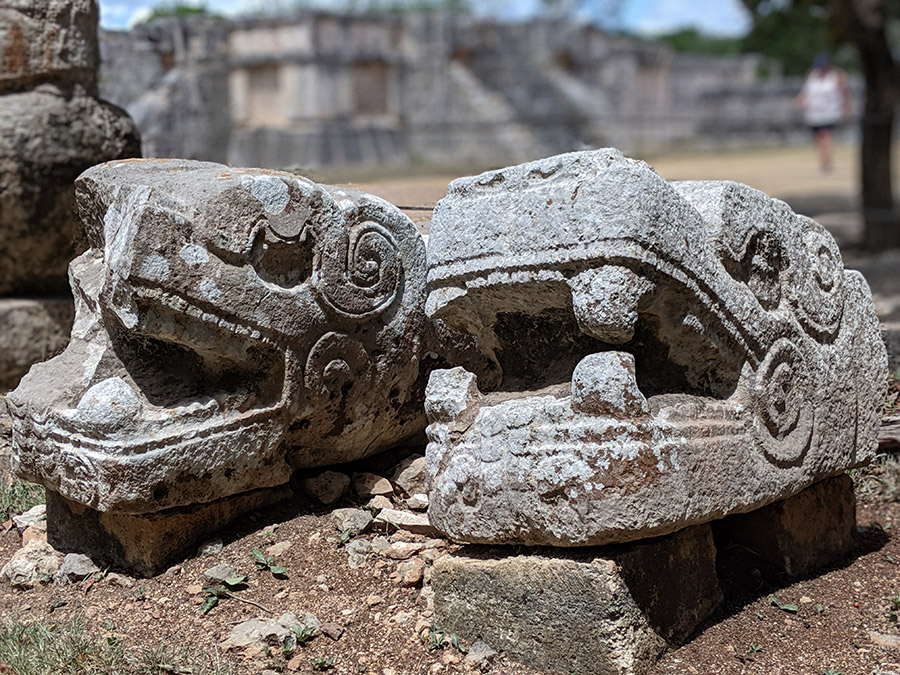
One highlight of Chichen Itza was when the baking heat of the day was suddenly broken by an absolute downpour of rain, drenching everyone present. There’s nowhere at all to go, so it was fun to watch the selfies suddenly stop and everyone scramble around briefly before realizing this wetness thing was just going to happen.
This trip taught me every quirk of the Mexican bus system, like the cops (?) who would stop the bus, get on, and briefly film everyone present, before wordlessly leaving. This happened on every bus I rode, and I can only guess it was to collect evidence for later use in case bad shit went down on that bus. I wasn’t sure whether I found this comforting or not.
The bus from Chichen Itza back to Merida featured the bonus of a very loud TV playing some movie where Anne Hathaway turns into Godzilla in Spanish, with no option to mute this entertainment, which greatly decreases your odds of not having very weird bus dreams.
Back in Merida I was picked up by a friendly, very chatty Uber driver. I’m so sorry dude. If you want to hear about the apples I ate I’ve got you covered, otherwise this is going to to be a rough conversation. Whatever progress I’d made on my Spanish last year in South and Central America was being seriously set back by the Mexican accent, which is generally laid-back in pronunciation beyond my ability to decipher.
Other Uber drivers I ended up with in Mexico seemed to like texting me a lot. Rapidly. In Spanish. While I’m trying to cross the street. “Hey! You’re at the bus station? Can I pick you up somewhere else? What restaurant are you going to? What kind of music do you like?” Dude, the whole reason I'm hailing an Uber instead of a taxi is because I can’t even say the address right!
I don't usually post pictures of my food, but I was too amused by this sample platter of tacos from a fancy vegan restaurant in Merida not to share it:
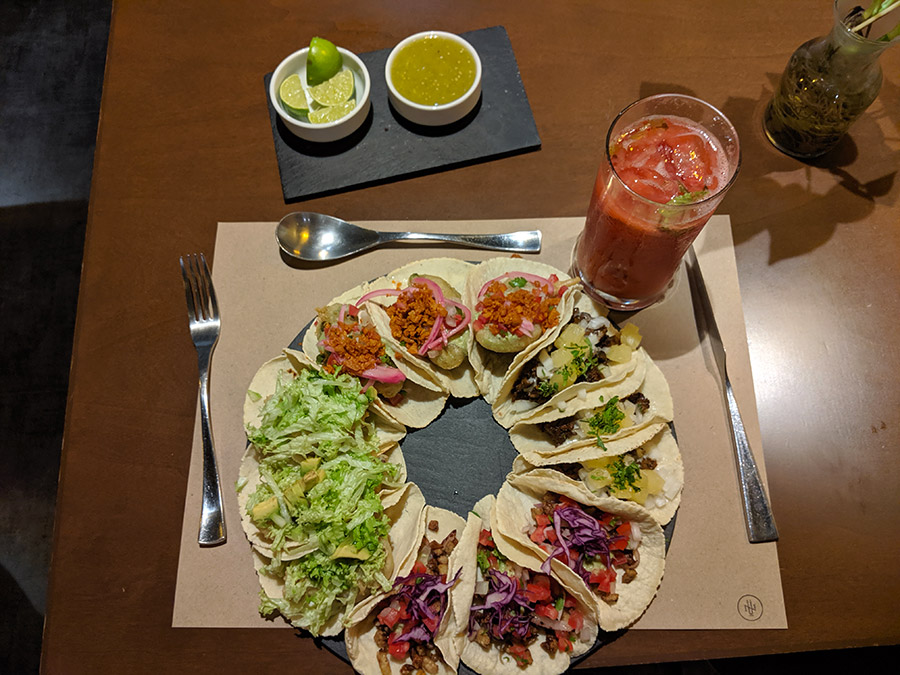
I loved receiving a quantity of tacos so excessive it seemed to imply the chef was pissed off at me.
All through the trip I was treating Mexico to Sean’s Spanish Greatest Hits, including such classics as thanking someone with a perfectly enunciated “Gracious!” But my absolute high point was feeling so confident as I left that restaurant in Merida that I declared to all assembled “I’m sorry!” on my way out the door, when I meant to say “See you later!” So sorry you’re going to be deprived of my company from this point forward, folks. My condolences. Don’t look so sad. You in the back, stop laughing.
The overnight bus chugged through the dark night, carrying me from Merida far down south to Palenque. The only thing slightly unnerving about this was that we stopped several times during the night in unannounced towns, so I kept waking up suddenly not being sure where I was or if I should be getting off the bus.
Because, of course, everyone knows that this is the bustling metropolis of Emiliano Zapata! Why even announce it? What the- Is this town named after shoes? Am I dreaming? I alternated between being paranoid that I’d sleep through the Palenque stop and being deeply, deeply “drop everything and wake up with your head almost on the floor” asleep. The Mexican teen sitting next to me rocked Michael Jackson on his headphones contentedly all through the night.
As I was sitting in the bus station in Palenque town the following morning, having somehow managed to get off the bus in the right place, a large cockroach aggressively and spasmodically ran across the tile floor and attempted to hide underneath my bag. After briefly considering my options, I got up and moved to another seat. The locals looked over at me sadly, their eyes saying “Aye, no señor! You must stand your ground against la cucaracha! Don't back down or they will own us all!”
Palenque is, in many ways, the antidote for Chichen Itza. Much less well-known, it draws people seeking a deeper experience than the tour buses from Cancun that empty out into Chichen Itza daily. It’s kind of a pain in the ass to get to, but that is really a virtue when your goals are more spiritual and less selfie-based.
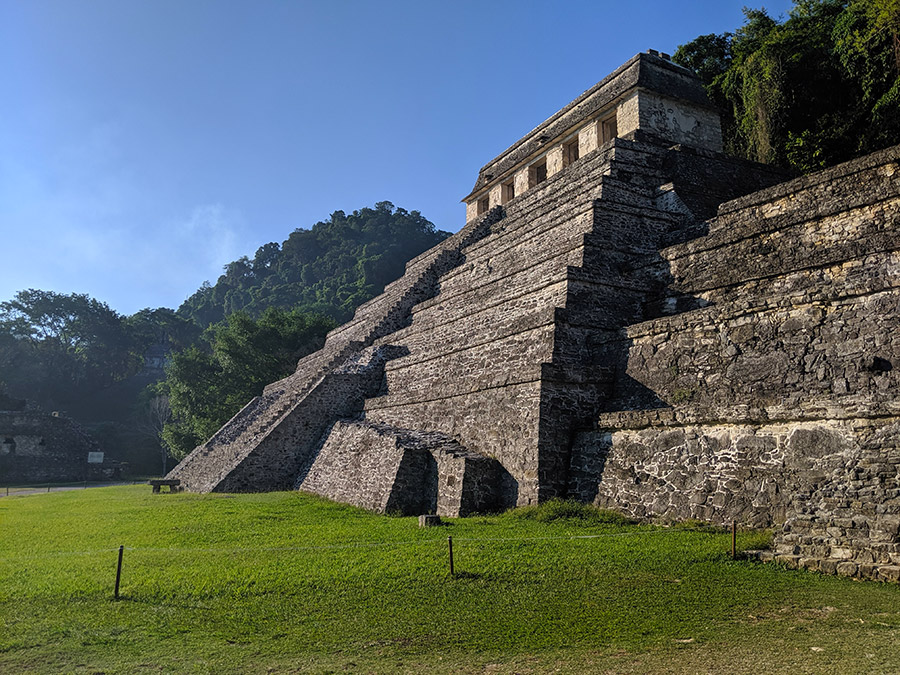
Palenque is more interwoven into the jungle and though it does feature some impressive buildings, it was the vibe of the entire site I was the most impressed by. My favorite memories of Palenque are of sitting underneath a tree in the park area near the ball court, enjoying the shade and the breeze blowing through the beautiful trees. More of a hang-out vibe than a rush from site to site.
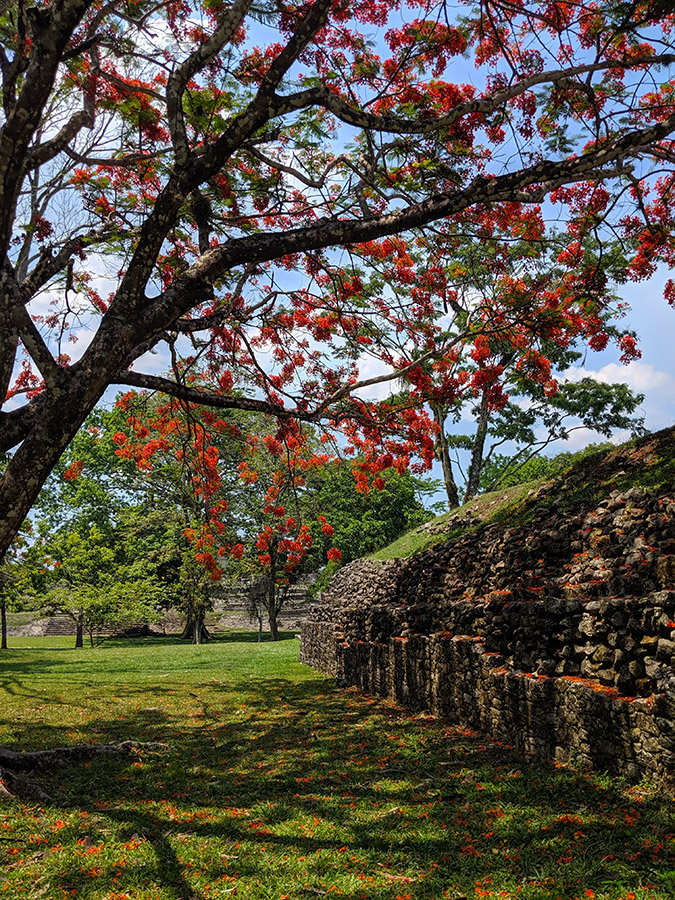
I was messaging with my friend Patricia when I mentioned that I was in Palenque.
“Oh, you’re in one of my favorite places! I’m sure your crystal skull is happy to be back in Palenque.”
Yeeeeeah. That’s right, I remember now that Patricia had brought all of her skulls, including the one I’m now the custodian of, to Palenque years ago for a ceremony with the Mayan elders. Neat to think it had been here before.
Only it wasn’t with me now.
I had briefly thought about bringing the skull, but irreplaceable + easily damaged + heavy is not a great combination for a backpacking journey rambling across the hostel landscape of Central America via hitchhiking and chicken bus. Oh well, she’ll never know. I mean, until I write about it in my blog. Whoops.
I thought about this for a minute. I’d practically fallen out of my chair the first time I saw a photo of my crystal skull, so I was obviously tuning into it remotely. Why can’t I do that now?
I closed my eyes and held an image of the skull in my mind. Immediately, my head began to buzz. The vibration carried down my spine and spread intensely throughout my whole body, until I felt myself phasing into some different reality. Whoa. I held things there, enjoying the experience but also concerned about what would happen if I suddenly just passed out cold while alone in a foreign country. After a few minutes, I came back down to Earth.
So. I have a remote-control crystal skull. Good to know.
The centerpiece of Palenque is the Temple of the Inscriptions, which you used to be able to climb up the stairs and go inside to see the breathtaking inscriptions, but is now closed to the public. I imagined the person who fell off of Chichen Itza dusting themselves off and then falling off of the Temple of the Inscriptions in their pratfall tour of the Americas. This is a little like going to Disneyland and finding out that Space Mountain is closed, but I’m an adult and I only cried about this for a few minutes before consoling myself with an ice cream.
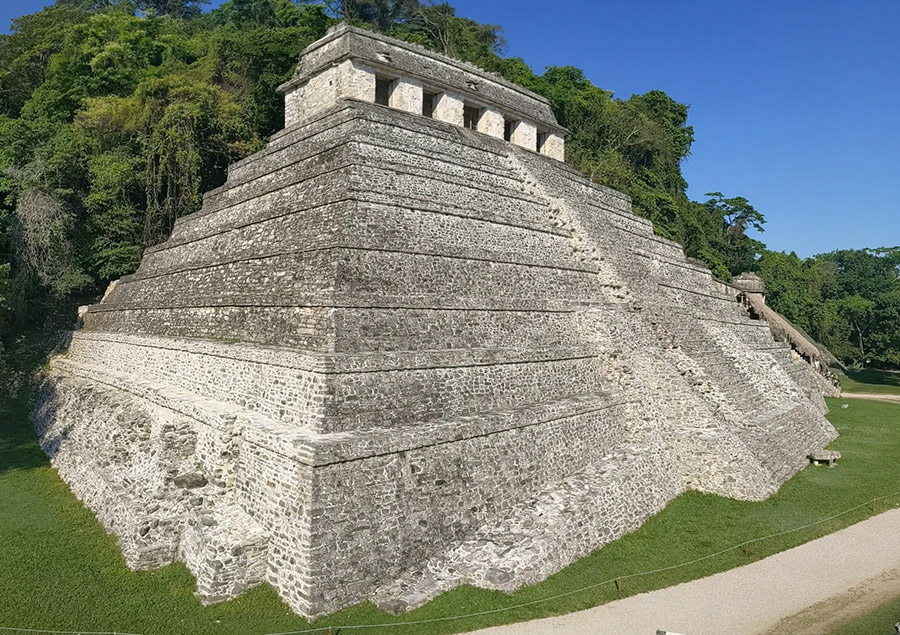
The main attraction being off-limits, my favorite building on the site turned out to be the Temple of the Cross, a tall step pyramid at the Eastern end of the complex.
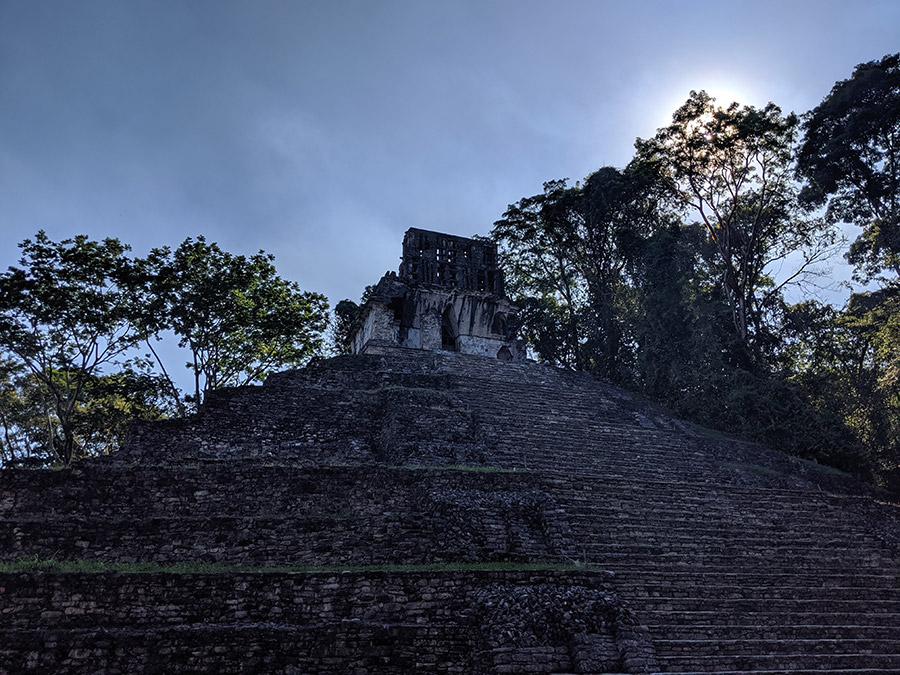
Though a bitch to climb, sitting at the top and taking in the view in the early morning light was one of my favorite moments in Palenque. The sounds of birds and monkeys filled the trees below me, and the strangely European-looking observation tower of the palace was visible in the distance.
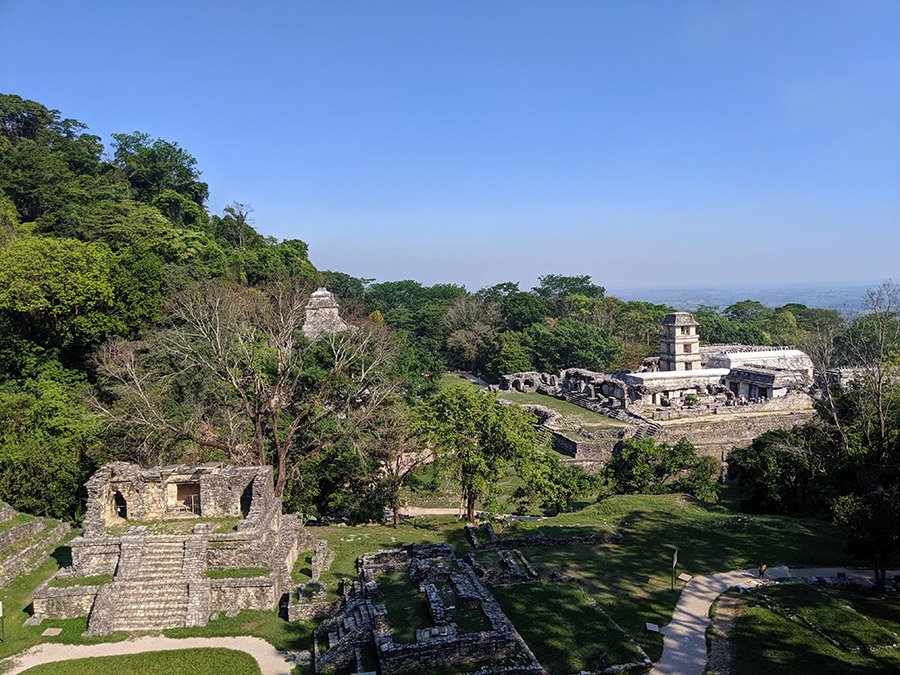
Later in the afternoon, I was resting nearby when a young woman walked up and asked if I had climbed the Temple of the Cross. I said yes. Is it worth it? Oh yeah, totally. “Shit,” she said. “Thanks for nothing,” she scowled as she stomped off to drag her tired ass up the many, many steps.
The temple of the cross creates a cross shape with Temple XIV and the Temple of the Foliated Cross to the south.
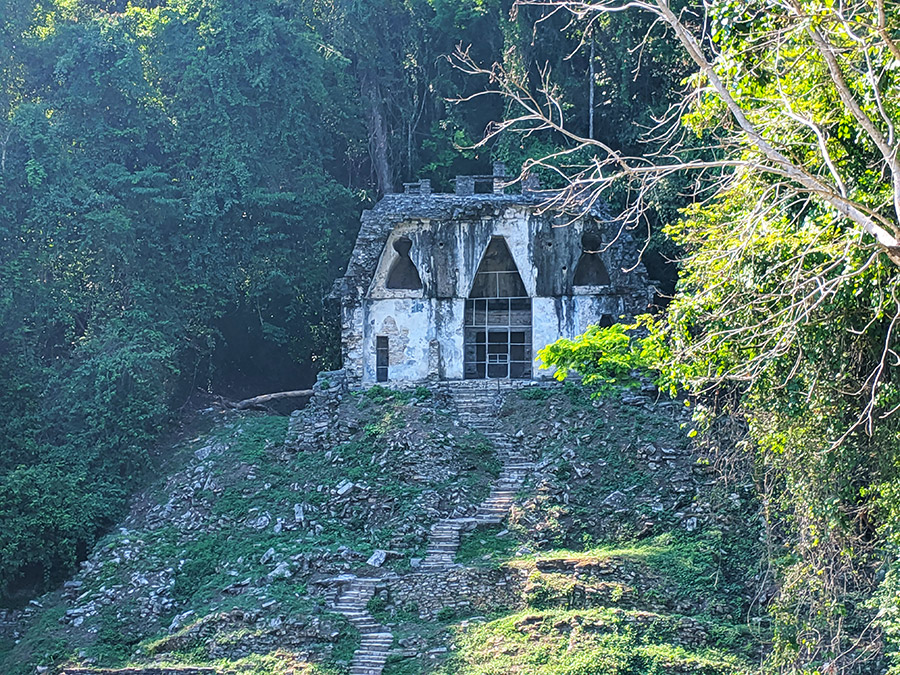
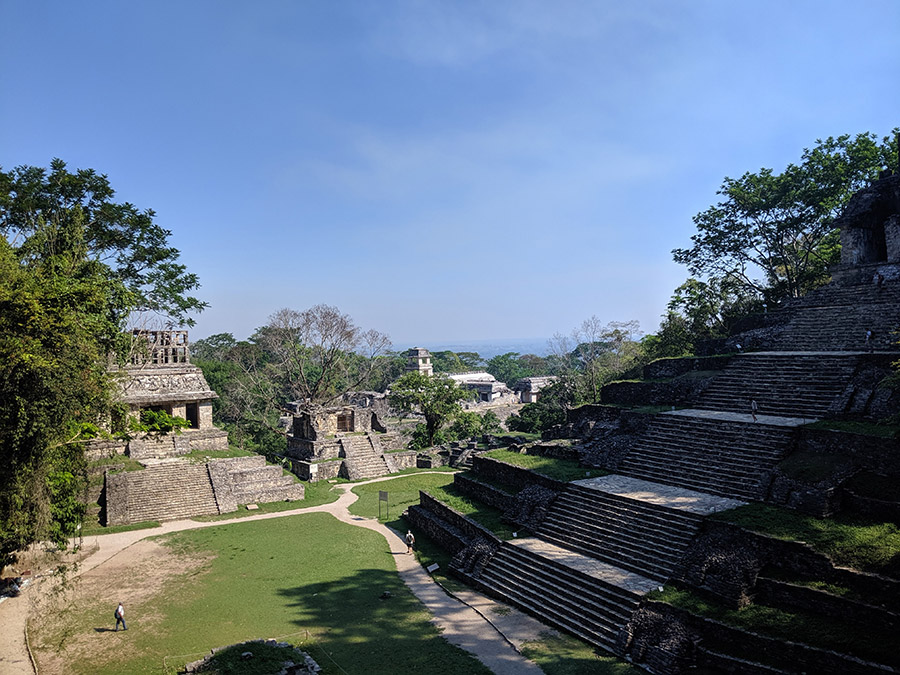
The physical centerpiece of Palenque is the Palace, a large walled complex full of strange narrow corridors and staircases that were a lot of fun to explore.
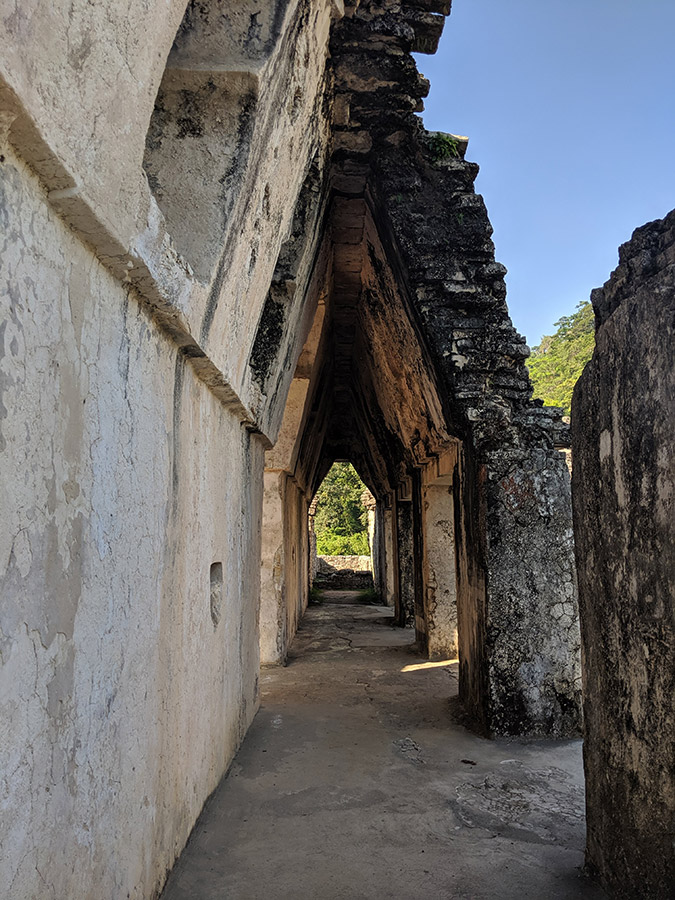
One repeating motif was the strange T-shaped windows in all the walls.
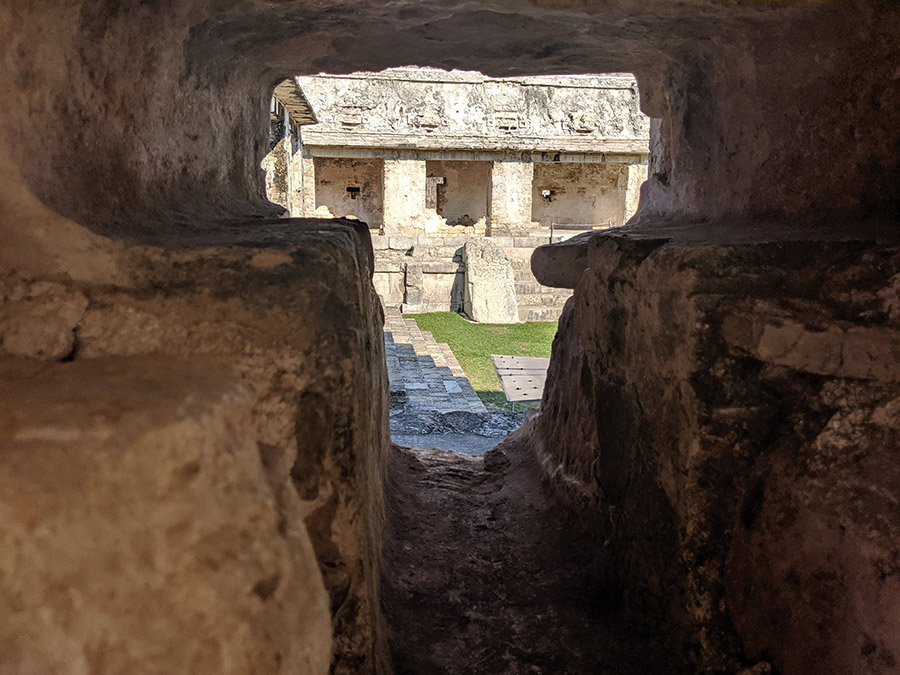
A central courtyard featured carved reliefs showing all the captured nobles of opposing kingdoms who had been brought to this very spot to be laughed at by the king before being sacrificed. Sort of reverse Post Office wanted posters, I guess.
I was greatly amused by the warning signs posted around the Palace.

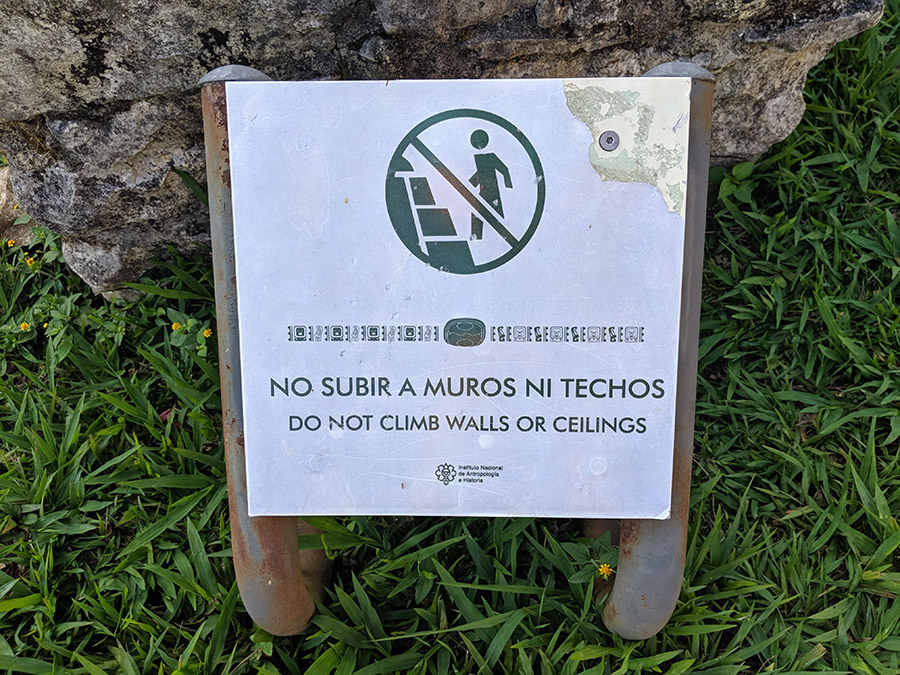
Next to the Temple of the Inscriptions sits Temple XIII, which contains the Tomb of the Red Queen. A narrow hallway leads you inside.
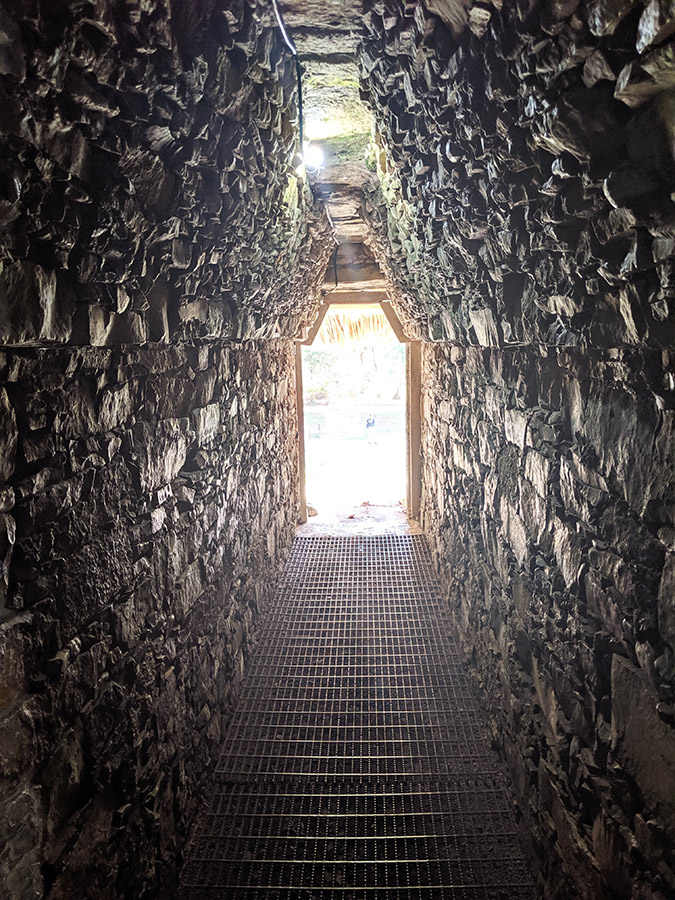
Inside the tomb chamber, the sarcophagus sits with the lid ajar, the red insides still visible. Lady Tz’akbu Ajaw became known to archeologists as the Red Queen because in addition to the malachite funerary mask and jade jewelry she was wearing, her body was completely covered in bright red and highly poisonous cinnabar dust made from grinding up mercury ore.
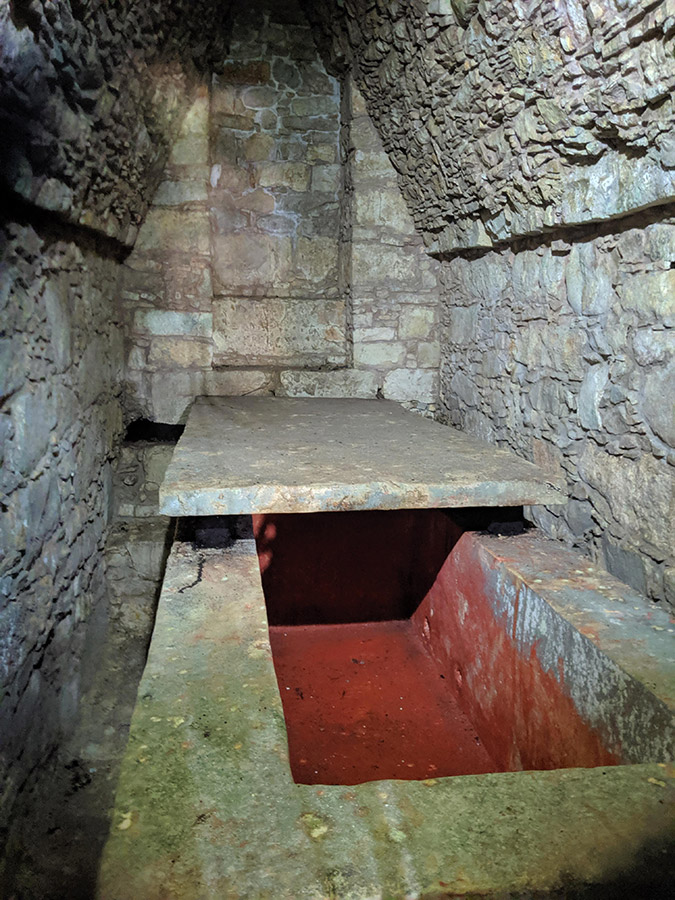
I was amused that the “Temple of the Count” got its name from French explorer Jean-Frédéric Waldeck staying in this structure when he was exploring the area in the 1800s. Waldeck appears to have invented the part about him being a Count, and is a rather hilarious character, since the published drawings he produced of Palenque and other Mayan sites included Egyptian-style pyramids, elephants and anything else he considered to be an improvement.
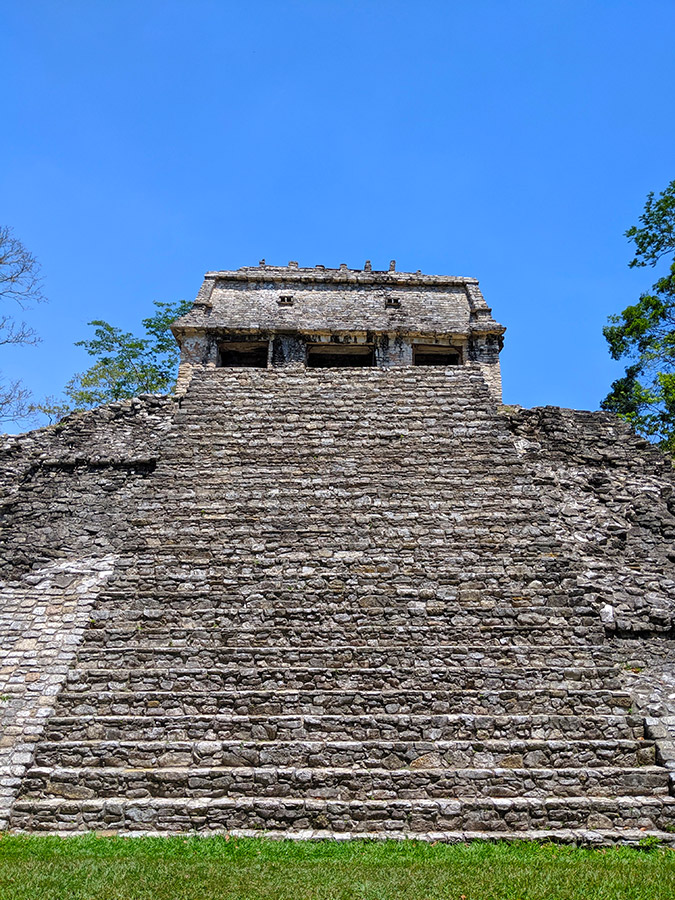
The walk from the main site of Palenque to the off-side museum is a feature in and of itself, the long journey taking you through the jungle and down hundreds of feet of elevation, crossing streams and passing the ruins of where the common people of Palenque lived.
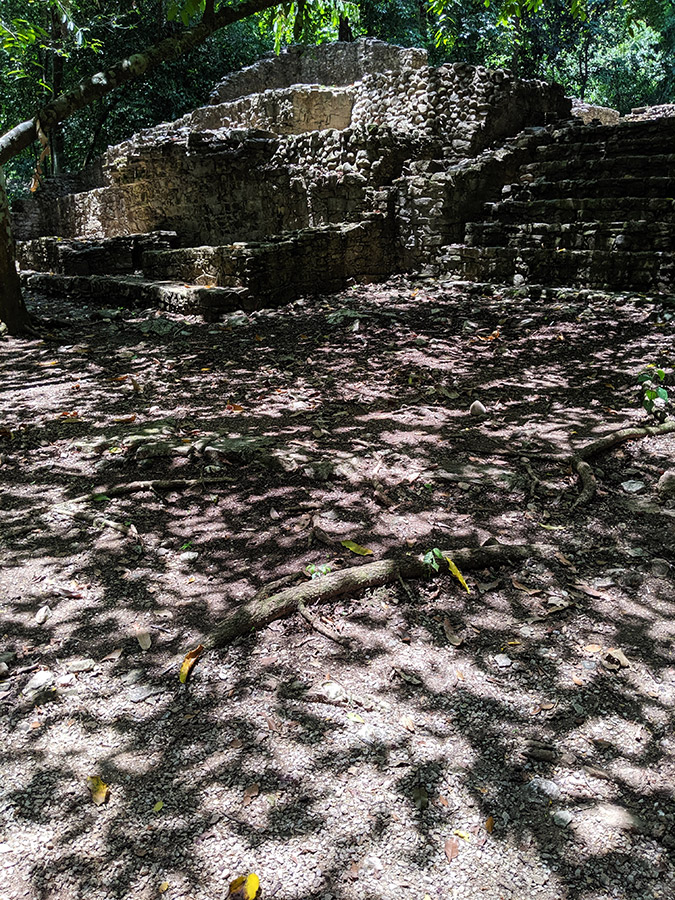
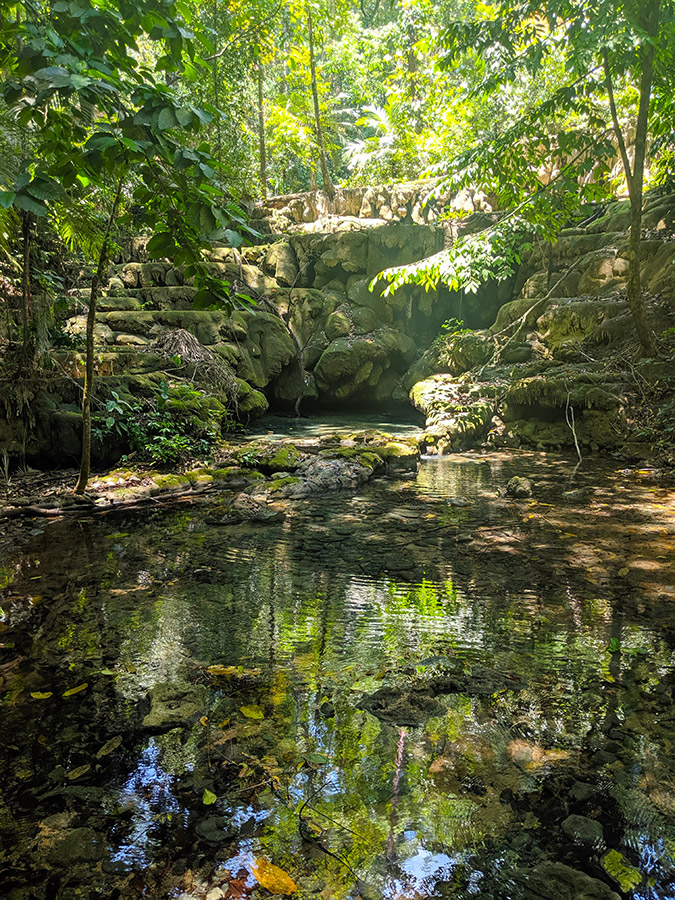
The highlight of the museum is the room dedicated to King Pakal’s royal tomb, including his massive and ornately carved sarcophagus. The sarcophagus is presented behind layers of Plexiglas as if it’s Hannibal Lecter and is in danger of suddenly springing forward to eat your face. Which, after looking closely at the crazy art carved all over it, actually seems possible.
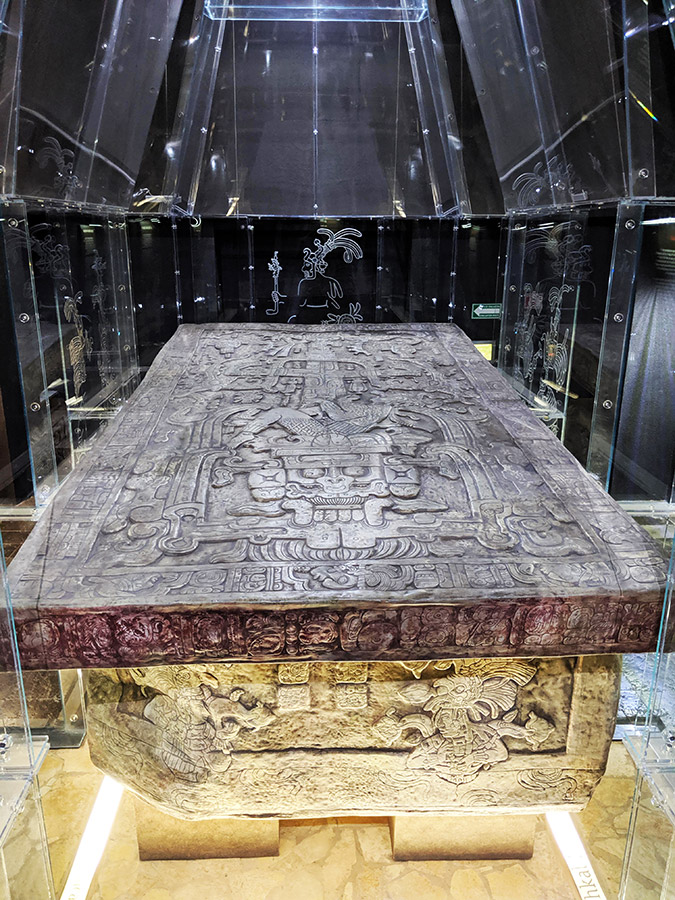
Also amazing was this carving topped by a bird with a whole lot of attitude, as he’s flipping double birds at anyone and everyone who might mistakenly think this bird has any fucks left to give.

There are many carved reliefs inside the museum, the most interesting of which to me was this one of the king of Palenque making offerings to some kind of underworld corn monster. Symbolic, or another sign of bizarre ET connections in the ancient world?
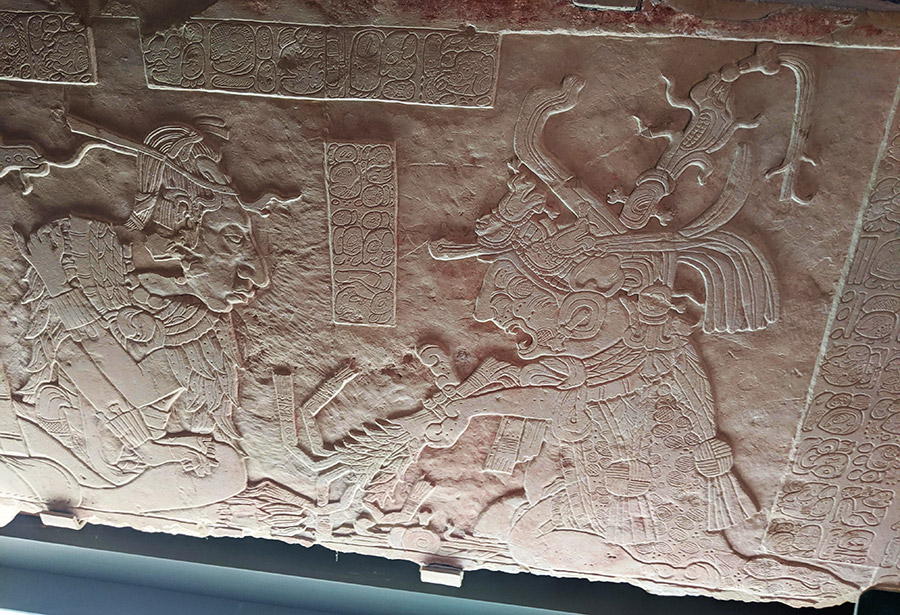
Leaving Palenque after a very full day, I headed for El Panchan, which is less of a town and more of a motley assortment of cabins in the middle of the jungle. My planning for this trip had a few spots in the itinerary where I just drew a little guy shrugging, because there’s shit like this where you can’t book online and have to just show up in the jungle and hope all the cabins aren’t full.
I had a brief scare in that no one was there when I arrived, but I eventually ran into someone who probably worked there and she got me set up with a cabin. The cabin’s most outstanding feature was a hole in the door that allowed you to look into the adjoining cabin. Was this… accidental? I peeked through the hole, half expecting to see David Duchovny in his speedos. No one was staying there so I decided not to worry about it too much.
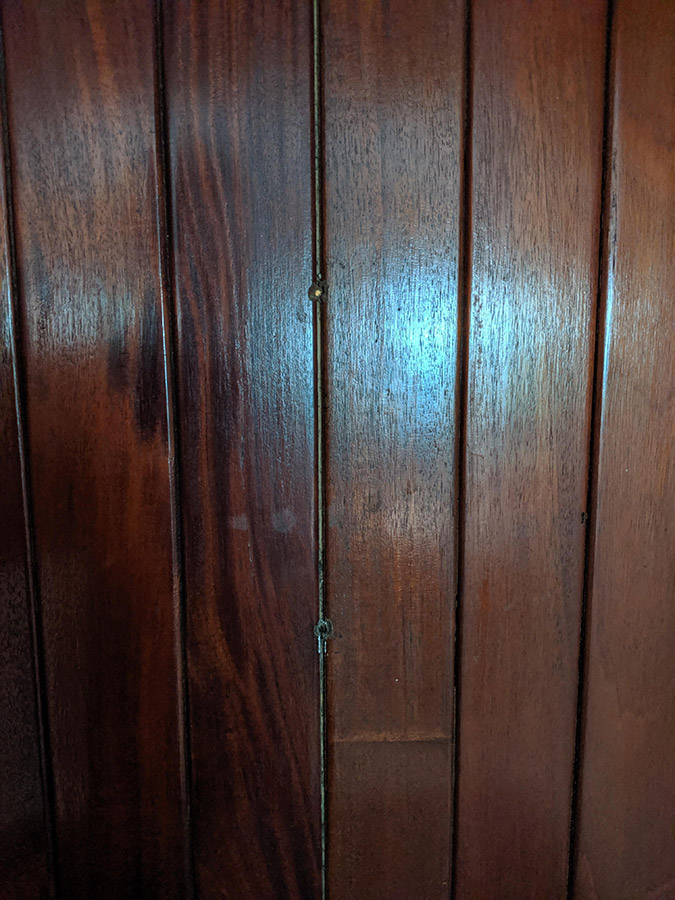
I’d bought a new phone before this trip, and after displaying the weather onscreen for the first few days I owned it, it suddenly and mysteriously stopped doing this for a few weeks. The weather info suddenly came back on when I was in the middle of the steamy jungle in Mexico.
“All right, all right. Now THIS is some weather. That's more like it.”
You’re so weird phone.
At some point that night I realized I was staying in the same jungle where the movie Predator was filmed. Apparently the waterfall that Arnold falls down wasn’t far from my cabin.
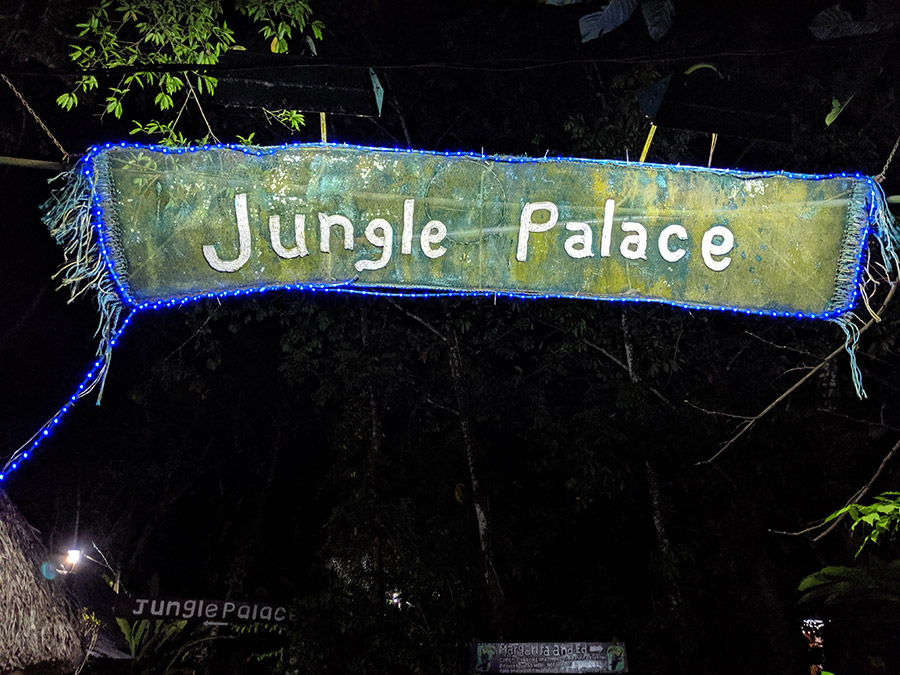
I embarked on a walk that night but after passing the Jungle Palace sign I found myself in the pitch black Mexican jungle with a lot of shit noisily moving through the underbrush all around me, and suddenly remembered that I had to be up early in the morning. Yeah.
Guatemala awaits.